


GARAMBA NATIONAL PARK, DEMOCRATIC REPUBLIC OF CONGO, APRIL 21 2019: Young Congolese conservation ranger Izako Vungunyesi is casevacked by helicopter after an incident with poachers inside the park. He was shot through the wrist and the AK 47 round also grazed his bicep. Two suspected south Sudanese elephants poachers were killed by his ranger group but not before they threw a grenade at the rangers, 4 poachers fled the scene and are being pursued by the Garamba authorities. Garamba has a very sophisticated GIS intelligence system which allows for some predictability in poacher movement. Two years previously 9 elephant were killed in this location. Today the rangers prevented a larger herd of 30-40 elephants from fired upon by these poachers, which would have led to a certain massacre. Garamba is a Park in North East DRC bordering South Sudan. It is one of Africa’s oldest and most complex parks, with a difficult history. It has for many years been an elephant poaching epicenter, with heavily armed Sudanese poachers and Lord’s Resistance Army militia’s both decimating elephant populations as well as targeting the local population. African Parks signed an MOU with the ICCN, Congo’s conservation authority, in 2005. Since then, a number of rangers have continued to die in the course of their duties but slowly the park has gained traction against local poachers and foreign armed groups. From 2016 law enforcement strategy has been completely overhauled, the rangers were better equipped and technology has become a vital component in the fight. Poaching of elephants was down 50% in 2017 and in the 2018 it was down further. Over 1200 elephants remain and over 40 of those have collars for monitoring purposes. Garamba is also home to some of the last remaining Kordofan giraffe population and there is an action plan for that population. In a region of almost no economic opportunity, Garamba employs almost 500 full time staff and almost 2000 short term contract workers. T

GARAMBA NATIONAL PARK, DEMOCRATIC REPUBLIC OF CONGO, APRIL 18TH 2019: ICCN conservation ranger Dog handlers receiving training on tracking and detection from Invictus K9 group. Garamba is a Park in North East DRC bordering South Sudan. It is one of Africa’s oldest and most complex parks, with a difficult history. It has for many years been an elephant poaching epicenter, with heavily armed Sudanese poachers and Lord’s Resistance Army militia’s both decimating elephant populations as well as targeting the local population. African Parks signed an MOU with the ICCN, Congo’s conservation authority, in 2005. Since then, a number of rangers have continued to die in the course of their duties but slowly the park has gained traction against local poachers and foreign armed groups. From 2016 law enforcement strategy has been completely overhauled, the rangers were better equipped and technology has become a vital component in the fight. Poaching of elephants was down 50% in 2017 and in the 2018 it was down further. Over 1200 elephants remain and over 40 of those have collars for monitoring purposes. Garamba is also home to some of the last remaining Kordofan giraffe population and there is an action plan for that population. In a region of almost no economic opportunity, Garamba employs almost 500 full time staff and almost 2000 short term contract workers. There is a large amount of illegal mining around Garamba and the park is actively involved in speaking with those miners about alternative livelihoods and how the park may help with that. The Ranger force is around 300 and they provide security to tens of thousands of people who live around the park as well as vulnerable refugee groups escaping conflict in the region. (PHOTO BY BRENT STIRTON/GETTY IMAGES FOR NATIONAL GEOGRAPHIC MAGAZINE)

GARAMBA NATIONAL PARK, DEMOCRATIC REPUBLIC OF CONGO, APRIL 21 2019: Head of Law Enforcement for Garamba National Park, Major Pascal Adrio Anguezi. Leadership is always a key issue for these rangers and there will be new officer training in the park shortly. Garamba is a Park in North East DRC bordering South Sudan. It is one of Africa’s oldest and most complex parks, with a difficult history. It has for many years been an elephant poaching epicenter, with heavily armed Sudanese poachers and Lord’s Resistance Army militia’s both decimating elephant populations as well as targeting the local population. African Parks signed an MOU with the ICCN, Congo’s conservation authority, in 2005. Since then, a number of rangers have continued to die in the course of their duties but slowly the park has gained traction against local poachers and foreign armed groups. From 2016 law enforcement strategy has been completely overhauled, the rangers were better equipped and technology has become a vital component in the fight. Poaching of elephants was down 50% in 2017 and in the 2018 it was down further. Over 1200 elephants remain and over 40 of those have collars for monitoring purposes. Garamba is also home to some of the last remaining Kordofan giraffe population and there is an action plan for that population. In a region of almost no economic opportunity, Garamba employs almost 500 full time staff and almost 2000 short term contract workers. There is a large amount of illegal mining around Garamba and the park is actively involved in speaking with those miners about alternative livelihoods and how the park may help with that. The Ranger force is around 300 and they provide security to tens of thousands of people who live around the park as well as vulnerable refugee groups escaping conflict in the region. (PHOTO BY BRENT STIRTON/GETTY IMAGES FOR NATIONAL GEOGRAPHIC MAGAZINE)

GARAMBA NATIONAL PARK, DEMOCRATIC REPUBLIC OF CONGO, APRIL 18TH 2019: A Garamba conservation ranger stands outside an ivory seizure room with tusks visible on the wall next to him. these tusks are consfiscated from clashes between the parks ranger force and poachers that range from armed locals to heavily armed militias like the Lords Resistance Army and militarized Sudanese poachers. Garamba is a Park in North East DRC bordering South Sudan. It is one of Africa’s oldest and most complex parks, with a difficult history. It has for many years been an elephant poaching epicenter, with heavily armed Sudanese poachers and Lord’s Resistance Army militia’s both decimating elephant populations as well as targeting the local population. African Parks signed an MOU with the ICCN, Congo’s conservation authority, in 2005. Since then, a number of rangers have continued to die in the course of their duties but slowly the park has gained traction against local poachers and foreign armed groups. From 2016 law enforcement strategy has been completely overhauled, the rangers were better equipped and technology has become a vital component in the fight. Poaching of elephants was down 50% in 2017 and in the 2018 it was down further. Over 1200 elephants remain and over 40 of those have collars for monitoring purposes. Garamba is also home to some of the last remaining Kordofan giraffe population and there is an action plan for that population. In a region of almost no economic opportunity, Garamba employs almost 500 full time staff and almost 2000 short term contract workers. There is a large amount of illegal mining around Garamba and the park is actively involved in speaking with those miners about alternative livelihoods and how the park may help with that. The Ranger force is around 300 and they provide security to tens of thousands of people who live around the park as well as vulnerable refugee groups escaping conflict in the region. (PHOTO BY BRENT STIRTON/GETTY IMAGES F

GARAMBA NATIONAL PARK, DEMOCRATIC REPUBLIC OF CONGO, APRIL 18TH 2019: ICCN conservation ranger Dog handlers receiving training on tracking and detection from Invictus K9 group. Garamba is a Park in North East DRC bordering South Sudan. It is one of Africa’s oldest and most complex parks, with a difficult history. It has for many years been an elephant poaching epicenter, with heavily armed Sudanese poachers and Lord’s Resistance Army militia’s both decimating elephant populations as well as targeting the local population. African Parks signed an MOU with the ICCN, Congo’s conservation authority, in 2005. Since then, a number of rangers have continued to die in the course of their duties but slowly the park has gained traction against local poachers and foreign armed groups. From 2016 law enforcement strategy has been completely overhauled, the rangers were better equipped and technology has become a vital component in the fight. Poaching of elephants was down 50% in 2017 and in the 2018 it was down further. Over 1200 elephants remain and over 40 of those have collars for monitoring purposes. Garamba is also home to some of the last remaining Kordofan giraffe population and there is an action plan for that population. In a region of almost no economic opportunity, Garamba employs almost 500 full time staff and almost 2000 short term contract workers. There is a large amount of illegal mining around Garamba and the park is actively involved in speaking with those miners about alternative livelihoods and how the park may help with that. The Ranger force is around 300 and they provide security to tens of thousands of people who live around the park as well as vulnerable refugee groups escaping conflict in the region. (PHOTO BY BRENT STIRTON/GETTY IMAGES FOR NATIONAL GEOGRAPHIC MAGAZINE)

GARAMBA NATIONAL PARK, DEMOCRATIC REPUBLIC OF CONGO, APRIL 18TH 2019: Deputy Chief of Wildlife Police John Dieu Atafo Aloma is seen inside the confiscations room doing inventory on recent seizures. He is holding a Okapi skin, two of which are visble in this image. This is a severely endangered animal of which only a handful remain. These skins were seized frm traffickers that Garamba’s intelliegence units tracked and captured. There is also a fresh lion skin and two leopard skins. All of these seized products will be sampled and DNA and SNP data will be used to add to the body of knowledge on Garamba’s animal population. Garamba is a Park in North East DRC bordering South Sudan. It is one of Africa’s oldest and most complex parks, with a difficult history. It has for many years been an elephant poaching epicenter, with heavily armed Sudanese poachers and Lord’s Resistance Army militia’s both decimating elephant populations as well as targeting the local population. African Parks signed an MOU with the ICCN, Congo’s conservation authority, in 2005. Since then, a number of rangers have continued to die in the course of their duties but slowly the park has gained traction against local poachers and foreign armed groups. From 2016 law enforcement strategy has been completely overhauled, the rangers were better equipped and technology has become a vital component in the fight. Poaching of elephants was down 50% in 2017 and in the 2018 it was down further. Over 1200 elephants remain and over 40 of those have collars for monitoring purposes. Garamba is also home to some of the last remaining Kordofan giraffe population and there is an action plan for that population. In a region of almost no economic opportunity, Garamba employs almost 500 full time staff and almost 2000 short term contract workers. There is a large amount of illegal mining around Garamba and the park is actively involved in speaking with those miners about alternative livelihoods and how the p




GARAMBA NATIONAL PARK, DEMOCRATIC REPUBLIC OF CONGO, APRIL 21 2019: Easter church services for the familes of Rangers and Staff inside Garamba National Park. Garamba is a Park in North East DRC bordering South Sudan. It is one of Africa’s oldest and most complex parks, with a difficult history. It has for many years been an elephant poaching epicenter, with heavily armed Sudanese poachers and Lord’s Resistance Army militia’s both decimating elephant populations as well as targeting the local population. African Parks signed an MOU with the ICCN, Congo’s conservation authority, in 2005. Since then, a number of rangers have continued to die in the course of their duties but slowly the park has gained traction against local poachers and foreign armed groups. From 2016 law enforcement strategy has been completely overhauled, the rangers were better equipped and technology has become a vital component in the fight. Poaching of elephants was down 50% in 2017 and in the 2018 it was down further. Over 1200 elephants remain and over 40 of those have collars for monitoring purposes. Garamba is also home to some of the last remaining Kordofan giraffe population and there is an action plan for that population. In a region of almost no economic opportunity, Garamba employs almost 500 full time staff and almost 2000 short term contract workers. There is a large amount of illegal mining around Garamba and the park is actively involved in speaking with those miners about alternative livelihoods and how the park may help with that. The Ranger force is around 300 and they provide security to tens of thousands of people who live around the park as well as vulnerable refugee groups escaping conflict in the region. (PHOTO BY BRENT STIRTON/GETTY IMAGES FOR NATIONAL GEOGRAPHIC MAGAZINE)

GARAMBA NATIONAL PARK, DEMOCRATIC REPUBLIC OF CONGO, APRIL 24 2019: Magunda hill is one of the tallest areas inside Garamba and African Parks have built an observation post at this strategic site. Rangers are rotated in and out of this site on a weekly basis, on the lookout for people and militia groups entering the park to hunt its animals. Garamba is a Park in North East DRC bordering South Sudan. It is one of Africa’s oldest and most complex parks, with a difficult history. It has for many years been an elephant poaching epicenter, with heavily armed Sudanese poachers and Lord’s Resistance Army militia’s both decimating elephant populations as well as targeting the local population. African Parks signed an MOU with the ICCN, Congo’s conservation authority, in 2005. Since then, a number of rangers have continued to die in the course of their duties but slowly the park has gained traction against local poachers and foreign armed groups. From 2016 law enforcement strategy has been completely overhauled, the rangers were better equipped and technology has become a vital component in the fight. Poaching of elephants was down 50% in 2017 and in the 2018 it was down further. Over 1200 elephants remain and over 40 of those have collars for monitoring purposes. Garamba is also home to some of the last remaining Kordofan giraffe population and there is an action plan for that population. In a region of almost no economic opportunity, Garamba employs almost 500 full time staff and almost 2000 short term contract workers. There is a large amount of illegal mining around Garamba and the park is actively involved in speaking with those miners about alternative livelihoods and how the park may help with that. The Ranger force is around 300 and they provide security to tens of thousands of people who live around the park as well as vulnerable refugee groups escaping conflict in the region. (PHOTO BY BRENT STIRTON/GETTY IMAGES FOR NATIONAL GEOGRAPHIC MAGAZINE)

GARAMBA NATIONAL PARK, DEMOCRATIC REPUBLIC OF CONGO, APRIL 21 2019: Illegal gold mining operations in the Sambia region on the border regions of Garamba National Park. The Park runs a Artisinal mining program, communicating directly with the 20, 000 informal miners, this is run by African Parks Pauline Voga. This is a sensitive issue and the Park desires to confine the mining to where it is and not have it spread further into the park. Garamba is a Park in North East DRC bordering South Sudan. It is one of Africa’s oldest and most complex parks, with a difficult history. It has for many years been an elephant poaching epicenter, with heavily armed Sudanese poachers and Lord’s Resistance Army militia’s both decimating elephant populations as well as targeting the local population. African Parks signed an MOU with the ICCN, Congo’s conservation authority, in 2005. Since then, a number of rangers have continued to die in the course of their duties but slowly the park has gained traction against local poachers and foreign armed groups. From 2016 law enforcement strategy has been completely overhauled, the rangers were better equipped and technology has become a vital component in the fight. Poaching of elephants was down 50% in 2017 and in the 2018 it was down further. Over 1200 elephants remain and over 40 of those have collars for monitoring purposes. Garamba is also home to some of the last remaining Kordofan giraffe population and there is an action plan for that population. In a region of almost no economic opportunity, Garamba employs almost 500 full time staff and almost 2000 short term contract workers. There is a large amount of illegal mining around Garamba and the park is actively involved in speaking with those miners about alternative livelihoods and how the park may help with that. The Ranger force is around 300 and they provide security to tens of thousands of people who live around the park as well as vulnerable refugee groups escaping conflict

GARAMBA NATIONAL PARK, DEMOCRATIC REPUBLIC OF CONGO, APRIL 21 2019: Illegal gold mining operations in the Sambia region on the border regions of Garamba National Park. The Park runs a Artisinal mining program, communicating directly with the 20, 000 informal miners, this is run by African Parks Pauline Voga. This is a sensitive issue and the Park desires to confine the mining to where it is and not have it spread further into the park. Garamba is a Park in North East DRC bordering South Sudan. It is one of Africa’s oldest and most complex parks, with a difficult history. It has for many years been an elephant poaching epicenter, with heavily armed Sudanese poachers and Lord’s Resistance Army militia’s both decimating elephant populations as well as targeting the local population. African Parks signed an MOU with the ICCN, Congo’s conservation authority, in 2005. Since then, a number of rangers have continued to die in the course of their duties but slowly the park has gained traction against local poachers and foreign armed groups. From 2016 law enforcement strategy has been completely overhauled, the rangers were better equipped and technology has become a vital component in the fight. Poaching of elephants was down 50% in 2017 and in the 2018 it was down further. Over 1200 elephants remain and over 40 of those have collars for monitoring purposes. Garamba is also home to some of the last remaining Kordofan giraffe population and there is an action plan for that population. In a region of almost no economic opportunity, Garamba employs almost 500 full time staff and almost 2000 short term contract workers. There is a large amount of illegal mining around Garamba and the park is actively involved in speaking with those miners about alternative livelihoods and how the park may help with that. The Ranger force is around 300 and they provide security to tens of thousands of people who live around the park as well as vulnerable refugee groups escaping conflict

ZAKOUMA, CHAD, MARCH 2019: Newly qualifed Mamba teams conservation rangers and small teams rangers are seen marching at their graduation ceremony in Zakouma National Park. The Park is a 1,158-square-mile national park in southeastern Chad's Salamat Region. Zakouma is the nation's oldest national park, declared a national park in 1963 by presidential decree, giving it the highest form of protection available under the nation's laws. It has been managed by the nonprofit conservation organization African Parks since 2010 in partnership with Chad's government. Zakouma had more than 4,000 elephants in 2002, but fewer than 900 in 2005, and approximately 400–450 by 2010. Thanks for effective anti-poaching techniques by Africa Parks management, elephant numbers are recovering, there are a large number of new births in the herd and the elephants are dispersing rather than staying together all the time for protection. Zakouma is Chad's oldest national park, established by the nation's government in 1963. It’s wildlife have been threatened by the ivory trade and poaching, including by Sudanese Janjaweed members. In 2007, militia forces attacked the park's headquarters for its stockpile of 1.5 tons of ivory and killed three rangers. The government of Chad began working with African Parks in 2010 to help manage and protect the park and its wildlife, especially elephants. The park's anti-poaching strategy includes equipping rangers with military style training and weapons, GPS tracking units and radios to improve communications, mobility, and safety, as well as improving mobility through the use of four by fours, horses and air support. Local communities have also been recruited to supply intelligence on any groups moving into the area. Elephant matriarchs are collared and their groups are followed 24/7. There are always rangers within proximity of the herd. The European Union pledged €6.9m in 2011 to help protect the park for five years. Elephant protection efforts expande

ZAKOUMA, CHAD, MARCH 2019: Members of Mamba Team One travel through the bushy on top of their vehicle in ready position as a security precaution against heavily armed poachers. A number of rangers have died in deadly clashes and military style defenisve techniques are part of their training. Zakouma National Park is a 1,158-square-mile national park in southeastern Chad's Salamat Region. Zakouma is the nation's oldest national park, declared a national park in 1963 by presidential decree, giving it the highest form of protection available under the nation's laws. It has been managed by the nonprofit conservation organization African Parks since 2010 in partnership with Chad's government. Zakouma had more than 4,000 elephants in 2002, but fewer than 900 in 2005, and approximately 400–450 by 2010. Thanks for effective anti-poaching techniques by Africa Parks management, elephant numbers are recovering, there are a large number of new births in the herd and the elephants are dispersing rather than staying together all the time for protection. Zakouma is Chad's oldest national park, established by the nation's government in 1963. It’s wildlife have been threatened by the ivory trade and poaching, including by Sudanese Janjaweed members. In 2007, militia forces attacked the park's headquarters for its stockpile of 1.5 tons of ivory and killed three rangers. The government of Chad began working with African Parks in 2010 to help manage and protect the park and its wildlife, especially elephants. The park's anti-poaching strategy includes equipping rangers with military style training and weapons, GPS tracking units and radios to improve communications, mobility, and safety, as well as improving mobility through the use of four by fours, horses and air support. Local communities have also been recruited to supply intelligence on any groups moving into the area. Elephant matriarchs are collared and their groups are followed 24/7. There are always rangers within proximit

ZAKOUMA, CHAD, MARCH 2019: Trainees and seasoned rangers from newly developed small teams and established Mamba units practise fire and movement in a live fire excercise at Zakouma National Park.. Zakouma National Park is a 1,158-square-mile national park in southeastern Chad's Salamat Region. Zakouma is the nation's oldest national park, declared a national park in 1963 by presidential decree, giving it the highest form of protection available under the nation's laws. It has been managed by the nonprofit conservation organization African Parks since 2010 in partnership with Chad's government. Zakouma had more than 4,000 elephants in 2002, but fewer than 900 in 2005, and approximately 400–450 by 2010. Thanks for effective anti-poaching techniques by Africa Parks management, elephant numbers are recovering, there are a large number of new births in the herd and the elephants are dispersing rather than staying together all the time for protection. Zakouma is Chad's oldest national park, established by the nation's government in 1963. It’s wildlife have been threatened by the ivory trade and poaching, including by Sudanese Janjaweed members. In 2007, militia forces attacked the park's headquarters for its stockpile of 1.5 tons of ivory and killed three rangers. The government of Chad began working with African Parks in 2010 to help manage and protect the park and its wildlife, especially elephants. The park's anti-poaching strategy includes equipping rangers with military style training and weapons, GPS tracking units and radios to improve communications, mobility, and safety, as well as improving mobility through the use of four by fours, horses and air support. Local communities have also been recruited to supply intelligence on any groups moving into the area. Elephant matriarchs are collared and their groups are followed 24/7. There are always rangers within proximity of the herd. The European Union pledged €6.9m in 2011 to help protect the park for five year

ZAKOUMA, CHAD, MARCH 2019: Chief of group, Muhammad Ali Abakar, 32, of Mamba Team One, performs his prayers and writes his daily report at the end of the day while on a long patrol through Zakouma National Park. They are in a constant ready position as a security precaution against heavily armed poachers with at least one member of the 6 man team on lookout at all times. A number of rangers have died in deadly clashes and military style defenisve techniques are part of their training. Zakouma National Park is a 1,158-square-mile national park in southeastern Chad's Salamat Region. Zakouma is the nation's oldest national park, declared a national park in 1963 by presidential decree, giving it the highest form of protection available under the nation's laws. It has been managed by the nonprofit conservation organization African Parks since 2010 in partnership with Chad's government. Zakouma had more than 4,000 elephants in 2002, but fewer than 900 in 2005, and approximately 400–450 by 2010. Thanks for effective anti-poaching techniques by Africa Parks management, elephant numbers are recovering, there are a large number of new births in the herd and the elephants are dispersing rather than staying together all the time for protection. Zakouma is Chad's oldest national park, established by the nation's government in 1963. It’s wildlife have been threatened by the ivory trade and poaching, including by Sudanese Janjaweed members. In 2007, militia forces attacked the park's headquarters for its stockpile of 1.5 tons of ivory and killed three rangers. The government of Chad began working with African Parks in 2010 to help manage and protect the park and its wildlife, especially elephants. The park's anti-poaching strategy includes equipping rangers with military style training and weapons, GPS tracking units and radios to improve communications, mobility, and safety, as well as improving mobility through the use of four by fours, horses and air support. Local communit

ZAKOUMA, CHAD, MARCH 2019: The bones and skulls of three endangered Kordofan Giraffe seen at a researcher’s home inside Zakouma National Park. This parks holds more then half of the global population of Kordofan giraffe. Zakouma National Park is a 1,158-square-mile national park in southeastern Chad's Salamat Region. Zakouma is the nation's oldest national park, declared a national park in 1963 by presidential decree, giving it the highest form of protection available under the nation's laws. It has been managed by the nonprofit conservation organization African Parks since 2010 in partnership with Chad's government. Zakouma had more than 4,000 elephants in 2002, but fewer than 900 in 2005, and approximately 400–450 by 2010. Thanks for effective anti-poaching techniques by Africa Parks management, elephant numbers are recovering, there are a large number of new births in the herd and the elephants are dispersing rather than staying together all the time for protection. Zakouma is Chad's oldest national park, established by the nation's government in 1963. It’s wildlife have been threatened by the ivory trade and poaching, including by Sudanese Janjaweed members. In 2007, militia forces attacked the park's headquarters for its stockpile of 1.5 tons of ivory and killed three rangers. The government of Chad began working with African Parks in 2010 to help manage and protect the park and its wildlife, especially elephants. The park's anti-poaching strategy includes equipping rangers with military style training and weapons, GPS tracking units and radios to improve communications, mobility, and safety, as well as improving mobility through the use of four by fours, horses and air support. Local communities have also been recruited to supply intelligence on any groups moving into the area. Elephant matriarchs are collared and their groups are followed 24/7. There are always rangers within proximity of the herd. The European Union pledged €6.9m in 2011 to help pro

ZAKOUMA, CHAD, MARCH 2019: Endangered Kordofan Giraffe seen around an open plain and small water hole inside Zakouma National Park. This parks holds more then half of the global population of endangered Kordofan giraffe. Zakouma National Park is a 1,158-square-mile national park in southeastern Chad's Salamat Region. Zakouma is the nation's oldest national park, declared a national park in 1963 by presidential decree, giving it the highest form of protection available under the nation's laws. It has been managed by the nonprofit conservation organization African Parks since 2010 in partnership with Chad's government. Zakouma had more than 4,000 elephants in 2002, but fewer than 900 in 2005, and approximately 400–450 by 2010. Thanks for effective anti-poaching techniques by Africa Parks management, elephant numbers are recovering, there are a large number of new births in the herd and the elephants are dispersing rather than staying together all the time for protection. Zakouma is Chad's oldest national park, established by the nation's government in 1963. It’s wildlife have been threatened by the ivory trade and poaching, including by Sudanese Janjaweed members. In 2007, militia forces attacked the park's headquarters for its stockpile of 1.5 tons of ivory and killed three rangers. The government of Chad began working with African Parks in 2010 to help manage and protect the park and its wildlife, especially elephants. The park's anti-poaching strategy includes equipping rangers with military style training and weapons, GPS tracking units and radios to improve communications, mobility, and safety, as well as improving mobility through the use of four by fours, horses and air support. Local communities have also been recruited to supply intelligence on any groups moving into the area. Elephant matriarchs are collared and their groups are followed 24/7. There are always rangers within proximity of the herd. The European Union pledged €6.9m in 2011 to help protec

ZAKOUMA, CHAD, MARCH 2019: Endangered Kordofan Giraffe seen around an open plain and small water hole inside Zakouma National Park. This parks holds more then half of the global population of endangered Kordofan giraffe. Zakouma National Park is a 1,158-square-mile national park in southeastern Chad's Salamat Region. Zakouma is the nation's oldest national park, declared a national park in 1963 by presidential decree, giving it the highest form of protection available under the nation's laws. It has been managed by the nonprofit conservation organization African Parks since 2010 in partnership with Chad's government. Zakouma had more than 4,000 elephants in 2002, but fewer than 900 in 2005, and approximately 400–450 by 2010. Thanks for effective anti-poaching techniques by Africa Parks management, elephant numbers are recovering, there are a large number of new births in the herd and the elephants are dispersing rather than staying together all the time for protection. Zakouma is Chad's oldest national park, established by the nation's government in 1963. It’s wildlife have been threatened by the ivory trade and poaching, including by Sudanese Janjaweed members. In 2007, militia forces attacked the park's headquarters for its stockpile of 1.5 tons of ivory and killed three rangers. The government of Chad began working with African Parks in 2010 to help manage and protect the park and its wildlife, especially elephants. The park's anti-poaching strategy includes equipping rangers with military style training and weapons, GPS tracking units and radios to improve communications, mobility, and safety, as well as improving mobility through the use of four by fours, horses and air support. Local communities have also been recruited to supply intelligence on any groups moving into the area. Elephant matriarchs are collared and their groups are followed 24/7. There are always rangers within proximity of the herd. The European Union pledged €6.9m in 2011 to help protec

ZAKOUMA, CHAD, MARCH 2019: One of a number of schools supported by African Parks around Zakouma NP. African Parks helps to subsidize the school and also offers environmental education. Zakouma National Park is a 1,158-square-mile national park in southeastern Chad's Salamat Region. Zakouma is the nation's oldest national park, declared a national park in 1963 by presidential decree, giving it the highest form of protection available under the nation's laws. It has been managed by the nonprofit conservation organization African Parks since 2010 in partnership with Chad's government. Zakouma had more than 4,000 elephants in 2002, but fewer than 900 in 2005, and approximately 400–450 by 2010. Thanks for effective anti-poaching techniques by Africa Parks management, elephant numbers are recovering, there are a large number of new births in the herd and the elephants are dispersing rather than staying together all the time for protection. Zakouma is Chad's oldest national park, established by the nation's government in 1963. It’s wildlife have been threatened by the ivory trade and poaching, including by Sudanese Janjaweed members. In 2007, militia forces attacked the park's headquarters for its stockpile of 1.5 tons of ivory and killed three rangers. The government of Chad began working with African Parks in 2010 to help manage and protect the park and its wildlife, especially elephants. The park's anti-poaching strategy includes equipping rangers with military style training and weapons, GPS tracking units and radios to improve communications, mobility, and safety, as well as improving mobility through the use of four by fours, horses and air support. Local communities have also been recruited to supply intelligence on any groups moving into the area. Elephant matriarchs are collared and their groups are followed 24/7. There are always rangers within proximity of the herd. The European Union pledged €6.9m in 2011 to help protect the park for five years. Elephant

ZAKOUMA, CHAD, MARCH 2019: A community clinic on the outskirts of Zakouma National Park. African Parks conservation NGO supports this clinic and others in the area and helps to pay the salary of the midwife and the physician’s assistant who run the clinic. They are seen innoculating children and taking care of a child with a respatory illness. This relationship between the clinic, community and African Parks helps to produce mutual understanding and respect, it also cuts down poaching inside the park. Zakouma National Park is a 1,158-square-mile national park in southeastern Chad's Salamat Region. Zakouma is the nation's oldest national park, declared a national park in 1963 by presidential decree, giving it the highest form of protection available under the nation's laws. It has been managed by the nonprofit conservation organization African Parks since 2010 in partnership with Chad's government. Zakouma had more than 4,000 elephants in 2002, but fewer than 900 in 2005, and approximately 400–450 by 2010. Thanks for effective anti-poaching techniques by Africa Parks management, elephant numbers are recovering, there are a large number of new births in the herd and the elephants are dispersing rather than staying together all the time for protection. Zakouma is Chad's oldest national park, established by the nation's government in 1963. It’s wildlife have been threatened by the ivory trade and poaching, including by Sudanese Janjaweed members. In 2007, militia forces attacked the park's headquarters for its stockpile of 1.5 tons of ivory and killed three rangers. The government of Chad began working with African Parks in 2010 to help manage and protect the park and its wildlife, especially elephants. The park's anti-poaching strategy includes equipping rangers with military style training and weapons, GPS tracking units and radios to improve communications, mobility, and safety, as well as improving mobility through the use of four by fours, horses and air supp

ZAKOUMA, CHAD, MARCH 2019: A community clinic on the outskirts of Zakouma National Park. African Parks conservation NGO supports this clinic and others in the area and helps to pay the salary of the midwife and the physician’s assistant who run the clinic. They are seen innoculating children and taking care of a child with a respatory illness. This relationship between the clinic, community and African Parks helps to produce mutual understanding and respect, it also cuts down poaching inside the park. Zakouma National Park is a 1,158-square-mile national park in southeastern Chad's Salamat Region. Zakouma is the nation's oldest national park, declared a national park in 1963 by presidential decree, giving it the highest form of protection available under the nation's laws. It has been managed by the nonprofit conservation organization African Parks since 2010 in partnership with Chad's government. Zakouma had more than 4,000 elephants in 2002, but fewer than 900 in 2005, and approximately 400–450 by 2010. Thanks for effective anti-poaching techniques by Africa Parks management, elephant numbers are recovering, there are a large number of new births in the herd and the elephants are dispersing rather than staying together all the time for protection. Zakouma is Chad's oldest national park, established by the nation's government in 1963. It’s wildlife have been threatened by the ivory trade and poaching, including by Sudanese Janjaweed members. In 2007, militia forces attacked the park's headquarters for its stockpile of 1.5 tons of ivory and killed three rangers. The government of Chad began working with African Parks in 2010 to help manage and protect the park and its wildlife, especially elephants. The park's anti-poaching strategy includes equipping rangers with military style training and weapons, GPS tracking units and radios to improve communications, mobility, and safety, as well as improving mobility through the use of four by fours, horses and air supp

ZAKOUMA, CHAD, MARCH 2019: Two remaining black rhino females are what remain of 6 originally brought into Chad from South Africa for release into the wild of Zakouma National Park. The other 4 died of different complications: Pneumonia, Hypothermia, Twisted gut and West Nile disease. The last domestic black rhino were killed in the nineteen seventies. Africa Parks is attempting to reintroduce these fragile animals into Zakouma. Rwandan expert Kenny Babilon lives with these two while a strategy is devised for their future. Zakouma National Park is a 1,158-square-mile national park in southeastern Chad's Salamat Region. Zakouma is the nation's oldest national park, declared a national park in 1963 by presidential decree, giving it the highest form of protection available under the nation's laws. It has been managed by the nonprofit conservation organization African Parks since 2010 in partnership with Chad's government. Zakouma had more than 4,000 elephants in 2002, but fewer than 900 in 2005, and approximately 400–450 by 2010. Thanks for effective anti-poaching techniques by Africa Parks management, elephant numbers are recovering, there are a large number of new births in the herd and the elephants are dispersing rather than staying together all the time for protection. Zakouma is Chad's oldest national park, established by the nation's government in 1963. It’s wildlife have been threatened by the ivory trade and poaching, including by Sudanese Janjaweed members. In 2007, militia forces attacked the park's headquarters for its stockpile of 1.5 tons of ivory and killed three rangers. The government of Chad began working with African Parks in 2010 to help manage and protect the park and its wildlife, especially elephants. The park's anti-poaching strategy includes equipping rangers with military style training and weapons, GPS tracking units and radios to improve communications, mobility, and safety, as well as improving mobility through the use of four by fours,

ZAKOUMA, CHAD, MARCH 2019: Zakouma National Park is a 1,158-square-mile national park in southeastern Chad's Salamat Region. Zakouma is the nation's oldest national park, declared a national park in 1963 by presidential decree, giving it the highest form of protection available under the nation's laws. It has been managed by the nonprofit conservation organization African Parks since 2010 in partnership with Chad's government. Zakouma had more than 4,000 elephants in 2002, but fewer than 900 in 2005, and approximately 400–450 by 2010. Thanks for effective anti-poaching techniques by Africa Parks management, elephant numbers are recovering, there are a large number of new births in the herd and the elephants are dispersing rather than staying together all the time for protection. Zakouma is Chad's oldest national park, established by the nation's government in 1963. It’s wildlife have been threatened by the ivory trade and poaching, including by Sudanese Janjaweed members. In 2007, militia forces attacked the park's headquarters for its stockpile of 1.5 tons of ivory and killed three rangers. The government of Chad began working with African Parks in 2010 to help manage and protect the park and its wildlife, especially elephants. The park's anti-poaching strategy includes equipping rangers with military style training and weapons, GPS tracking units and radios to improve communications, mobility, and safety, as well as improving mobility through the use of four by fours, horses and air support. Local communities have also been recruited to supply intelligence on any groups moving into the area. Elephant matriarchs are collared and their groups are followed 24/7. There are always rangers within proximity of the herd. The European Union pledged €6.9m in 2011 to help protect the park for five years. Elephant protection efforts expanded outside the park's boundaries in 2012, and an airstrip was constructed in Heban to make monitoring of the migrating animals easier

ZAKOUMA, CHAD, MARCH 2019: Zakouma National Park is a 1,158-square-mile national park in southeastern Chad's Salamat Region. Zakouma is the nation's oldest national park, declared a national park in 1963 by presidential decree, giving it the highest form of protection available under the nation's laws. It has been managed by the nonprofit conservation organization African Parks since 2010 in partnership with Chad's government. Zakouma had more than 4,000 elephants in 2002, but fewer than 900 in 2005, and approximately 400–450 by 2010. Thanks for effective anti-poaching techniques by Africa Parks management, elephant numbers are recovering, there are a large number of new births in the herd and the elephants are dispersing rather than staying together all the time for protection. Zakouma is Chad's oldest national park, established by the nation's government in 1963. It’s wildlife have been threatened by the ivory trade and poaching, including by Sudanese Janjaweed members. In 2007, militia forces attacked the park's headquarters for its stockpile of 1.5 tons of ivory and killed three rangers. The government of Chad began working with African Parks in 2010 to help manage and protect the park and its wildlife, especially elephants. The park's anti-poaching strategy includes equipping rangers with military style training and weapons, GPS tracking units and radios to improve communications, mobility, and safety, as well as improving mobility through the use of four by fours, horses and air support. Local communities have also been recruited to supply intelligence on any groups moving into the area. Elephant matriarchs are collared and their groups are followed 24/7. There are always rangers within proximity of the herd. The European Union pledged €6.9m in 2011 to help protect the park for five years. Elephant protection efforts expanded outside the park's boundaries in 2012, and an airstrip was constructed in Heban to make monitoring of the migrating animals easier

SANJOU VILLAGE, BOUNDARY OF PENDJARI NATIONAL PARK, BENIN, MAY 2019: The villagers of Sanjou engage in a fishing festival that occurs every 3 years. All the villagers wade through this lake with nets and baskets for a few days catching as many fish as possible. Fishing camps are banned within the National Park as they often become poaching camps. Fishing within Pendjari has been banned for two years and the park attempts to emply locals for all work as a means of compensating. Pendjari NP serves to anchor the transnational W-Arly –Pendjari (WAP) complex of over 35,000 km2. This is the biggest remaining intact ecosystem in West Africa and is still in a state of mismanagement. AP hopes to resolve that by initially addressing Pendjari. Pendjari is also home to the critically endangered West African Lion. There are around 120 in Pendjari topday including 7 collared lions. It is also an important wetland and the Benin government is keen to realize the potential of the region. They have included Pendjari in their “Revealing Benin” plan to bring in tourism and investors. They invited AP in after seeing Zakouma’s success in Chad which they would like to replicate. PHOTO BY BRENT STIRTON/GETTY IMAGES FOR NATIONAL GEOGRAPHIC MAGAZINE.

SANJOU VILLAGE, BOUNDARY OF PENDJARI NATIONAL PARK, BENIN, MAY 2019: The villagers of Sanjou engage in a fishing festival that occurs every 3 years. All the villagers wade through this lake with nets and baskets for a few days catching as many fish as possible. Fishing camps are banned within the National Park as they often become poaching camps. Fishing within Pendjari has been banned for two years and the park attempts to emply locals for all work as a means of compensating. Pendjari NP serves to anchor the transnational W-Arly –Pendjari (WAP) complex of over 35,000 km2. This is the biggest remaining intact ecosystem in West Africa and is still in a state of mismanagement. AP hopes to resolve that by initially addressing Pendjari. Pendjari is also home to the critically endangered West African Lion. There are around 120 in Pendjari topday including 7 collared lions. It is also an important wetland and the Benin government is keen to realize the potential of the region. They have included Pendjari in their “Revealing Benin” plan to bring in tourism and investors. They invited AP in after seeing Zakouma’s success in Chad which they would like to replicate. PHOTO BY BRENT STIRTON/GETTY IMAGES FOR NATIONAL GEOGRAPHIC MAGAZINE.

SANJOU VILLAGE, BOUNDARY OF PENDJARI NATIONAL PARK, BENIN, MAY 2019: The villagers of Sanjou engage in a fishing festival that occurs every 3 years. All the villagers wade through this lake with nets and baskets for a few days catching as many fish as possible. Fishing camps are banned within the National Park as they often become poaching camps. Fishing within Pendjari has been banned for two years and the park attempts to emply locals for all work as a means of compensating. Pendjari NP serves to anchor the transnational W-Arly –Pendjari (WAP) complex of over 35,000 km2. This is the biggest remaining intact ecosystem in West Africa and is still in a state of mismanagement. AP hopes to resolve that by initially addressing Pendjari. Pendjari is also home to the critically endangered West African Lion. There are around 120 in Pendjari topday including 7 collared lions. It is also an important wetland and the Benin government is keen to realize the potential of the region. They have included Pendjari in their “Revealing Benin” plan to bring in tourism and investors. They invited AP in after seeing Zakouma’s success in Chad which they would like to replicate. PHOTO BY BRENT STIRTON/GETTY IMAGES FOR NATIONAL GEOGRAPHIC MAGAZINE.

SANJOU VILLAGE, BOUNDARY OF PENDJARI NATIONAL PARK, BENIN, MAY 2019: The villagers of Sanjou engage in a fishing festival that occurs every 3 years. All the villagers wade through this lake with nets and baskets for a few days catching as many fish as possible. Fishing camps are banned within the National Park as they often become poaching camps. Fishing within Pendjari has been banned for two years and the park attempts to emply locals for all work as a means of compensating. Pendjari NP serves to anchor the transnational W-Arly –Pendjari (WAP) complex of over 35,000 km2. This is the biggest remaining intact ecosystem in West Africa and is still in a state of mismanagement. AP hopes to resolve that by initially addressing Pendjari. Pendjari is also home to the critically endangered West African Lion. There are around 120 in Pendjari topday including 7 collared lions. It is also an important wetland and the Benin government is keen to realize the potential of the region. They have included Pendjari in their “Revealing Benin” plan to bring in tourism and investors. They invited AP in after seeing Zakouma’s success in Chad which they would like to replicate. PHOTO BY BRENT STIRTON/GETTY IMAGES FOR NATIONAL GEOGRAPHIC MAGAZINE.

PENDJARI NATIONAL PARK, BENIN, MAY 2019: A skittish collared lioness peers from cover at the sound of a monitoring team. A young male lion was close to her and it is hoped they will mate soon. Pendjari NP serves to anchor the transnational W-Arly –Pendjari (WAP) complex of over 35,000 km2. This is the biggest remaining intact ecosystem in West Africa and is still in a state of mismanagement. AP hopes to resolve that by initially addressing Pendjari. Pendjari is also home to the critically endangered West African Lion. There are around 120 in Pendjari topday including 7 collared lions. It is also an important wetland and the Benin government is keen to realize the potential of the region. They have included Pendjari in their “Revealing Benin” plan to bring in tourism and investors. They invited AP in after seeing Zakouma’s success in Chad which they would like to replicate. PHOTO BY BRENT STIRTON/GETTY IMAGES FOR NATIONAL GEOGRAPHIC MAGAZINE.

PENDJARI NATIONAL PARK, BENIN, MAY 2019: A young West African lion seen inside Pendjari National Park, Benin. There are only about 120 of these lions left in the world and this park now forms a vital safe haven for them after years of lawlessness and poaching. Pendjari NP serves to anchor the transnational W-Arly –Pendjari (WAP) complex of over 35,000 km2. This is the biggest remaining intact ecosystem in West Africa and is still in a state of mismanagement. AP hopes to resolve that by initially addressing Pendjari. Pendjari is also home to the critically endangered West African Lion. There are around 120 in Pendjari topday including 7 collared lions. It is also an important wetland and the Benin government is keen to realize the potential of the region. They have included Pendjari in their “Revealing Benin” plan to bring in tourism and investors. They invited AP in after seeing Zakouma’s success in Chad which they would like to replicate. PHOTO BY BRENT STIRTON/GETTY IMAGES FOR NATIONAL GEOGRAPHIC MAGAZINE.

PENDJARI NATIONAL PARK, BENIN, MAY 2019: African Parks lion specialist Aurlus, is employed from the local area. He has a masters in conservation science and has been monitoring West African Lions inside Pendjari for the last 6 months. He is part of a AP staff that has been deliberately recruited from local areas as a means of strengthening communinty relations. Pendjari NP serves to anchor the transnational W-Arly –Pendjari (WAP) complex of over 35,000 km2. This is the biggest remaining intact ecosystem in West Africa and is still in a state of mismanagement. AP hopes to resolve that by initially addressing Pendjari. Pendjari is also home to the critically endangered West African Lion. There are around 120 in Pendjari topday including 7 collared lions. It is also an important wetland and the Benin government is keen to realize the potential of the region. They have included Pendjari in their “Revealing Benin” plan to bring in tourism and investors. They invited AP in after seeing Zakouma’s success in Chad which they would like to replicate. PHOTO BY BRENT STIRTON/GETTY IMAGES FOR NATIONAL GEOGRAPHIC MAGAZINE.

PENDJARI NATIONAL PARK, BENIN, MAY 2019: Benoit Kpagali, 39, is a former poacher now employed by African Parks as part of eco-monitoring inside the park. Benoit says that he killed two lions in the park before and was often poaching to feed his family. He says his father did the same thing. Benoit adds that now that he is employed his situation is far better and he no longer poaches. He says his attitude towards animals has changed and he is hopeful that the park will bring revenue to the area. Employment of locals from the villages around the park is part of the anti-poac hing strategy for the park under the AP mandate. As much work and employment as possible is given to these local villages as a means of relationship building. Pendjari NP serves to anchor the transnational W-Arly –Pendjari (WAP) complex of over 35,000 km2. This is the biggest remaining intact ecosystem in West Africa and is still in a state of mismanagement. AP hopes to resolve that by initially addressing Pendjari. Pendjari is also home to the critically endangered West African Lion. There are around 120 in Pendjari topday including 7 collared lions. It is also an important wetland and the Benin government is keen to realize the potential of the region. They have included Pendjari in their “Revealing Benin” plan to bring in tourism and investors. They invited AP in after seeing Zakouma’s success in Chad which they would like to replicate. PHOTO BY BRENT STIRTON/GETTY IMAGES FOR NATIONAL GEOGRAPHIC MAGAZINE.

MAJETE NATIONAL PARK, MALAWI, JUNE 2019: Two elephant cows with calves are seen inside the park, Majete was the recent recipient of over 500 elephants, one of the largest translocations in history. the population there has become so successful that elephants have now been moved from there to other regional parks. Majete was taken over by African Parks in 2003. At the time it was a dead park, poached out and lawless. AP reintroduced Rhinos, Lions and Elephants, including the largest translocation of elephants since the fifties. Over 500 elephants made their way to Majete. This park serves as an example of how a park can be brought back from a wasteland to a life source for animals and communities. PHOTO BY BRENT STIRTON/GETTY IMAGES FOR NATIONAL GEOGRAPHIC MAGAZINE.

MAJETE NATIONAL PARK, MALAWI, JUNE 2019: Elephants seen drinking and socializing inside the park, Majete was the recent recipient of over 500 elephants, one of the largest translocations in history. the population there has become so successful that elephants have now been moved from there to other regional parks. Majete was taken over by African Parks in 2003. At the time it was a dead park, poached out and lawless. AP reintroduced Rhinos, Lions and Elephants, including the largest translocation of elephants since the fifties. Over 500 elephants made their way to Majete. This park serves as an example of how a park can be brought back from a wasteland to a life source for animals and communities. PHOTO BY BRENT STIRTON/GETTY IMAGES FOR NATIONAL GEOGRAPHIC MAGAZINE.

MAJETE NATIONAL PARK, MALAWI, JUNE 2019: Schoolkids from the local Mthumba school are taken on a game driver within the park as part of an African Parks initiative that exposes them to wildlife and conservation values. This is a part of a long term community relations program that AP has established in the area. Majete was taken over by African Parks in 2003. At the time it was a dead park, poached out and lawless. AP reintroduced Rhinos, Lions and Elephants, including the largest translocation of elephants since the fifties. Over 500 elephants made their way to Majete. This park serves as an example of how a park can be brought back from a wasteland to a life source for animals and communities. PHOTO BY BRENT STIRTON/GETTY IMAGES FOR NATIONAL GEOGRAPHIC MAGAZINE.

MAJETE NATIONAL PARK, MALAWI, JUNE 2019: Dancers from Tsekera village practise the Gule Wamkulu dance, an old tradition that is sent to invoke the spirit of ancestors who will come to assist the villagers with rain, conflict etc. The locals believe that ancestors manifest in birds and animals found in the park. Nowadays the village performs this dance for tourist groups who come to visit Majete. The revenue generated goes to communities who then see the benefit of support conservation efforts for the park. Majete was taken over by African Parks in 2003. At the time it was a dead park, poached out and lawless. AP reintroduced Rhinos, Lions and Elephants, including the largest translocation of elephants since the fifties. Over 500 elephants made their way to Majete. This park serves as an example of how a park can be brought back from a wasteland to a life source for animals and communities. PHOTO BY BRENT STIRTON/GETTY IMAGES FOR NATIONAL GEOGRAPHIC MAGAZINE.

MAJETE NATIONAL PARK, MALAWI, JUNE 2019: Pisan Hamton, 49, collects bricks and other surviving materials from his devastated home. Cyclone Idai destroyed all he had and Pisan has been relocated to an area farther from the river and flooding risk. African Parks helped him and other villagers to escape flood and gave them shleter, food and clean water. Majete was taken over by African Parks in 2003. At the time it was a dead park, poached out and lawless. AP reintroduced Rhinos, Lions and Elephants, including the largest translocation of elephants since the fifties. Over 500 elephants made their way to Majete. This park serves as an example of how a park can be brought back from a wasteland to a life source for animals and communities. PHOTO BY BRENT STIRTON/GETTY IMAGES FOR NATIONAL GEOGRAPHIC MAGAZINE.

MAJETE NATIONAL PARK, MALAWI, JUNE 2019: Members of the “Honey with Heart” community project that African Parks initiated with a community in Njolomola Village on the outskirts of the park that had a small bee-keeping initative. The program is largely female bee-keepers and their honey productiuon is about to be part of an initiative that ships honey to South African and China. African Parks provided training and equipment and the members take the business very seriously in an area where unemployment beyond agriculture is the norm. Majete was taken over by African Parks in 2003. At the time it was a dead park, poached out and lawless. AP reintroduced Rhinos, Lions and Elephants, including the largest translocation of elephants since the fifties. Over 500 elephants made their way to Majete. This park serves as an example of how a park can be brought back from a wasteland to a life source for animals and communities. PHOTO BY BRENT STIRTON/GETTY IMAGES FOR NATIONAL GEOGRAPHIC MAGAZINE.

MAJETE NATIONAL PARK, MALAWI, JUNE 2019: Members of the “Honey with Heart” community project that African Parks initiated with a community in Njolomola Village on the outskirts of the park that had a small bee-keeping initative. The program is largely female bee-keepers and their honey productiuon is about to be part of an initiative that ships honey to South African and China. African Parks provided training and equipment and the members take the business very seriously in an area where unemployment beyond agriculture is the norm. Majete was taken over by African Parks in 2003. At the time it was a dead park, poached out and lawless. AP reintroduced Rhinos, Lions and Elephants, including the largest translocation of elephants since the fifties. Over 500 elephants made their way to Majete. This park serves as an example of how a park can be brought back from a wasteland to a life source for animals and communities. PHOTO BY BRENT STIRTON/GETTY IMAGES FOR NATIONAL GEOGRAPHIC MAGAZINE.

MAJETE NATIONAL PARK, MALAWI, JUNE 2019: Giraffes seen close to the airport runway inside Majete National Park. Majete was taken over by African Parks in 2003. At the time it was a dead park, poached out and lawless. AP reintroduced Rhinos, Lions and Elephants, including the largest translocation of elephants since the fifties. Over 500 elephants made their way to Majete. This park serves as an example of how a park can be brought back from a wasteland to a life source for animals and communities. PHOTO BY BRENT STIRTON/GETTY IMAGES FOR NATIONAL GEOGRAPHIC MAGAZINE.

MAJETE NATIONAL PARK, MALAWI, JUNE 2019: Watson Amos, 52, has been making a living with Charcoal production for 3 years now. He would like a different job but he has no alternatives. He is a former employee of African Parks inside Majete but was laid off when construction work ceased inside the park. This is an area of minimal employment opportunity and Watson feels he has no choice but to make Charcoal. He is one of 15 men from his village who does this, he makes 4 bags every 4 days and makes around 4 dollars a bag. He and his wife have 6 kids and they survive on this income along with what they can plant. Watson says that all the charcoal producers know that their wood supply is limited and dwindling. Hardwood makes the best charcoal and the best source for this is inside the National Park. This is likely to present a threat to Majete in the coming years. Charcoal is the majority fuel source for many Africans and it remains a threat for all conservations spaces across the continent. Majete was taken over by African Parks in 2003. At the time it was a dead park, poached out and lawless. AP reintroduced Rhinos, Lions and Elephants, including the largest translocation of elephants since the fifties. Over 500 elephants made their way to Majete. This park serves as an example of how a park can be brought back from a wasteland to a life source for animals and communities. (PHOTO BY BRENT STIRTON/GETTY IMAGES FOR NATIONAL GEOGRAPHIC MAGAZINE.)

ENNEDI, CHAD, FEBRUARY 2019: Ennedi Reserve is a brand new African Parks venture, only a week old at the time of these images. African Parks Chief intelligence officer Ali Fodia watches local people drive their camels to water in the Guelta d’Archei, one of the few water bearing canyons in the region where camels and livestock come to drink. Water is scarce in this desert region and AP has a difficult job convincing nomads to be careful with the water in the few Guelta’s that have the resource. The Guelta d’Archei is a famous location where for hundreds of years nomads have brought their camels and livestock to water. It also features some of the very last of Chad’s West African crocodile that once existed throughout the Sahara at a time of more abundant rainfall. (Photo by Brent Stirton/Getty Images for National Geographic Magazine.)

ENNEDI, CHAD, FEBRUARY 2019: African Parks drivers walk around the surreal landscape of the Bichajara Massiff in Ennedi, North East Chad. Ennedi Reserve is a brand new African Parks venture, only a week old at the time of these images. (Photo by Brent Stirton/Getty Images for National Geographic Magazine.)

ENNEDI, CHAD, FEBRUARY 2019: African Parks Special Projects manager Dr Elsa Bussiere, Crocodile researcher Chiara Fraticelli and croc wrangler Dr Byron Du Preez, work to capture and sex the remaing three West African Crocodylus Suchus in the Guelta Archei in Ennedi. These are extemely endangered crocs from relic populations that have survived climate change. Finding a way for these crocs to survive amidts the competition for water with humans is the priority for AP. Ennedi Reserve is a brand new African Parks venture, only a week old at the time of these images. The Ennedi plateau also has a rich collection of fauna, including examples of the West African crocodile that once existed throughout the Sahara at a time of more abundant rainfall. A striking characteristic of this population of crocodiles is dwarfism developed due to their isolation, which make them unusual (other such remnant populations are or were found in Mauritania and Algeria). They survive in only a few pools in river canyons in the area, for example the Guelta d'Archei, and are threatened with extinction. The Ennedi Plateau, located in the northeast of Chad, in the regions of Ennedi-Ouest and Ennedi-Est, is a sandstone bulwark in the middle of the Sahara. It covers an area of approximately 60,000 km2 (23,000 sq mi), and its highest point is approximately 1,450 m (4,760 ft) above sea level. The last lions (West African subspecies) in the Sahara also survived here, until they became extinct; the last lion was seen in the 1940s.[3] Also, any surviving scimitar Oryx antelopes that might still live in the wild and the vulnerable Sudan cheetahs are likely to be found in the remote regions of the Ennedi Plateau. A great deal remains unknown due to the remoteness of the locations, the dangers until recently of landmines and the lack of experts in the region. There are also some of the oldest rock paintings in Africa to be found in Ennedi. It is a unique desert landscape with fantastical rock shapes and oas

ENNEDI, CHAD, FEBRUARY 2019: African Parks Special Projects manager Dr Elsa Bussiere, Crocodile researcher Chiara Fraticelli and croc wrangler Dr Byron Du Preez, work to capture and sex the remaing three West African Crocodylus Suchus in the Guelta Archei in Ennedi. These are extemely endangered crocs from relic populations that have survived climate change. Finding a way for these crocs to survive amidts the competition for water with humans is the priority for AP. Ennedi Reserve is a brand new African Parks venture, only a week old at the time of these images. The Ennedi plateau also has a rich collection of fauna, including examples of the West African crocodile that once existed throughout the Sahara at a time of more abundant rainfall. A striking characteristic of this population of crocodiles is dwarfism developed due to their isolation, which make them unusual (other such remnant populations are or were found in Mauritania and Algeria). They survive in only a few pools in river canyons in the area, for example the Guelta d'Archei, and are threatened with extinction. The Ennedi Plateau, located in the northeast of Chad, in the regions of Ennedi-Ouest and Ennedi-Est, is a sandstone bulwark in the middle of the Sahara. It covers an area of approximately 60,000 km2 (23,000 sq mi), and its highest point is approximately 1,450 m (4,760 ft) above sea level. The last lions (West African subspecies) in the Sahara also survived here, until they became extinct; the last lion was seen in the 1940s.[3] Also, any surviving scimitar Oryx antelopes that might still live in the wild and the vulnerable Sudan cheetahs are likely to be found in the remote regions of the Ennedi Plateau. A great deal remains unknown due to the remoteness of the locations, the dangers until recently of landmines and the lack of experts in the region. There are also some of the oldest rock paintings in Africa to be found in Ennedi. It is a unique desert landscape with fantastical rock shapes and oas

ENNEDI, CHAD, FEBRUARY 2019: African Parks Special Projects manager Dr Elsa Bussiere, Crocodile researcher Chiara Fraticelli and croc wrangler Dr Byron Du Preez, work to capture and sex the remaing three West African Crocodylus Suchus in the Guelta Archei in Ennedi. These are extemely endangered crocs from relic populations that have survived climate change. Finding a way for these crocs to survive amidts the competition for water with humans is the priority for AP. Ennedi Reserve is a brand new African Parks venture, only a week old at the time of these images. The Ennedi plateau also has a rich collection of fauna, including examples of the West African crocodile that once existed throughout the Sahara at a time of more abundant rainfall. A striking characteristic of this population of crocodiles is dwarfism developed due to their isolation, which make them unusual (other such remnant populations are or were found in Mauritania and Algeria). They survive in only a few pools in river canyons in the area, for example the Guelta d'Archei, and are threatened with extinction. The Ennedi Plateau, located in the northeast of Chad, in the regions of Ennedi-Ouest and Ennedi-Est, is a sandstone bulwark in the middle of the Sahara. It covers an area of approximately 60,000 km2 (23,000 sq mi), and its highest point is approximately 1,450 m (4,760 ft) above sea level. The last lions (West African subspecies) in the Sahara also survived here, until they became extinct; the last lion was seen in the 1940s.[3] Also, any surviving scimitar Oryx antelopes that might still live in the wild and the vulnerable Sudan cheetahs are likely to be found in the remote regions of the Ennedi Plateau. A great deal remains unknown due to the remoteness of the locations, the dangers until recently of landmines and the lack of experts in the region. There are also some of the oldest rock paintings in Africa to be found in Ennedi. It is a unique desert landscape with fantastical rock shapes and oas

ENNEDI, CHAD, FEBRUARY 2019: African Parks Special Projects manager Dr Elsa Bussiere, Crocodile researcher Chiara Fraticelli and croc wrangler Dr Byron Du Preez, work to capture and sex the remaing three West African Crocodylus Suchus in the Guelta Archei in Ennedi. These are extemely endangered crocs from relic populations that have survived climate change. Finding a way for these crocs to survive amidts the competition for water with humans is the priority for AP. Ennedi Reserve is a brand new African Parks venture, only a week old at the time of these images. The Ennedi plateau also has a rich collection of fauna, including examples of the West African crocodile that once existed throughout the Sahara at a time of more abundant rainfall. A striking characteristic of this population of crocodiles is dwarfism developed due to their isolation, which make them unusual (other such remnant populations are or were found in Mauritania and Algeria). They survive in only a few pools in river canyons in the area, for example the Guelta d'Archei, and are threatened with extinction. The Ennedi Plateau, located in the northeast of Chad, in the regions of Ennedi-Ouest and Ennedi-Est, is a sandstone bulwark in the middle of the Sahara. It covers an area of approximately 60,000 km2 (23,000 sq mi), and its highest point is approximately 1,450 m (4,760 ft) above sea level. The last lions (West African subspecies) in the Sahara also survived here, until they became extinct; the last lion was seen in the 1940s.[3] Also, any surviving scimitar Oryx antelopes that might still live in the wild and the vulnerable Sudan cheetahs are likely to be found in the remote regions of the Ennedi Plateau. A great deal remains unknown due to the remoteness of the locations, the dangers until recently of landmines and the lack of experts in the region. There are also some of the oldest rock paintings in Africa to be found in Ennedi. It is a unique desert landscape with fantastical rock shapes and oas

ENNEDI, CHAD, FEBRUARY 2019: Ennedi Reserve is a brand new African Parks venture, only a week old at the time of these images. African Parks Ali Fodia, AP’s Chief intelligence officer for the region, and AP’s Special projects manager, Elsa Bussiere, talk with local nomads over their water use. Water is scarce in this desert region and AP has a difficult job convincing nomads to be careful with the water in the few Guelta’s which have the resource. The Guelta d’Archei is a famous location where for hundreds of years nomads have brought their camels and livestock to water. It also features some of the very last of Chad’s West African crocodile that once existed throughout the Sahara at a time of more abundant rainfall. A striking characteristic of this population of crocodiles is dwarfism developed due to their isolation, which make them unusual. Three of these crocodiles survive in only a few pools in river canyons and are threatened with extinction. Competition for water between the nomads and the crocodiles is increasing and African Parks is seeking a solution to the problem in order to save these crocodiles. (Photo by Brent Stirton/Getty Images for National Geographic Magazine.)

ENNEDI, CHAD, FEBRUARY 2019: Ennedi Reserve is a brand new African Parks venture, only a week old at the time of these images. These images show Guelta d’Archei, one of the few water bearing canyons in the region where camels and livestock come to drink. Water is scarce in this desert region and AP has a difficult job convincing nomads to be careful with the water in the few Guelta’s that have the resource. The Guelta d’Archei is a famous location where for hundreds of years nomads have brought their camels and livestock to water. It also features some of the very last of Chad’s West African crocodile that once existed throughout the Sahara at a time of more abundant rainfall. A striking characteristic of this population of crocodiles is dwarfism developed due to their isolation, which make them unusual. Three of these crocodiles survive in only a few pools in river canyons and are threatened with extinction. Competition for water between the nomads and the crocodiles is increasing and African Parks is seeking a solution to the problem in order to save these crocodiles. (Photo by Brent Stirton/Getty Images for National Geographic Magazine.)

ENNEDI, CHAD, FEBRUARY 2019: Chiara Fraticelli, African Parks crocodile researcher, interviews local familes on their feeling about the crocodiles, she does so with the assistance of Ali Fodia, AP’s Chief intelligence officer for the region. Ennedi Reserve is a brand new African Parks venture, only a week old at the time of these images. Water is scarce in this desert region and AP has a difficult job convincing nomads to be careful with the water in the few Guelta’s that have the resource. The Guelta d’Archei is a famous location where for hundreds of years nomads have brought their camels and livestock to water. It also features some of the very last of Chad’s West African crocodile that once existed throughout the Sahara at a time of more abundant rainfall. A striking characteristic of this population of crocodiles is dwarfism developed due to their isolation, which make them unusual. Three of these crocodiles survive in only a few pools in river canyons and are threatened with extinction. Competition for water between the nomads and the crocodiles is increasing and African Parks is seeking a solution to the problem in order to save these crocodiles. (Photo by Brent Stirton/Getty Images for National Geographic Magazine.)

ENNEDI, CHAD, FEBRUARY 2019: Camel herders rest while their camels drink in the Guelta D’Archei. Ennedi Reserve is a brand new African Parks venture, only a week old at the time of these images. These images show Guelta d’Archei, one of the few water bearing canyons in the region where camels and livestock come to drink. Water is scarce in this desert region and AP has a difficult job convincing nomads to be careful with the water in the few Guelta’s that have the resource. The Guelta d’Archei is a famous location where for hundreds of years nomads have brought their camels and livestock to water. It also features some of the very last of Chad’s West African crocodile that once existed throughout the Sahara at a time of more abundant rainfall. A striking characteristic of this population of crocodiles is dwarfism developed due to their isolation, which make them unusual. Three of these crocodiles survive in only a few pools in river canyons and are threatened with extinction. Competition for water between the nomads and the crocodiles is increasing and African Parks is seeking a solution to the problem in order to save these crocodiles. (Photo by Brent Stirton/Getty Images for National Geographic Magazine.)

ENNEDI, CHAD, FEBRUARY 2019: A young uneducated camel herder inside Guelta D’Archei. Ennedi Reserve is a brand new African Parks venture, only a week old at the time of these images. These images show Guelta d’Archei, one of the few water bearing canyons in the region where camels and livestock come to drink. Water is scarce in this desert region and AP has a difficult job convincing nomads to be careful with the water in the few Guelta’s that have the resource. The Guelta d’Archei is a famous location where for hundreds of years nomads have brought their camels and livestock to water. It also features some of the very last of Chad’s West African crocodile that once existed throughout the Sahara at a time of more abundant rainfall. A striking characteristic of this population of crocodiles is dwarfism developed due to their isolation, which make them unusual. Three of these crocodiles survive in only a few pools in river canyons and are threatened with extinction. Competition for water between the nomads and the crocodiles is increasing and African Parks is seeking a solution to the problem in order to save these crocodiles. (Photo by Brent Stirton/Getty Images for National Geographic Magazine.)

ENNEDI, CHAD, FEBRUARY 2019: African Parks Special Operations manager Else Bussiere and researcher Chiara Fraticelli work with Touka Moussa, 55, and his sons to place camera traps on the plateau to see what animals remains. Foxes, Hyenas, cervals and other animals have been seen so far. Ennedi Reserve is a brand new African Parks venture, only a week old at the time of these images. The Ennedi plateau also has a rich collection of fauna, including examples of the West African crocodile that once existed throughout the Sahara at a time of more abundant rainfall. A striking characteristic of this population of crocodiles is dwarfism developed due to their isolation, which make them unusual (other such remnant populations are or were found in Mauritania and Algeria). They survive in only a few pools in river canyons in the area, for example the Guelta d'Archei, and are threatened with extinction. The Ennedi Plateau, located in the northeast of Chad, in the regions of Ennedi-Ouest and Ennedi-Est, is a sandstone bulwark in the middle of the Sahara. It covers an area of approximately 60,000 km2 (23,000 sq mi), and its highest point is approximately 1,450 m (4,760 ft) above sea level. The last lions (West African subspecies) in the Sahara also survived here, until they became extinct; the last lion was seen in the 1940s.[3] Also, any surviving scimitar Oryx antelopes that might still live in the wild and the vulnerable Sudan cheetahs are likely to be found in the remote regions of the Ennedi Plateau. A great deal remains unknown due to the remoteness of the locations, the dangers until recently of landmines and the lack of experts in the region. There are also some of the oldest rock paintings in Africa to be found in Ennedi. It is a unique desert landscape with fantastical rock shapes and oasis pools. It is emerging from a period of isolation, the “Toyota Wars” were fought here, Chadian forces in 4x4’s battled Libyans in tanks and defeated them after a long Libyan o

ENNEDI, CHAD, FEBRUARY 2019: Pierre-Armand Roulet, Regional manager for African Parks for Chad, is seen talking with the Chief of district in the village of Archei. Ennedi Reserve is a brand new African Parks venture, only a week old at the time of these images. Pierre is constanly negotiating and communicating with leadership across Ennedi to bring people onside for AP’s plan for conservation of this unique area. The Ennedi plateau also has a rich collection of fauna, including examples of the West African crocodile that once existed throughout the Sahara at a time of more abundant rainfall. A striking characteristic of this population of crocodiles is dwarfism developed due to their isolation, which make them unusual (other such remnant populations are or were found in Mauritania and Algeria). They survive in only a few pools in river canyons in the area, for example the Guelta d'Archei, and are threatened with extinction. The Ennedi Plateau, located in the northeast of Chad, in the regions of Ennedi-Ouest and Ennedi-Est, is a sandstone bulwark in the middle of the Sahara. It covers an area of approximately 60,000 km2 (23,000 sq mi), and its highest point is approximately 1,450 m (4,760 ft) above sea level. The last lions (West African subspecies) in the Sahara also survived here, until they became extinct; the last lion was seen in the 1940s.[3] Also, any surviving scimitar Oryx antelopes that might still live in the wild and the vulnerable Sudan cheetahs are likely to be found in the remote regions of the Ennedi Plateau. A great deal remains unknown due to the remoteness of the locations, the dangers until recently of landmines and the lack of experts in the region. There are also some of the oldest rock paintings in Africa to be found in Ennedi. It is a unique desert landscape with fantastical rock shapes and oasis pools. It is emerging from a period of isolation, the “Toyota Wars” were fought here, Chadian forces in 4x4’s battled Libyans in tanks and d

ENNEDI, CHAD, FEBRUARY 2019: Images from the remote villagre of Ouai, where African Parks plans to recruit some of its conservation rangers and build a small outpost. Ennedi Reserve is a brand new African Parks venture, only a week old at the time of these images. (Photo by Brent Stirton/Getty Images for National Geographic Magazine.)

ENNEDI, CHAD, FEBRUARY 2019: Pierre-Armand Roulet, Regional manager for African Parks for Chad, is seen talking with the Chief of district in the village of Archei. Ennedi Reserve is a brand new African Parks venture, only a week old at the time of these images. Pierre is constanly negotiating and communicating with leadership across Ennedi to bring people onside for AP’s plan for conservation of this unique area. The Ennedi plateau also has a rich collection of fauna, including examples of the West African crocodile that once existed throughout the Sahara at a time of more abundant rainfall. A striking characteristic of this population of crocodiles is dwarfism developed due to their isolation, which make them unusual (other such remnant populations are or were found in Mauritania and Algeria). They survive in only a few pools in river canyons in the area, for example the Guelta d'Archei, and are threatened with extinction. The Ennedi Plateau, located in the northeast of Chad, in the regions of Ennedi-Ouest and Ennedi-Est, is a sandstone bulwark in the middle of the Sahara. It covers an area of approximately 60,000 km2 (23,000 sq mi), and its highest point is approximately 1,450 m (4,760 ft) above sea level. The last lions (West African subspecies) in the Sahara also survived here, until they became extinct; the last lion was seen in the 1940s.[3] Also, any surviving scimitar Oryx antelopes that might still live in the wild and the vulnerable Sudan cheetahs are likely to be found in the remote regions of the Ennedi Plateau. A great deal remains unknown due to the remoteness of the locations, the dangers until recently of landmines and the lack of experts in the region. There are also some of the oldest rock paintings in Africa to be found in Ennedi. It is a unique desert landscape with fantastical rock shapes and oasis pools. It is emerging from a period of isolation, the “Toyota Wars” were fought here, Chadian forces in 4x4’s battled Libyans in tanks and d

ENNEDI, CHAD, FEBRUARY 2019: The landscape of Lake Anoa, which is saline and to which locals animals both domestic and wild have adapted.. Ennedi Reserve is a brand new African Parks venture, only a week old at the time of these images. (Photo by Brent Stirton/Getty Images for National Geographic Magazine.)

ENNEDI, CHAD, FEBRUARY 2019: Pierre-Armand Roulet, Regional manager for African Parks for Chad, changes a punctured tyre as they make their way around the Ennedi reserve. Ennedi Reserve is a brand new African Parks venture, only a week old at the time of these images. Pierre is constanly negotiating and communicating with leadership across Ennedi to bring people onside for AP’s plan for conservation of this unique area. The Ennedi plateau also has a rich collection of fauna, including examples of the West African crocodile that once existed throughout the Sahara at a time of more abundant rainfall. A striking characteristic of this population of crocodiles is dwarfism developed due to their isolation, which make them unusual (other such remnant populations are or were found in Mauritania and Algeria). They survive in only a few pools in river canyons in the area, for example the Guelta d'Archei, and are threatened with extinction. The Ennedi Plateau, located in the northeast of Chad, in the regions of Ennedi-Ouest and Ennedi-Est, is a sandstone bulwark in the middle of the Sahara. It covers an area of approximately 60,000 km2 (23,000 sq mi), and its highest point is approximately 1,450 m (4,760 ft) above sea level. The last lions (West African subspecies) in the Sahara also survived here, until they became extinct; the last lion was seen in the 1940s.[3] Also, any surviving scimitar Oryx antelopes that might still live in the wild and the vulnerable Sudan cheetahs are likely to be found in the remote regions of the Ennedi Plateau. A great deal remains unknown due to the remoteness of the locations, the dangers until recently of landmines and the lack of experts in the region. There are also some of the oldest rock paintings in Africa to be found in Ennedi. It is a unique desert landscape with fantastical rock shapes and oasis pools. It is emerging from a period of isolation, the “Toyota Wars” were fought here, Chadian forces in 4x4’s battled Libyans in tanks

ENNEDI, CHAD, FEBRUARY 2019: Images of the surreal landscape of the Bichajara Massiff in Ennedi, North East Chad. Ennedi Reserve is a brand new African Parks venture, only a week old at the time of these images. (Photo by Brent Stirton/Getty Images for National Geographic Magazine.)

ENNEDI, CHAD, FEBRUARY 2019: The landscape of Lake Anoa, which is saline and to which locals animals both domestic and wild have adapted.. Ennedi Reserve is a brand new African Parks venture, only a week old at the time of these images. (Photo by Brent Stirton/Getty Images for National Geographic Magazine.)

ENNEDI, CHAD, FEBRUARY 2019: The landscape of Lake Anoa, which is saline and to which locals animals both domestic and wild have adapted.. Ennedi Reserve is a brand new African Parks venture, only a week old at the time of these images. (Photo by Brent Stirton/Getty Images for National Geographic Magazine.)

ENNEDI, CHAD, FEBRUARY 2019: Lakes of Ounianga are a series of lakes in the Sahara Desert, in North-Eastern Chad, occupying a basin in the mountains of West Tibesti and Ennedi East. It was added as a UNESCO World Heritage site in 2012. According to the UNESCO description, the lakes are in a hot and hyperarid desert that features a rainfall of less than 2 millimetres (0.1 in) a year. The lakes exhibit a variety of sizes, depths, chemical compositions and colorations.There is a total of 18 lakes in groups. These lakes form a hydrological system that is unique in Earth’s deserts. Ordinarily when water is exposed at the surface in highly arid environments it becomes saline due to a high rate of evaporation. In this case, even though the rate of evaporation from Lake Yoa is equivalent to 6 metres (20 ft) a year, the total lake depth is 25 metres (82 ft), unique physical factors combine to keep all of the lakes, except the central Lake Teli, fresh. First, water accumulated in an underground aquifer during the wet millennia is supplied to the lakes. Second, wind blown sand separates the basin into 10 lakes with Lake Teli occupying a lower position than the lakes around it. Third, thick mats of reeds cover the surface of the fresh water lakes where they slow evaporation, but are absent from the saline waters of Lake Teli. As a result, greater evaporation takes place from the surface of Lake Teli, keeping its water level low. This allows water from the adjacent lakes to flow through the permeable dune barriers into Lake Teli keeping their waters fresh. (Photo by Brent Stirton/Getty Images for National Geographic Magazine.)

ENNEDI, CHAD, FEBRUARY 2019: The cave paintings of Madajulli, representing three periods in African Cave painting. These paintings are some of the finest examples in the world and there is talk of setting up an academic institution in Ennedi to study the area further. Ennedi Reserve is a brand new African Parks venture, only a week old at the time of these images. The Ennedi plateau also has a rich collection of fauna, including examples of the West African crocodile that once existed throughout the Sahara at a time of more abundant rainfall. A striking characteristic of this population of crocodiles is dwarfism developed due to their isolation, which make them unusual (other such remnant populations are or were found in Mauritania and Algeria). They survive in only a few pools in river canyons in the area, for example the Guelta d'Archei, and are threatened with extinction. The Ennedi Plateau, located in the northeast of Chad, in the regions of Ennedi-Ouest and Ennedi-Est, is a sandstone bulwark in the middle of the Sahara. It covers an area of approximately 60,000 km2 (23,000 sq mi), and its highest point is approximately 1,450 m (4,760 ft) above sea level. The last lions (West African subspecies) in the Sahara also survived here, until they became extinct; the last lion was seen in the 1940s.[3] Also, any surviving scimitar Oryx antelopes that might still live in the wild and the vulnerable Sudan cheetahs are likely to be found in the remote regions of the Ennedi Plateau. A great deal remains unknown due to the remoteness of the locations, the dangers until recently of landmines and the lack of experts in the region. There are also some of the oldest rock paintings in Africa to be found in Ennedi. It is a unique desert landscape with fantastical rock shapes and oasis pools. It is emerging from a period of isolation, the “Toyota Wars” were fought here, Chadian forces in 4x4’s battled Libyans in tanks and defeated them after a long Libyan occupation in the ni

ENNEDI, CHAD, FEBRUARY 2019: Newly recruited African Parks driver, Abderaman Hamit, stands for a portrait at the famed Elephant Arch in Ennedi reserve. African Parks very recently took over the reserve and is poised to become the biggest modern employer in the region. Ennedi Reserve is a brand new African Parks venture, only a week old at the time of these images. The Ennedi plateau also has a rich collection of fauna, including examples of the West African crocodile that once existed throughout the Sahara at a time of more abundant rainfall. A striking characteristic of this population of crocodiles is dwarfism developed due to their isolation, which make them unusual (other such remnant populations are or were found in Mauritania and Algeria). They survive in only a few pools in river canyons in the area, for example the Guelta d'Archei, and are threatened with extinction. The Ennedi Plateau, located in the northeast of Chad, in the regions of Ennedi-Ouest and Ennedi-Est, is a sandstone bulwark in the middle of the Sahara. It covers an area of approximately 60,000 km2 (23,000 sq mi), and its highest point is approximately 1,450 m (4,760 ft) above sea level. The last lions (West African subspecies) in the Sahara also survived here, until they became extinct; the last lion was seen in the 1940s.[3] Also, any surviving scimitar Oryx antelopes that might still live in the wild and the vulnerable Sudan cheetahs are likely to be found in the remote regions of the Ennedi Plateau. A great deal remains unknown due to the remoteness of the locations, the dangers until recently of landmines and the lack of experts in the region. There are also some of the oldest rock paintings in Africa to be found in Ennedi. It is a unique desert landscape with fantastical rock shapes and oasis pools. It is emerging from a period of isolation, the “Toyota Wars” were fought here, Chadian forces in 4x4’s battled Libyans in tanks and defeated them after a long Libyan occupation in the ni

ENNEDI, CHAD, FEBRUARY 2019: African Parks regional Manager Pierre-Armand Roulet walks with his Intelligence chief through Arche Aloba as they tour the region talking to local leadership. Ennedi Reserve is a brand new African Parks venture, only a week old at the time of these images. The Ennedi plateau also has a rich collection of fauna, including examples of the West African crocodile that once existed throughout the Sahara at a time of more abundant rainfall. A striking characteristic of this population of crocodiles is dwarfism developed due to their isolation, which make them unusual (other such remnant populations are or were found in Mauritania and Algeria). They survive in only a few pools in river canyons in the area, for example the Guelta d'Archei, and are threatened with extinction. The Ennedi Plateau, located in the northeast of Chad, in the regions of Ennedi-Ouest and Ennedi-Est, is a sandstone bulwark in the middle of the Sahara. It covers an area of approximately 60,000 km2 (23,000 sq mi), and its highest point is approximately 1,450 m (4,760 ft) above sea level. The last lions (West African subspecies) in the Sahara also survived here, until they became extinct; the last lion was seen in the 1940s.[3] Also, any surviving scimitar Oryx antelopes that might still live in the wild and the vulnerable Sudan cheetahs are likely to be found in the remote regions of the Ennedi Plateau. A great deal remains unknown due to the remoteness of the locations, the dangers until recently of landmines and the lack of experts in the region. There are also some of the oldest rock paintings in Africa to be found in Ennedi. It is a unique desert landscape with fantastical rock shapes and oasis pools. It is emerging from a period of isolation, the “Toyota Wars” were fought here, Chadian forces in 4x4’s battled Libyans in tanks and defeated them after a long Libyan occupation in the nineteen eighties. Wrecks are still to be seen and landmine clearance is only rece

ENNEDI, CHAD, FEBRUARY 2019: A local man tends to Red-necked ostrichs just outside of the town of Fada in the Ennedi Reserve, a brand new African Parks venture, only a week old at the time of these images. These Ostriches used to be endemic to this region but for various reasons have died out. African Parks is planning on breeding more and releasing them back into this area in conjunction with the Minister who owns this small ostrich population. The Ennedi plateau also has a rich collection of fauna, including examples of the West African crocodile that once existed throughout the Sahara at a time of more abundant rainfall. A striking characteristic of this population of crocodiles is dwarfism developed due to their isolation, which make them unusual (other such remnant populations are or were found in Mauritania and Algeria). They survive in only a few pools in river canyons in the area, for example the Guelta d'Archei, and are threatened with extinction. The Ennedi Plateau, located in the northeast of Chad, in the regions of Ennedi-Ouest and Ennedi-Est, is a sandstone bulwark in the middle of the Sahara. It covers an area of approximately 60,000 km2 (23,000 sq mi), and its highest point is approximately 1,450 m (4,760 ft) above sea level. The last lions (West African subspecies) in the Sahara also survived here, until they became extinct; the last lion was seen in the 1940s.[3] Also, any surviving scimitar Oryx antelopes that might still live in the wild and the vulnerable Sudan cheetahs are likely to be found in the remote regions of the Ennedi Plateau. A great deal remains unknown due to the remoteness of the locations, the dangers until recently of landmines and the lack of experts in the region. There are also some of the oldest rock paintings in Africa to be found in Ennedi. It is a unique desert landscape with fantastical rock shapes and oasis pools. It is emerging from a period of isolation, the “Toyota Wars” were fought here, Chadian forces in 4x4’s

ENNEDI, CHAD, FEBRUARY 2019: A former battleground that became a graveyard for Libyan tanks when Chadian forces fought back against a Libya’s occupation of the North of Chad during the nineteen eighties. This became known as the Toyota Wars, so called because Chadian forces took on Libyan tanks in Toyota 4x4’s. Recently cleared of landmines, Ennedi Reserve is a brand new African Parks venture, only a week old at the time of these images. The Ennedi plateau also has a rich collection of fauna, including examples of the West African crocodile that once existed throughout the Sahara at a time of more abundant rainfall. The Ennedi Plateau, located in the northeast of Chad, in the regions of Ennedi-Ouest and Ennedi-Est, is a sandstone bulwark in the middle of the Sahara. It covers an area of approximately 60,000 km2 (23,000 sq mi), and its highest point is approximately 1,450 m (4,760 ft) above sea level. The last lions (West African subspecies) in the Sahara also survived here, until they became extinct; the last lion was seen in the 1940s.[3] Also, any surviving scimitar Oryx antelopes that might still live in the wild and the vulnerable Sudan cheetahs are likely to be found in the remote regions of the Ennedi Plateau. A great deal remains unknown due to the remoteness of the locations, the dangers until recently of landmines and the lack of experts in the region. There are also some of the oldest rock paintings in Africa to be found in Ennedi. It is a unique desert landscape with fantastical rock shapes and oasis pools. It is emerging from a period of isolation, the “Toyota Wars” were fought here, Chadian forces in 4x4’s battled Libyans in tanks and defeated them after a long Libyan occupation in the nineteen eighties. Wrecks are still to be seen and landmine clearance is only recently completed. This unique park is also home to “Le Treg,” a desert ultra-marathon race. (Photo by Brent Stirton/Getty Images for National Geographic Magazine.)

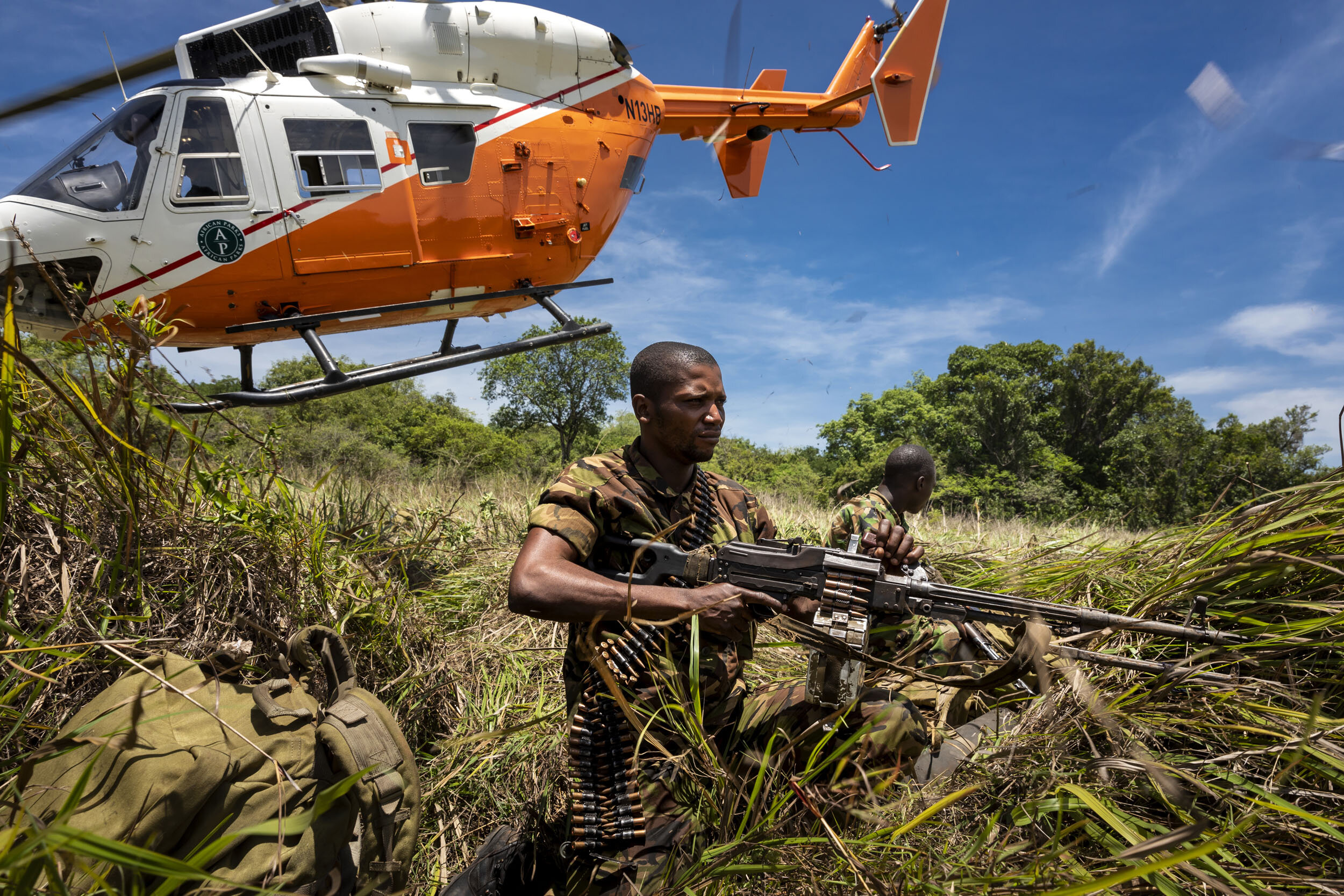
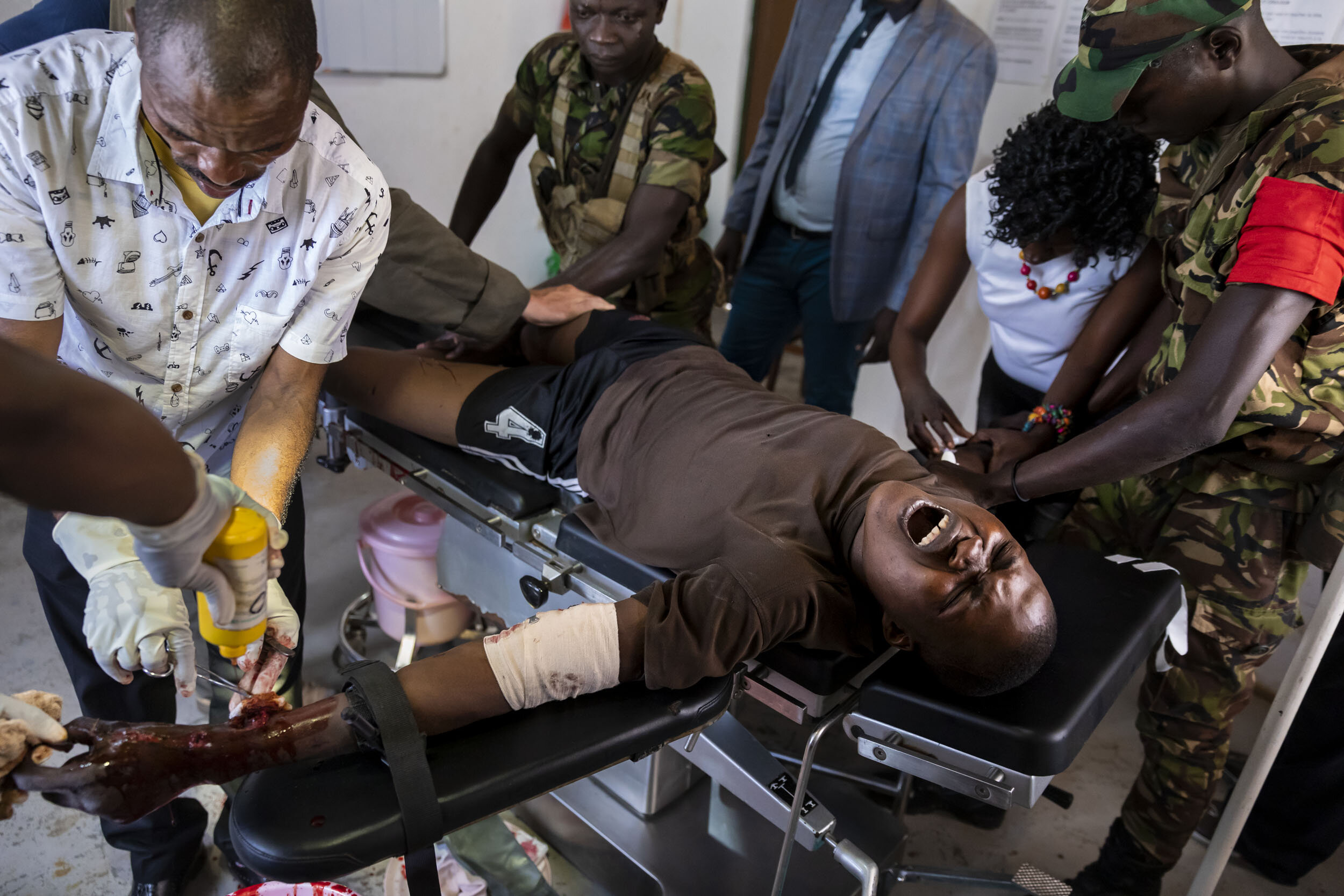
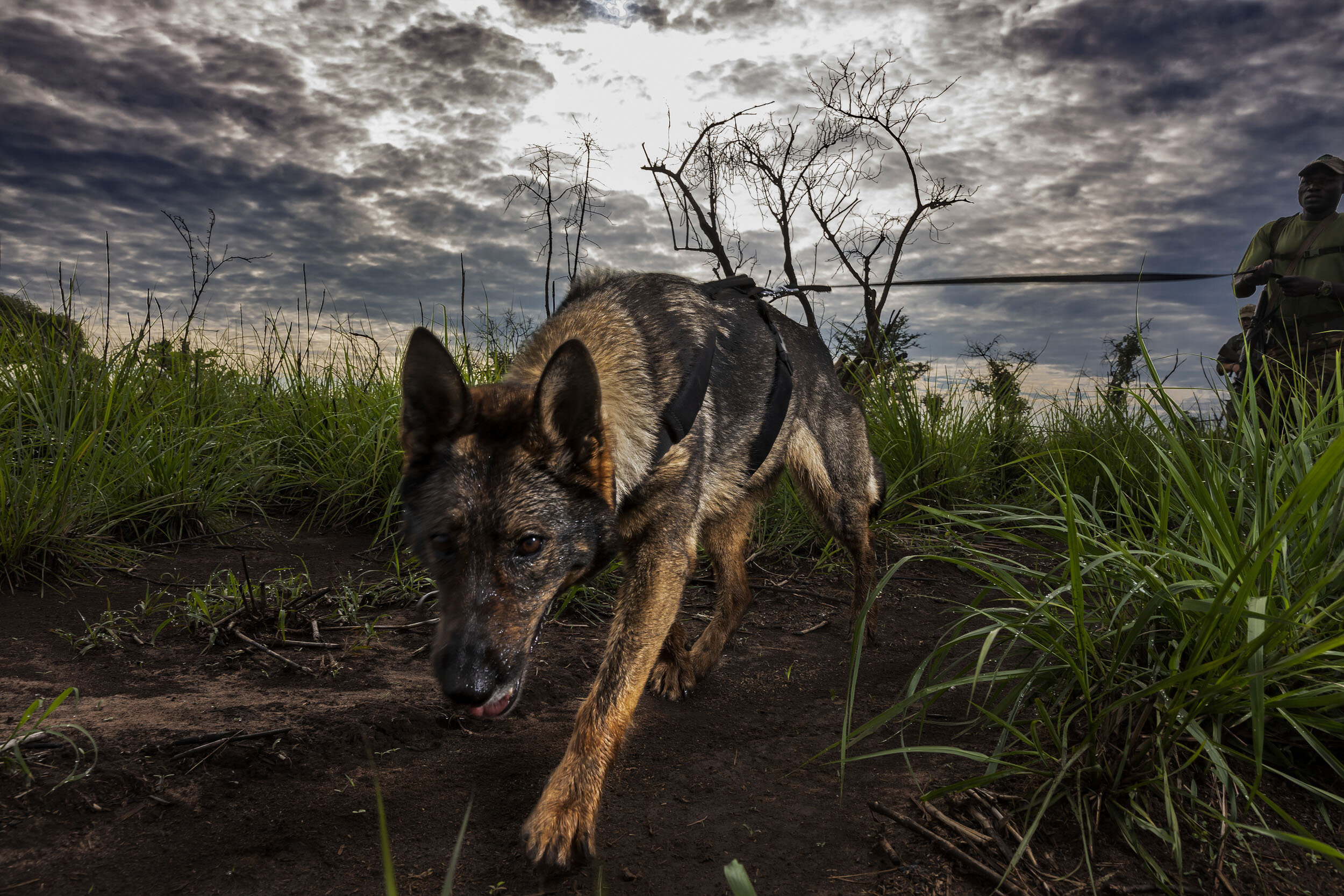

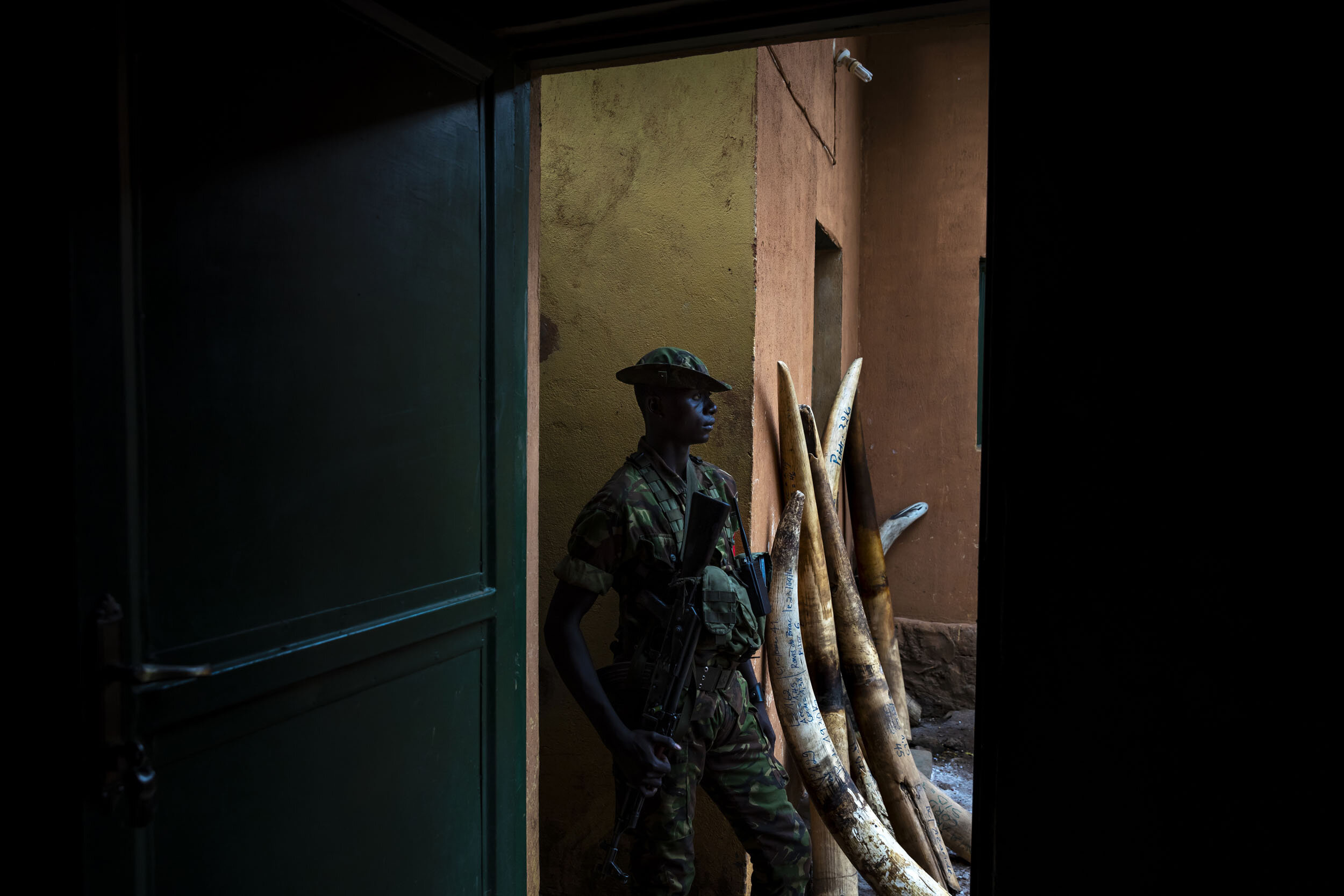
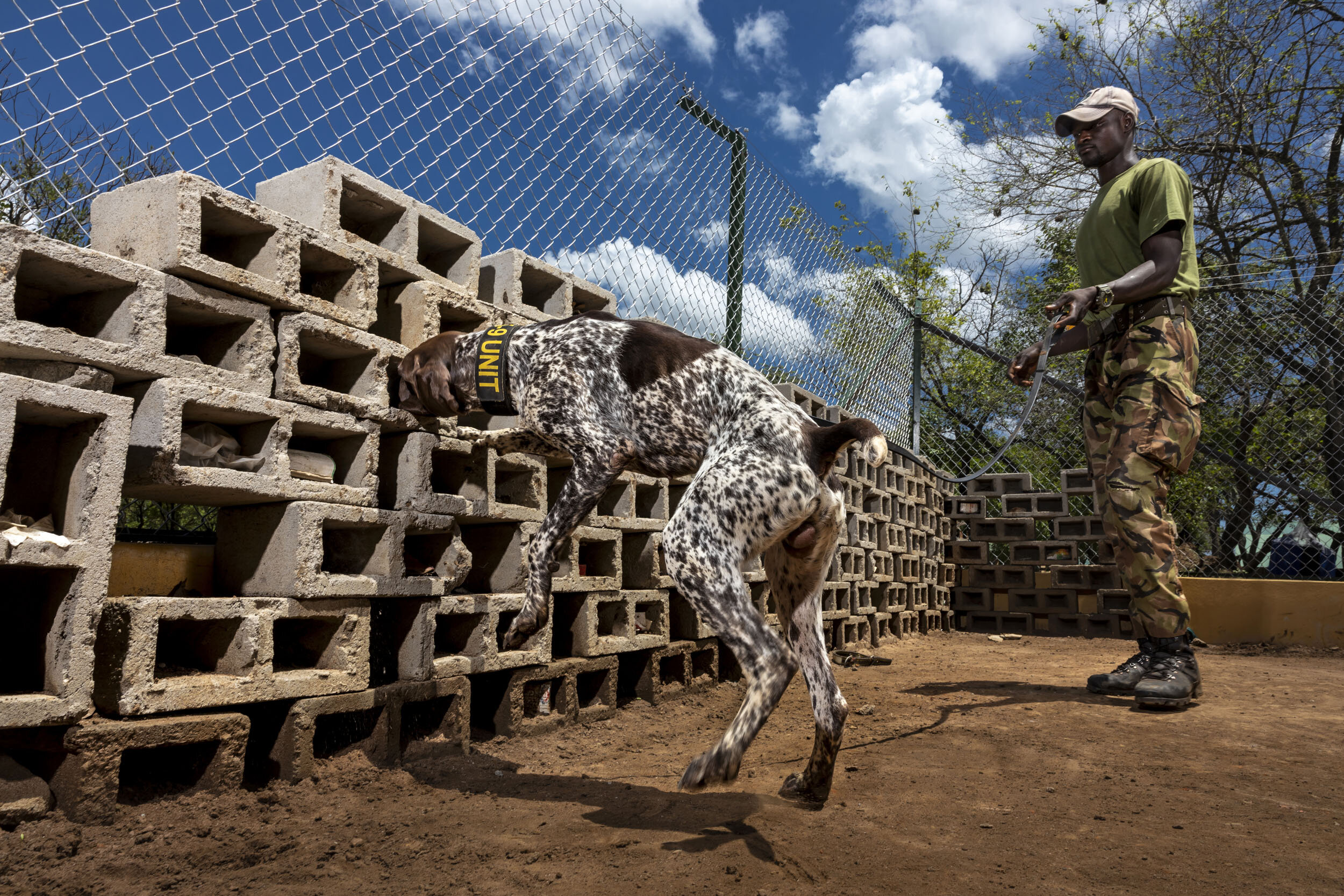
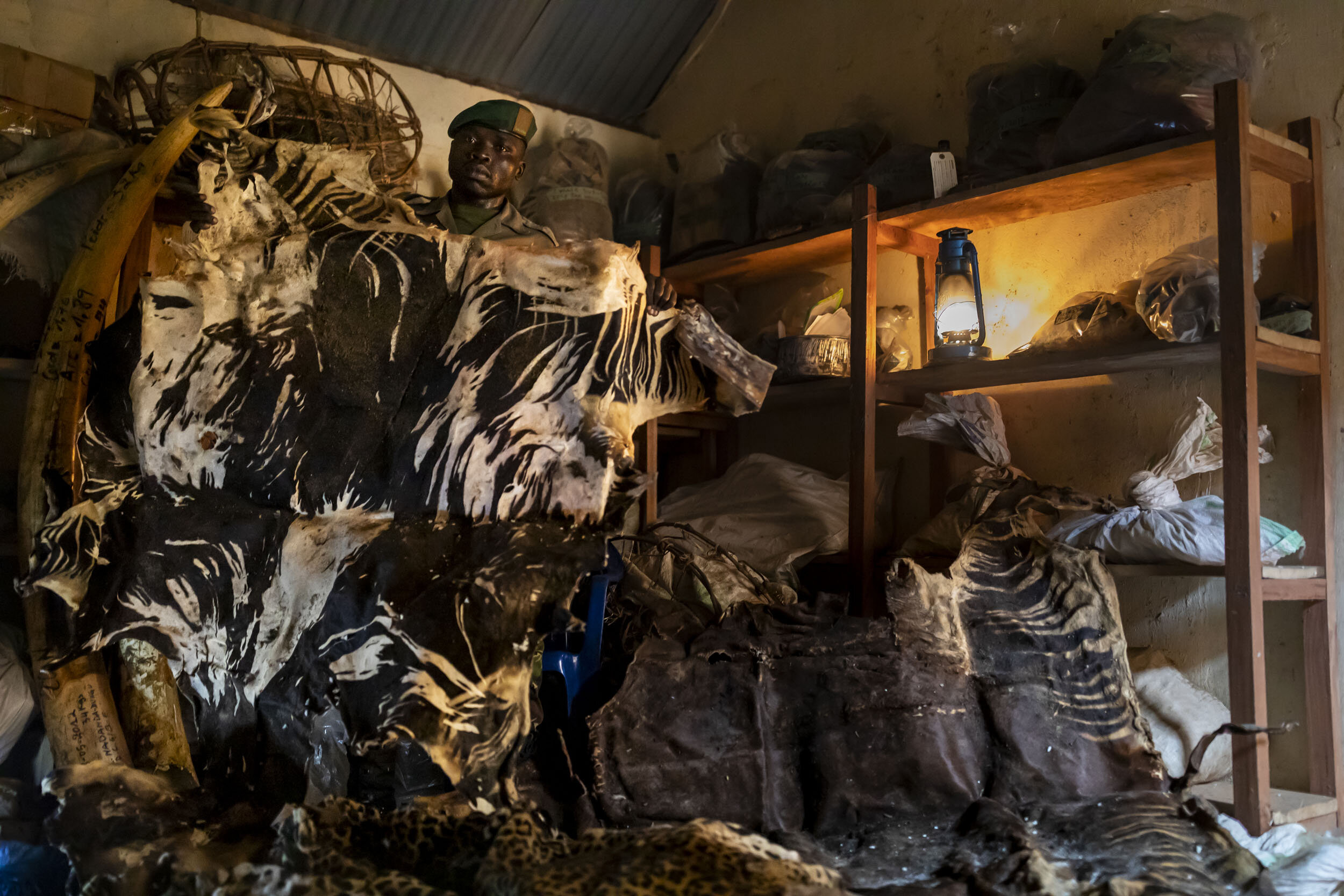
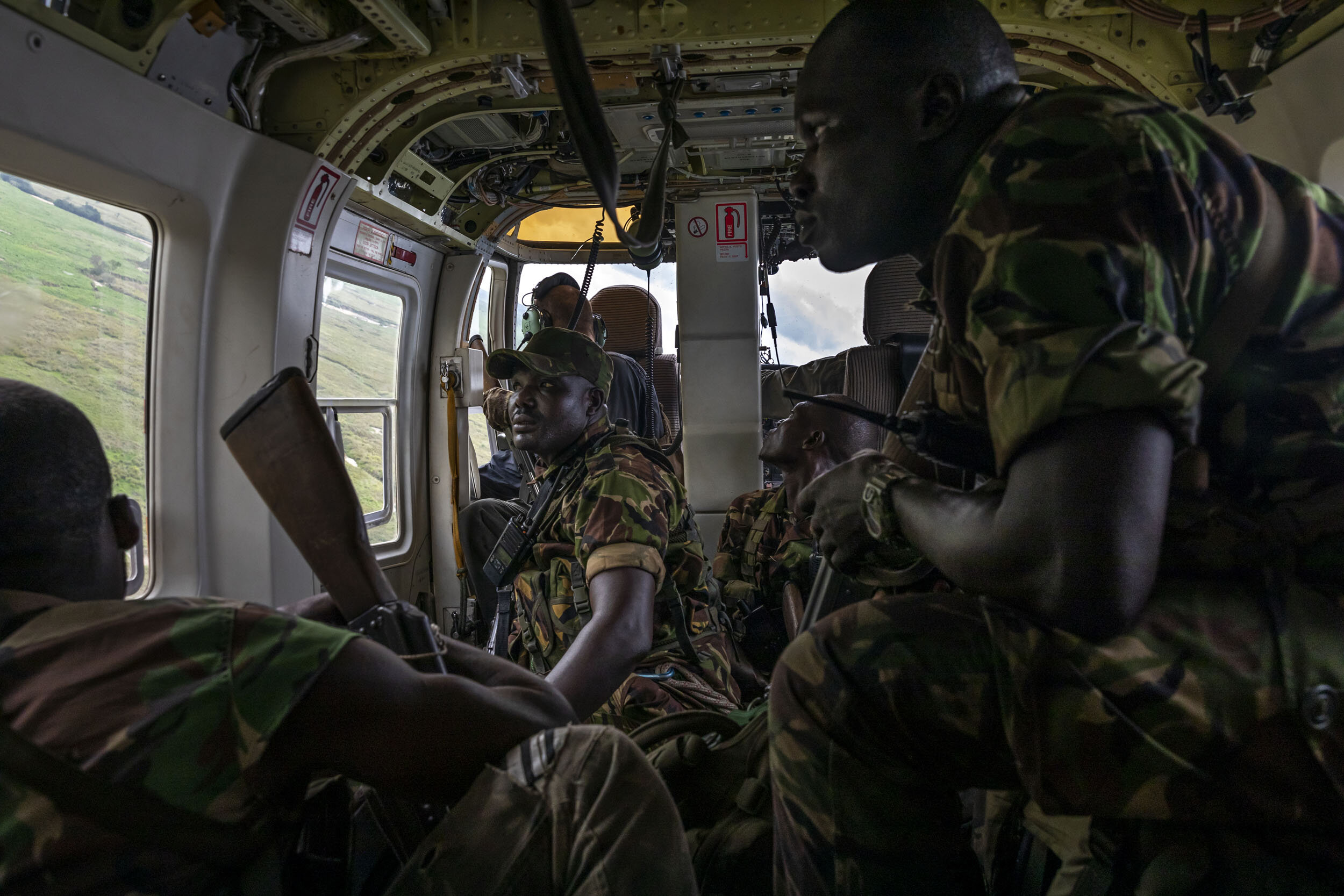



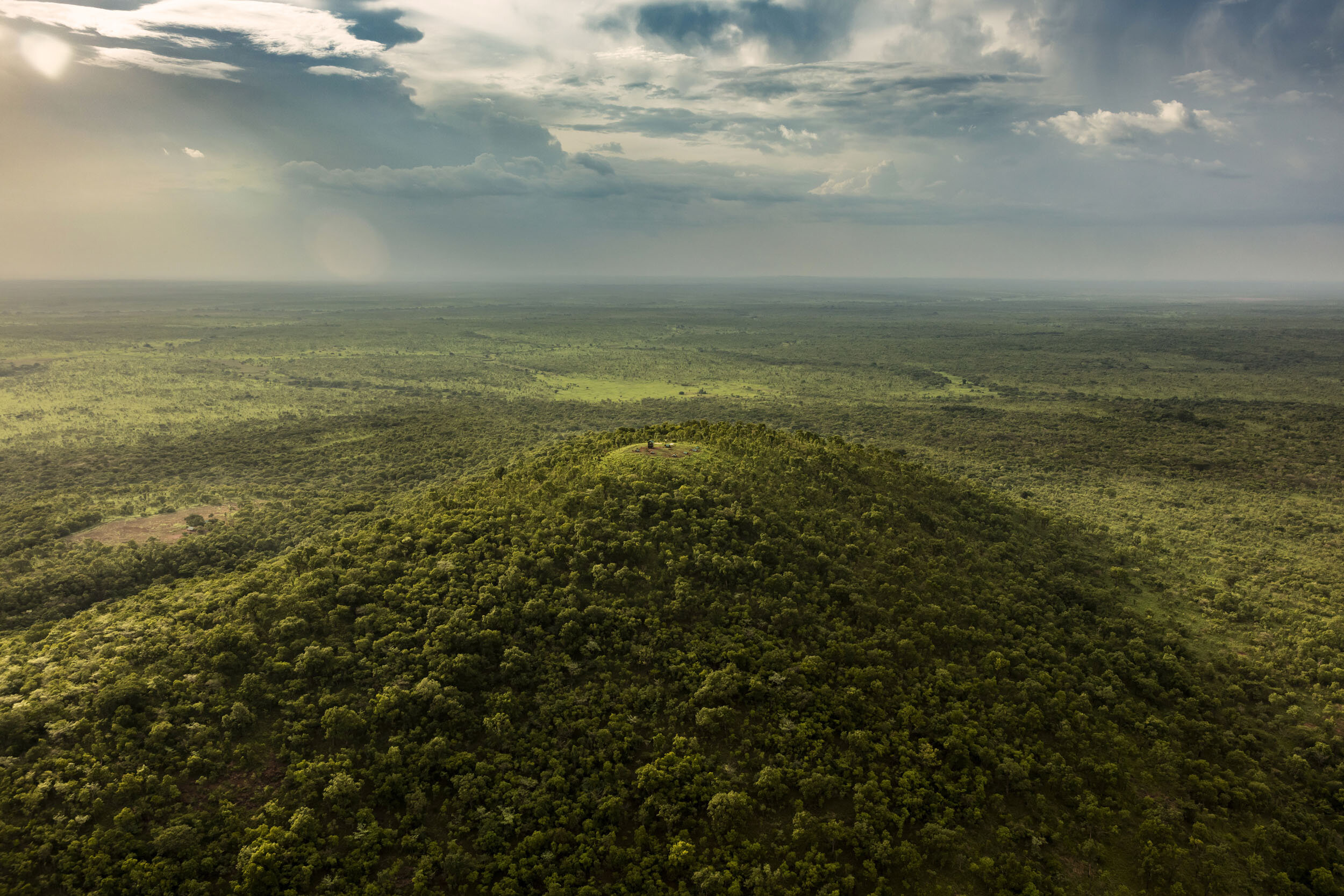
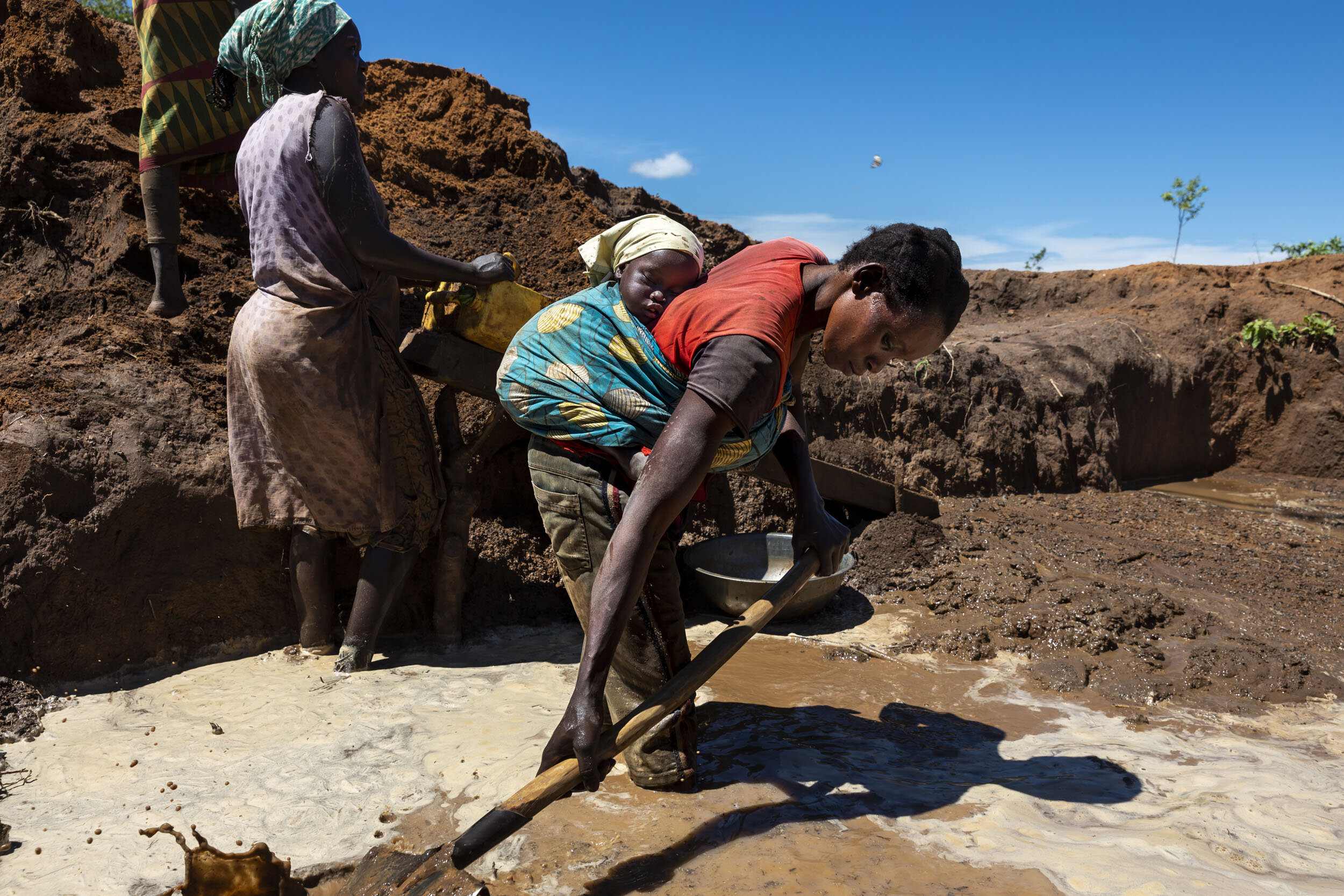
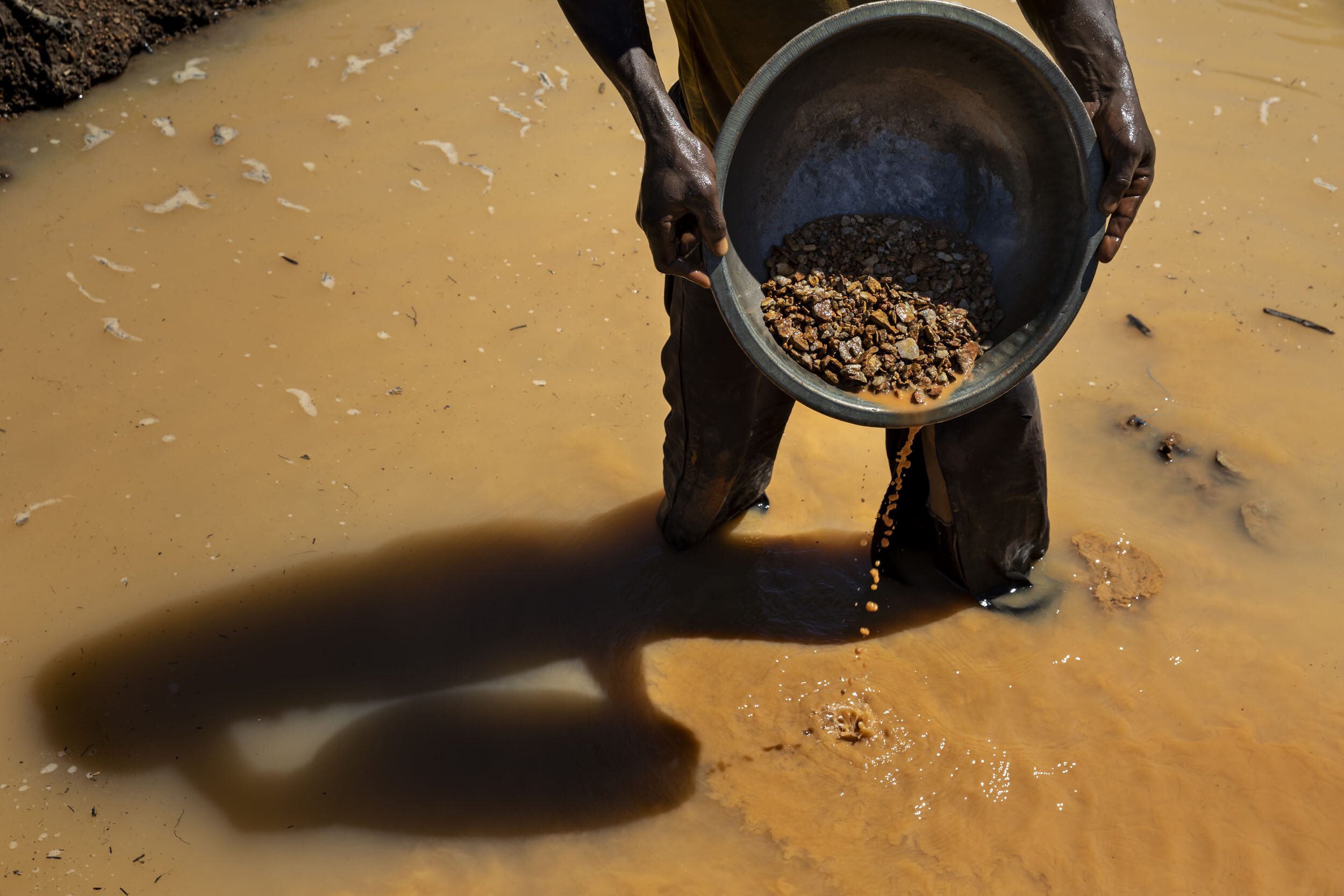

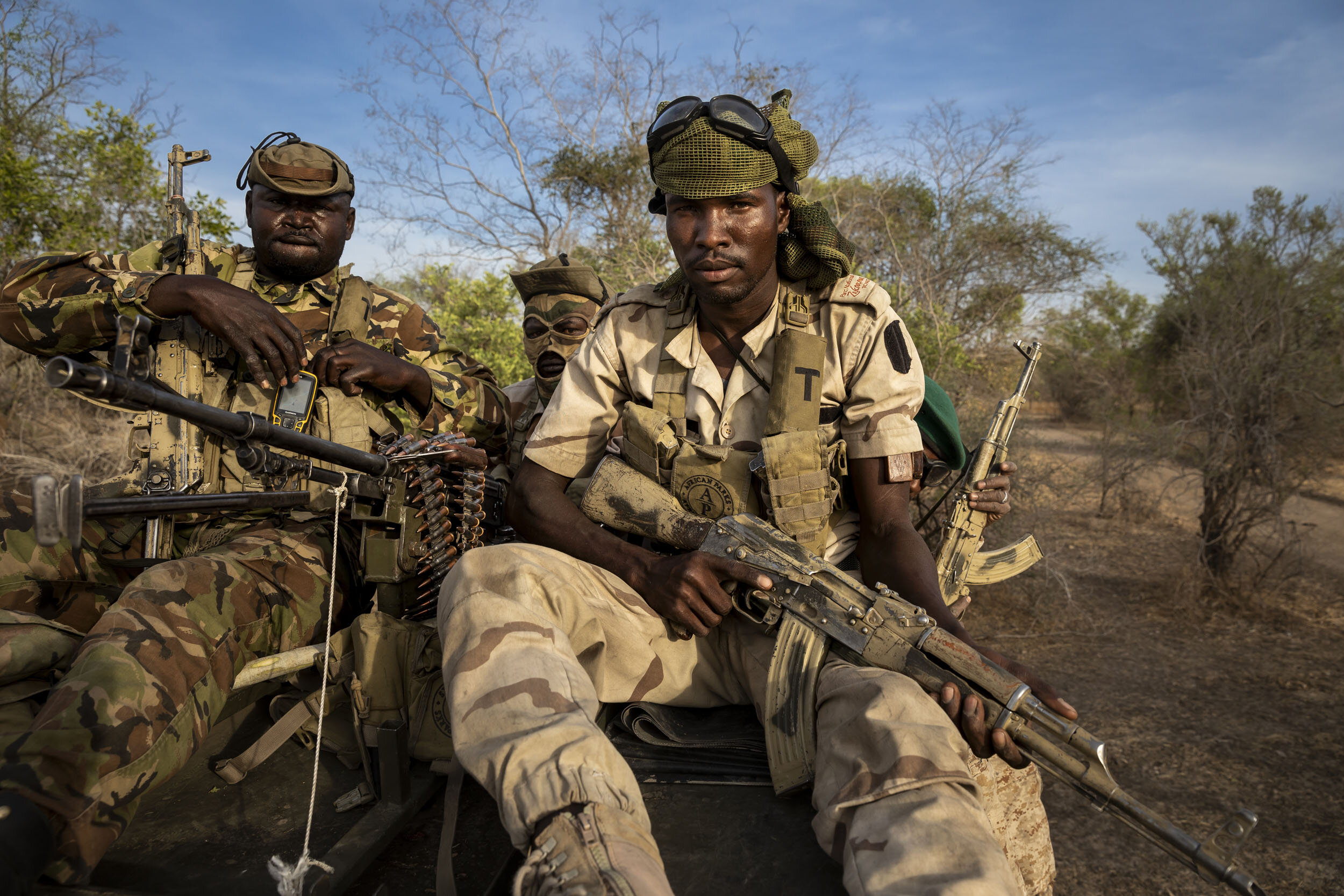

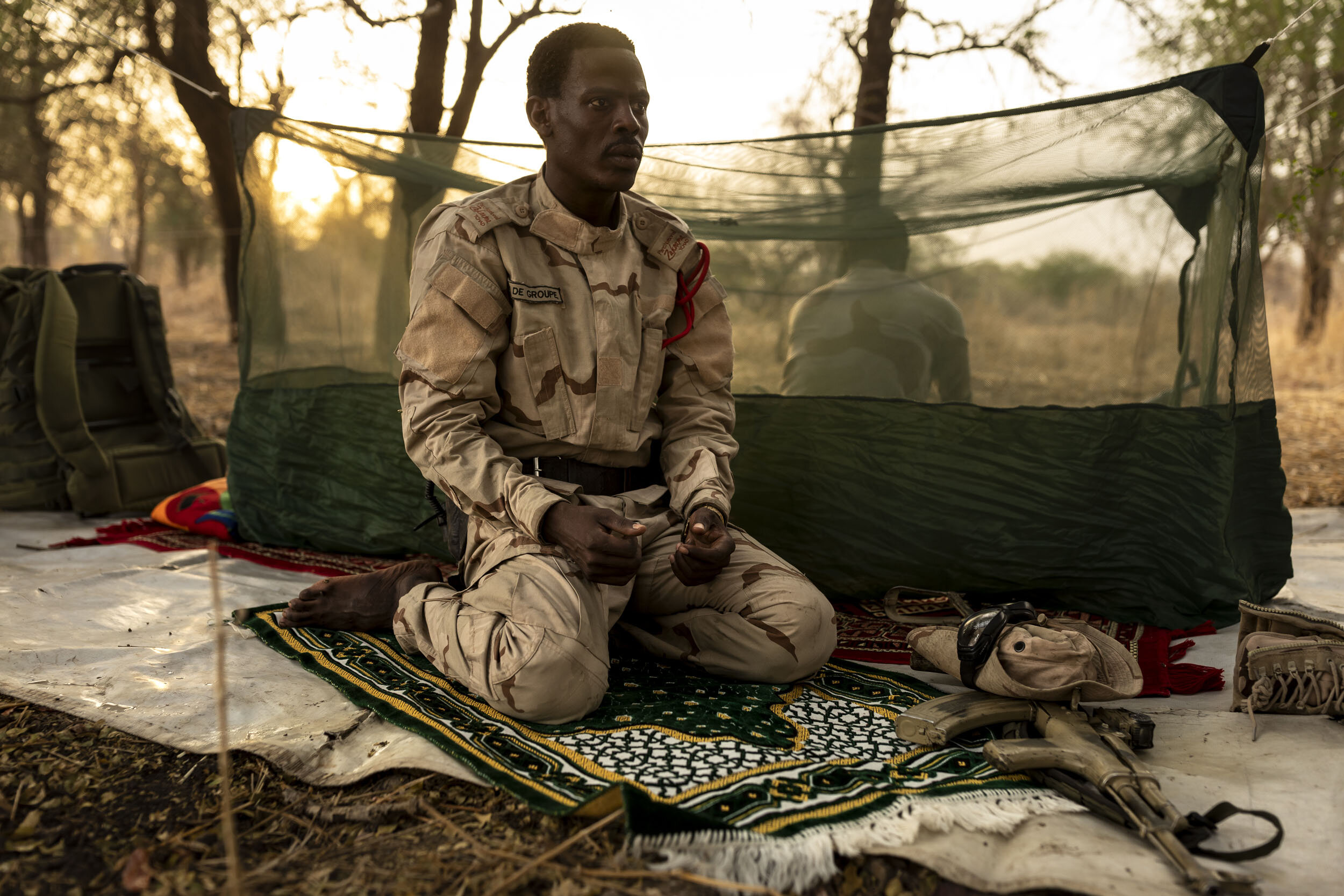
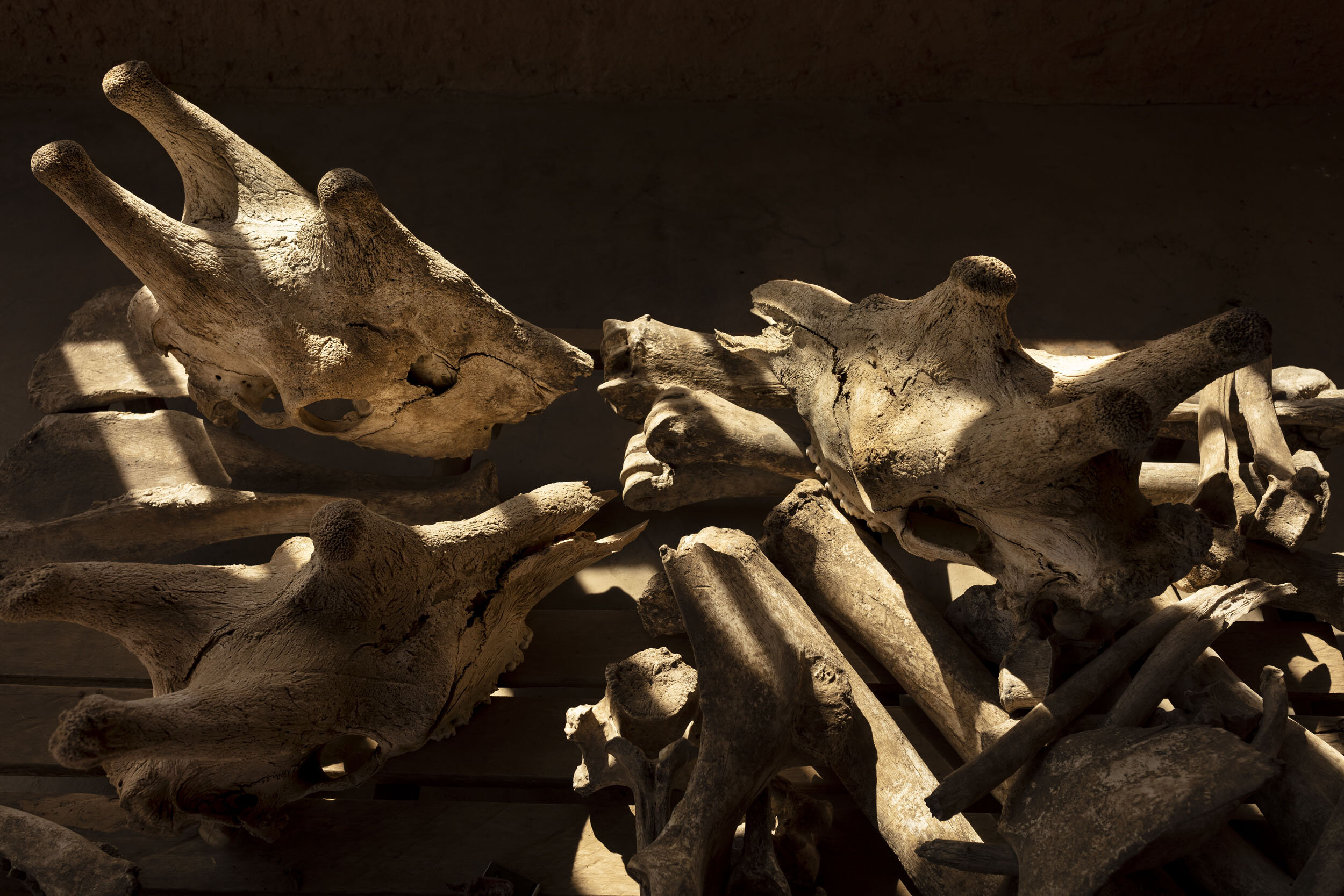
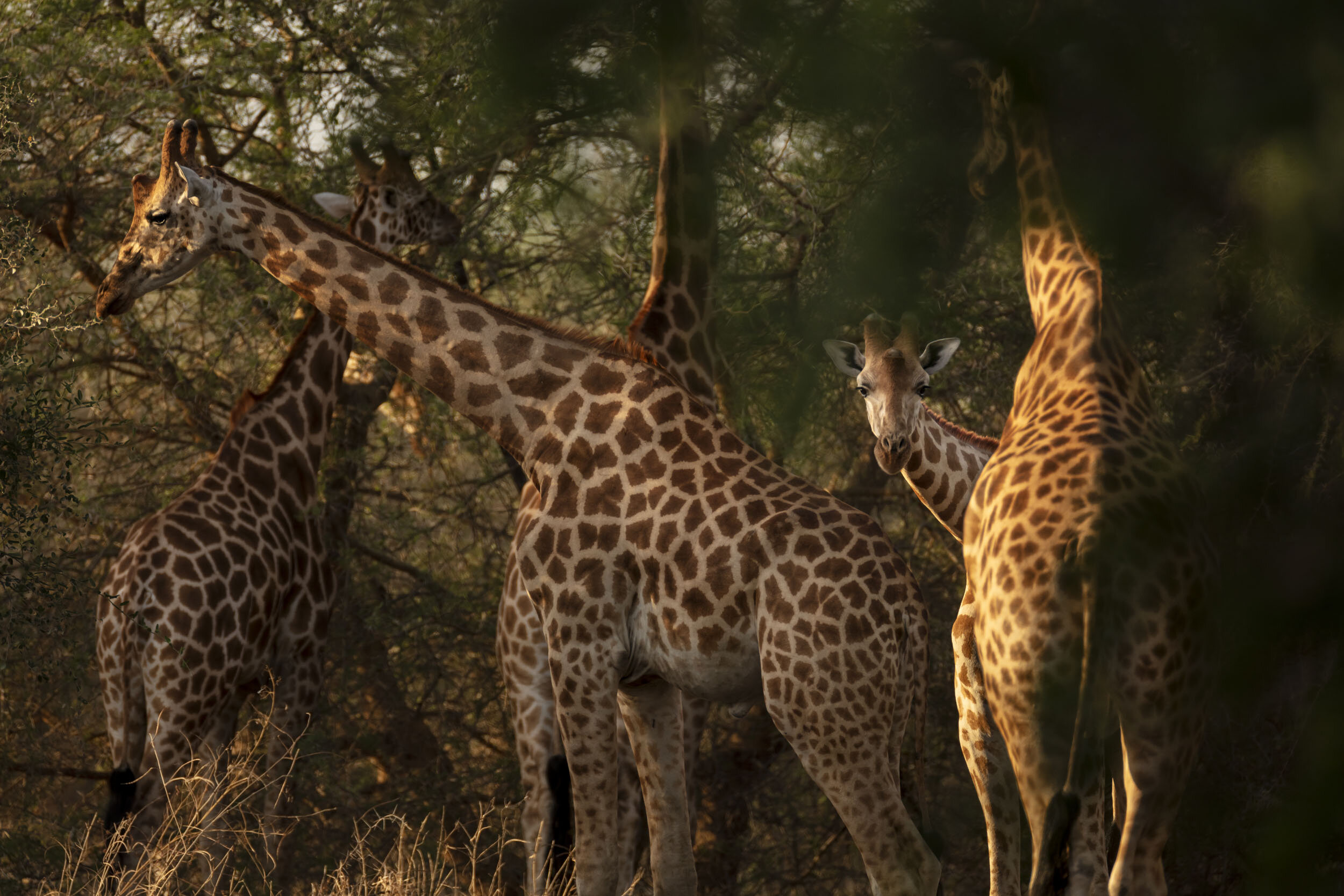
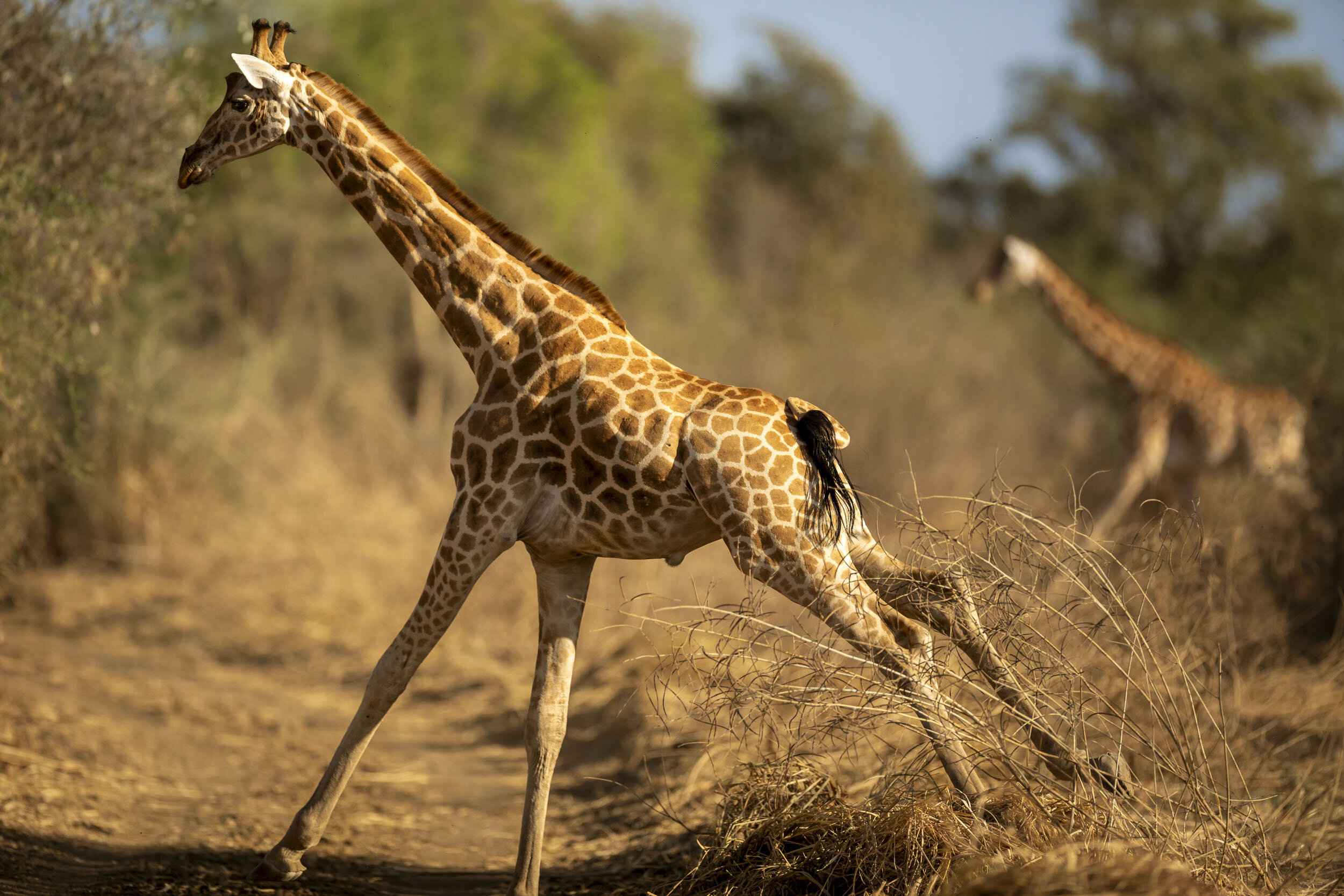

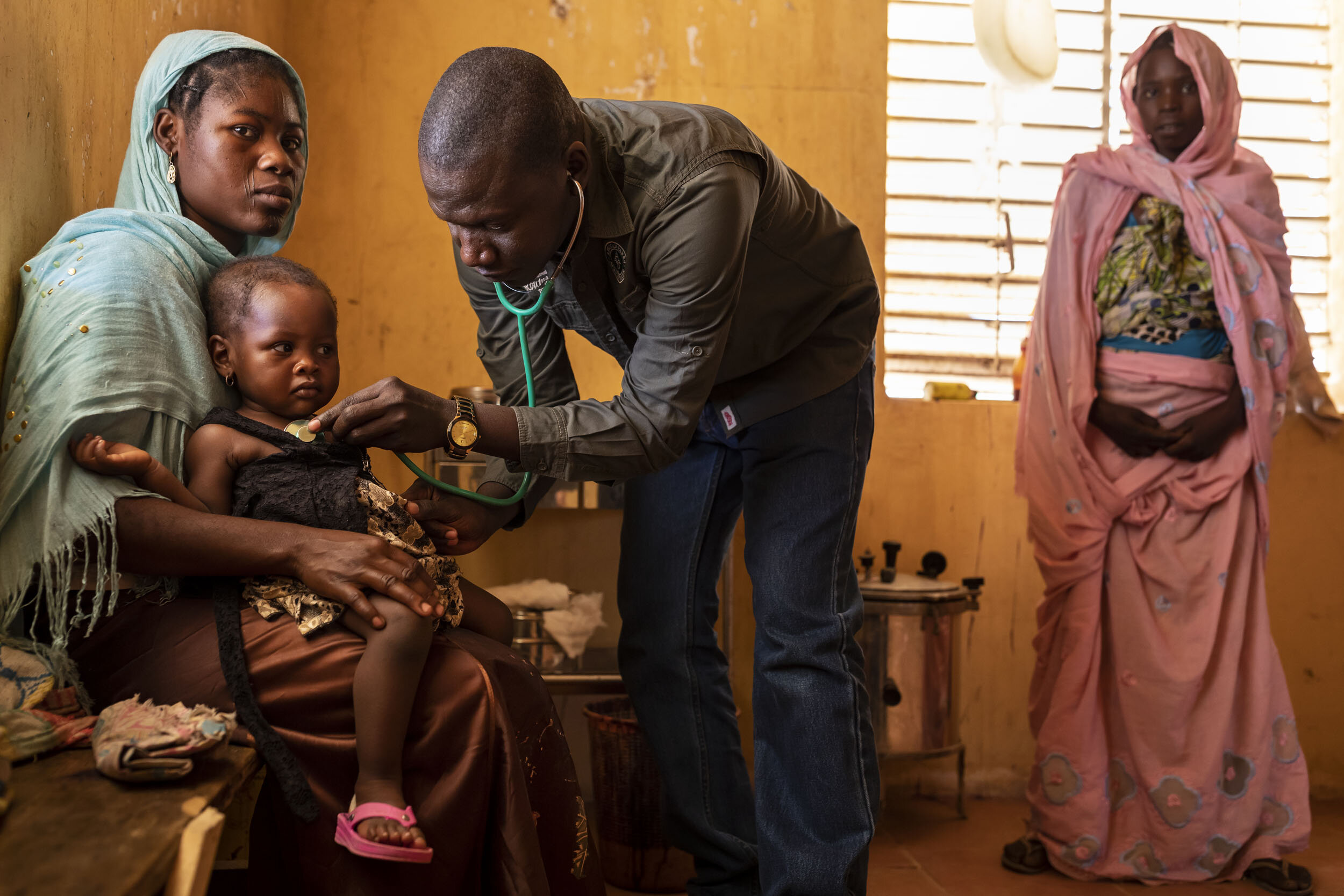
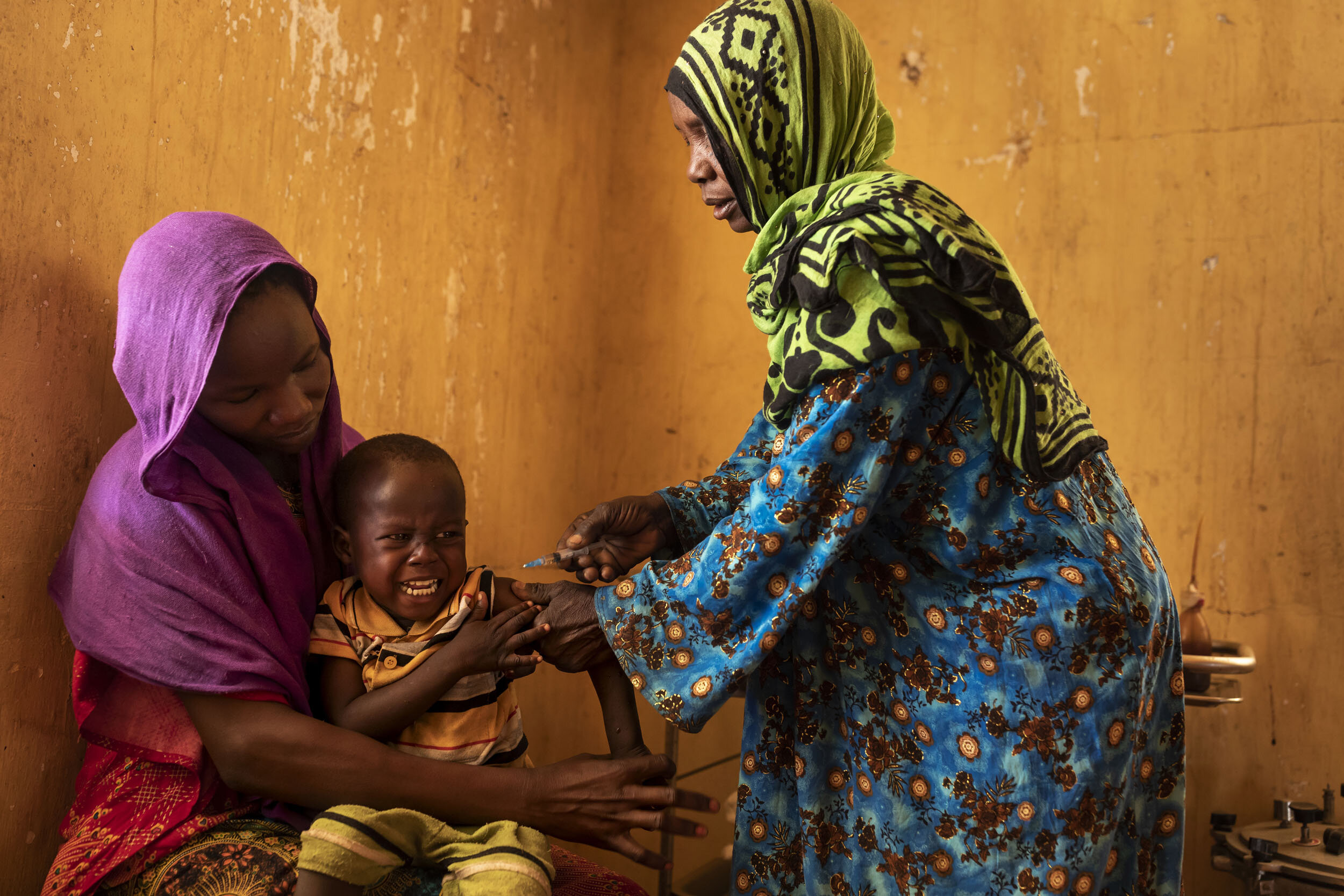
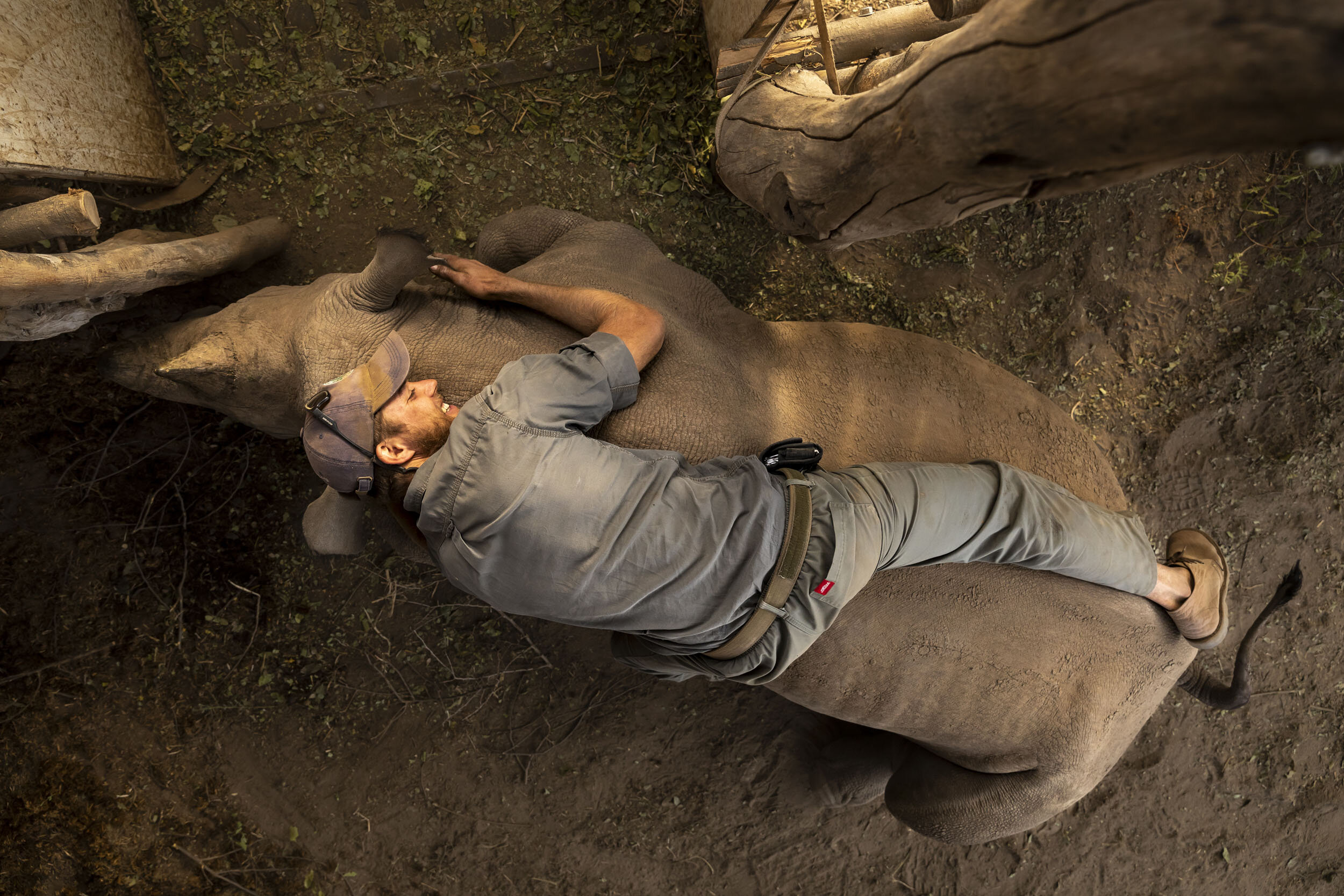
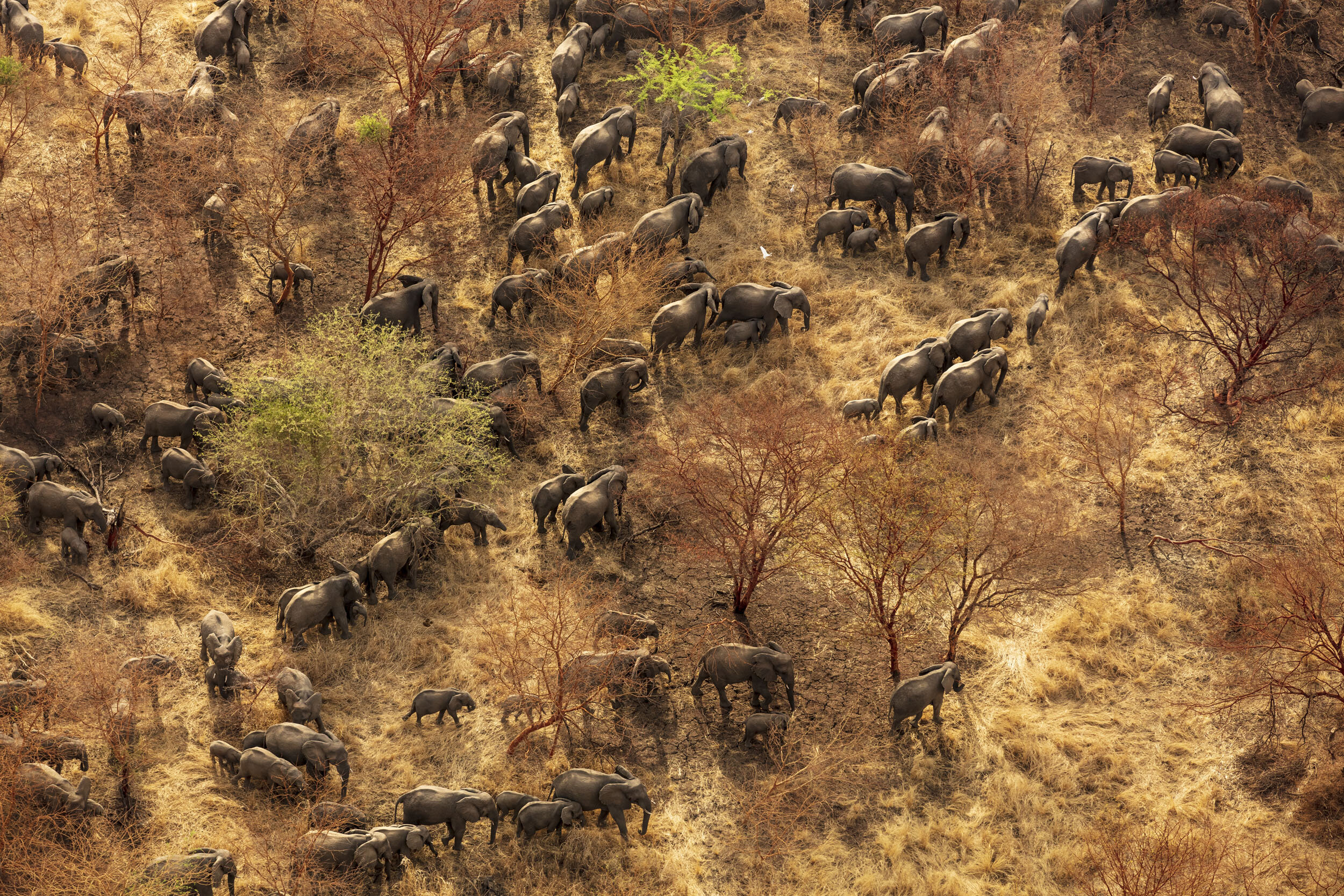
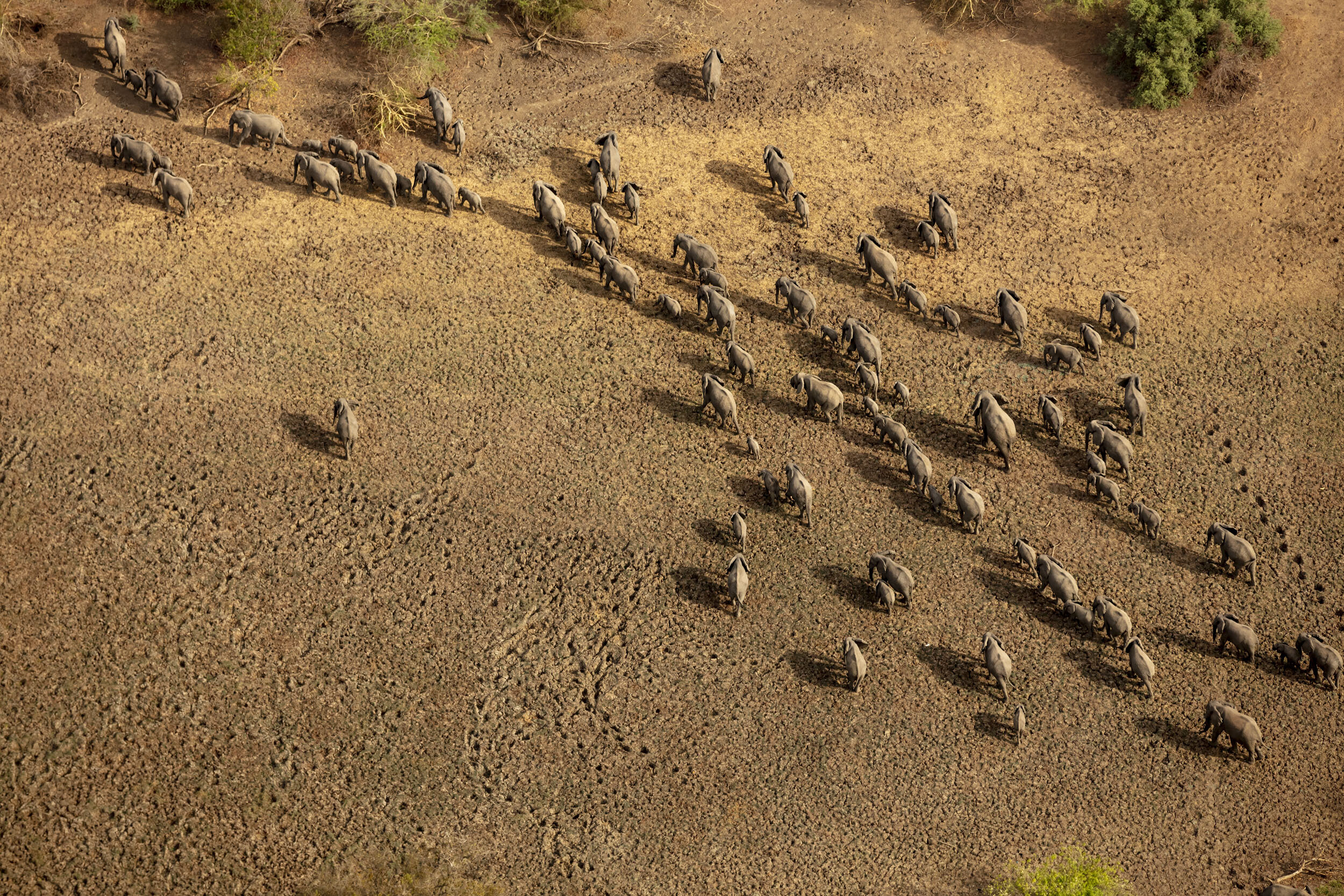

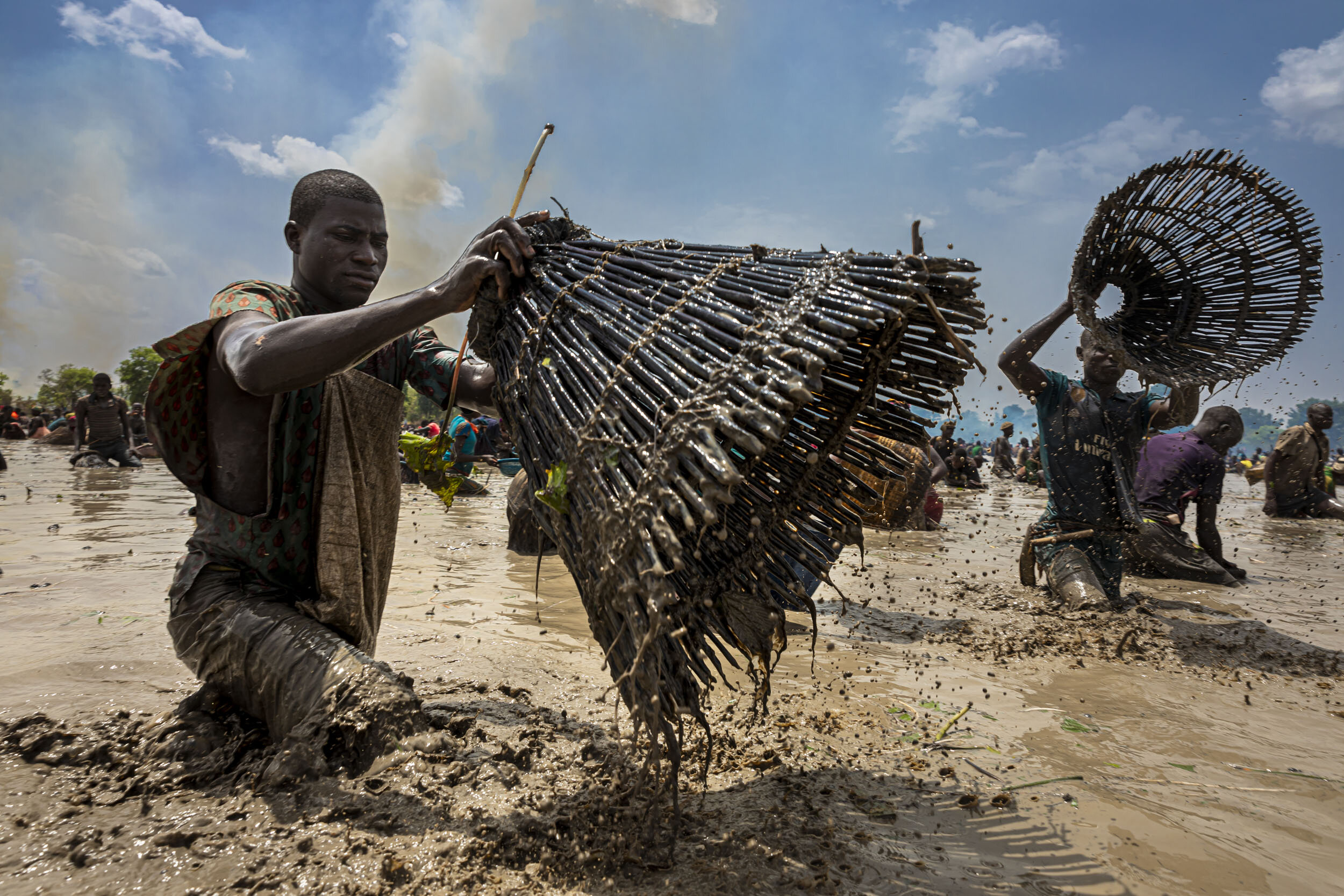
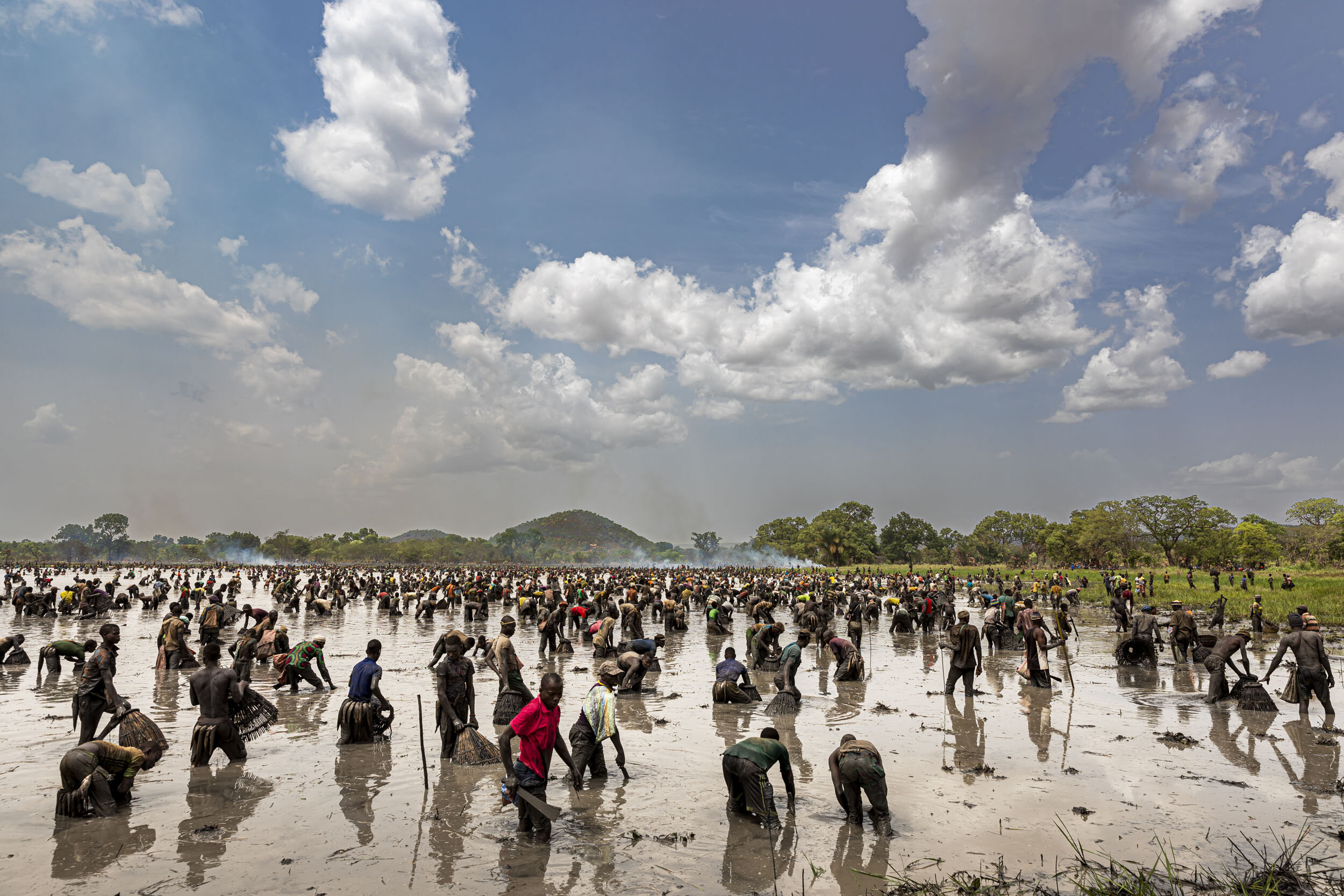

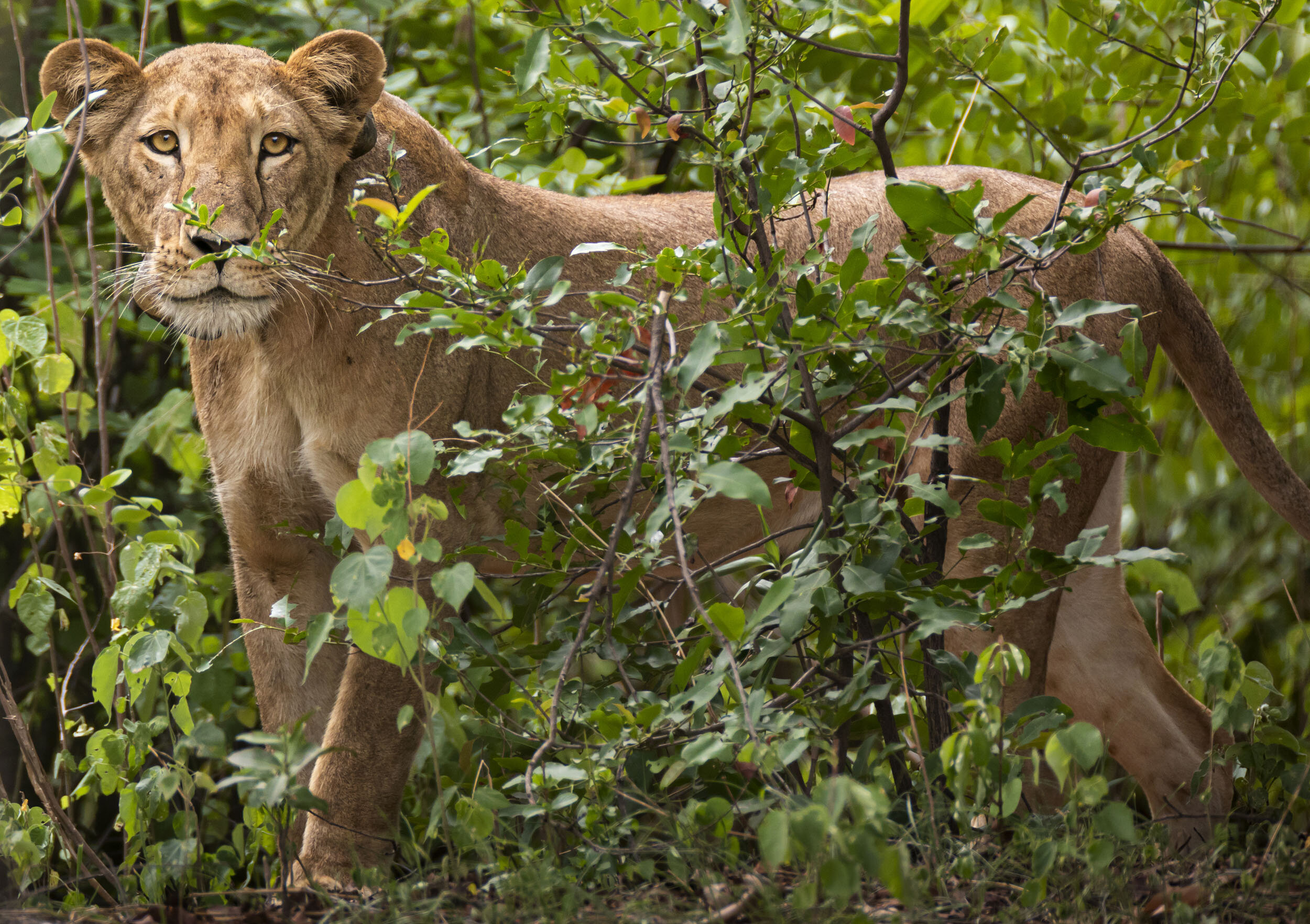
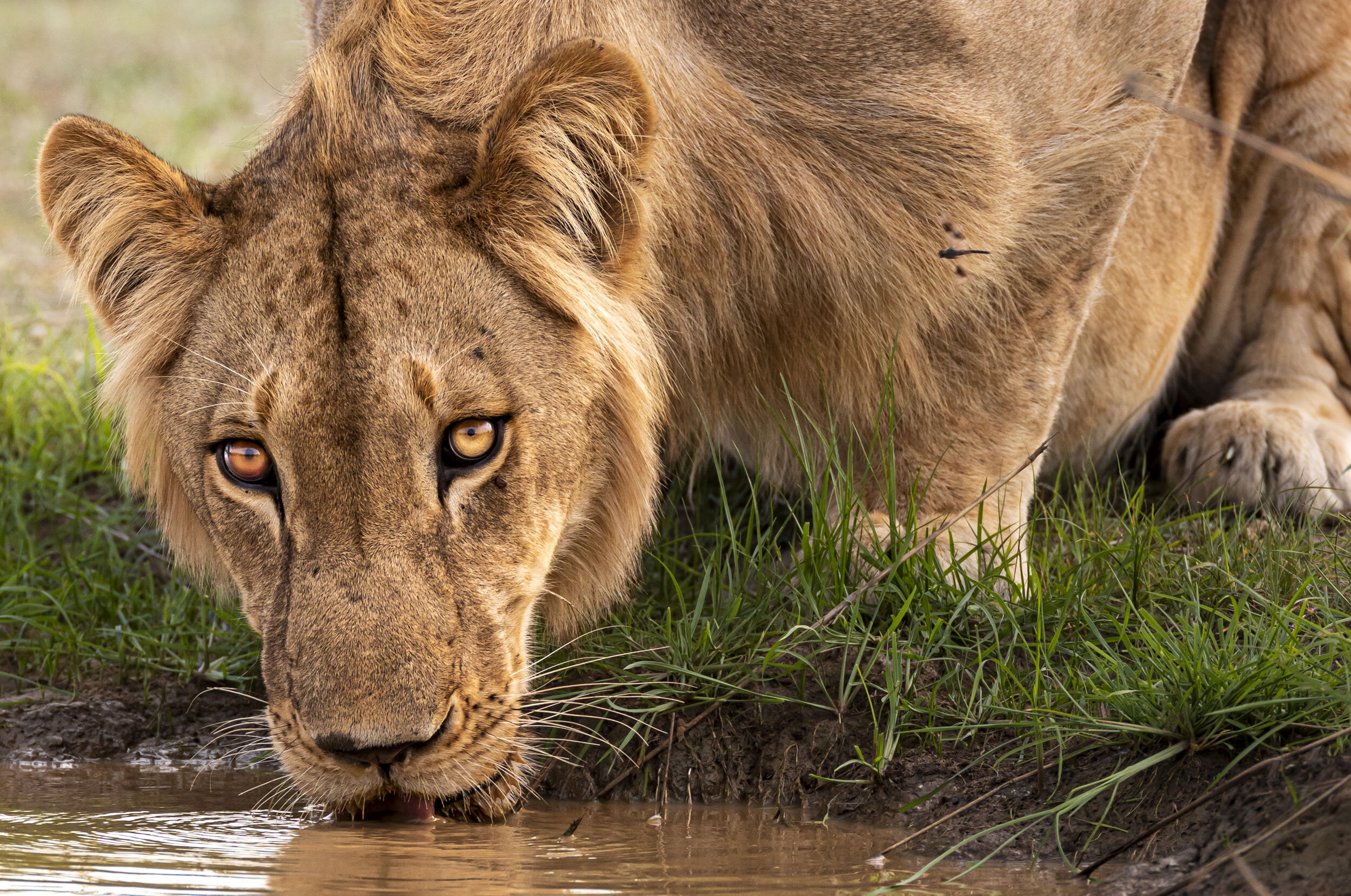
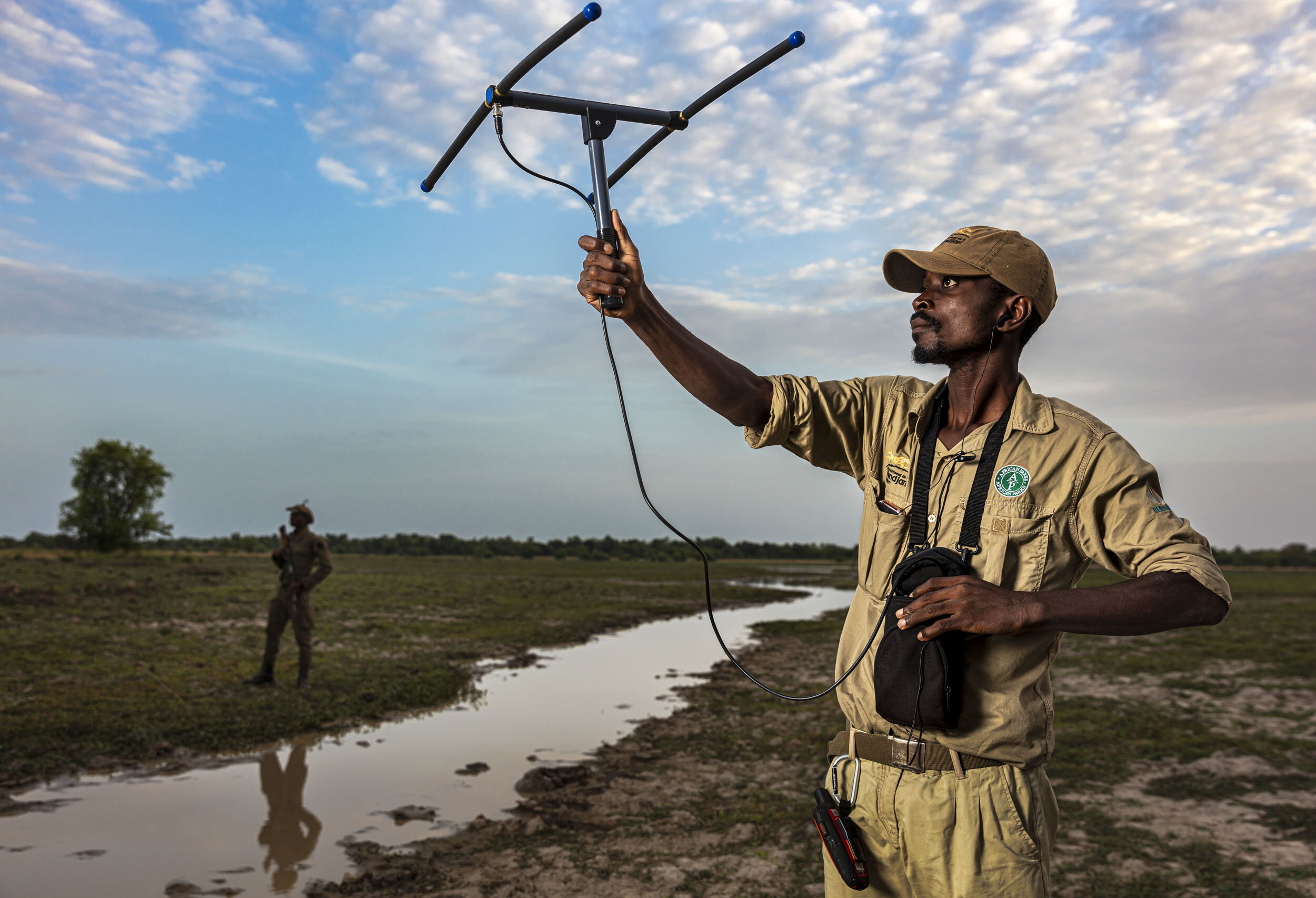
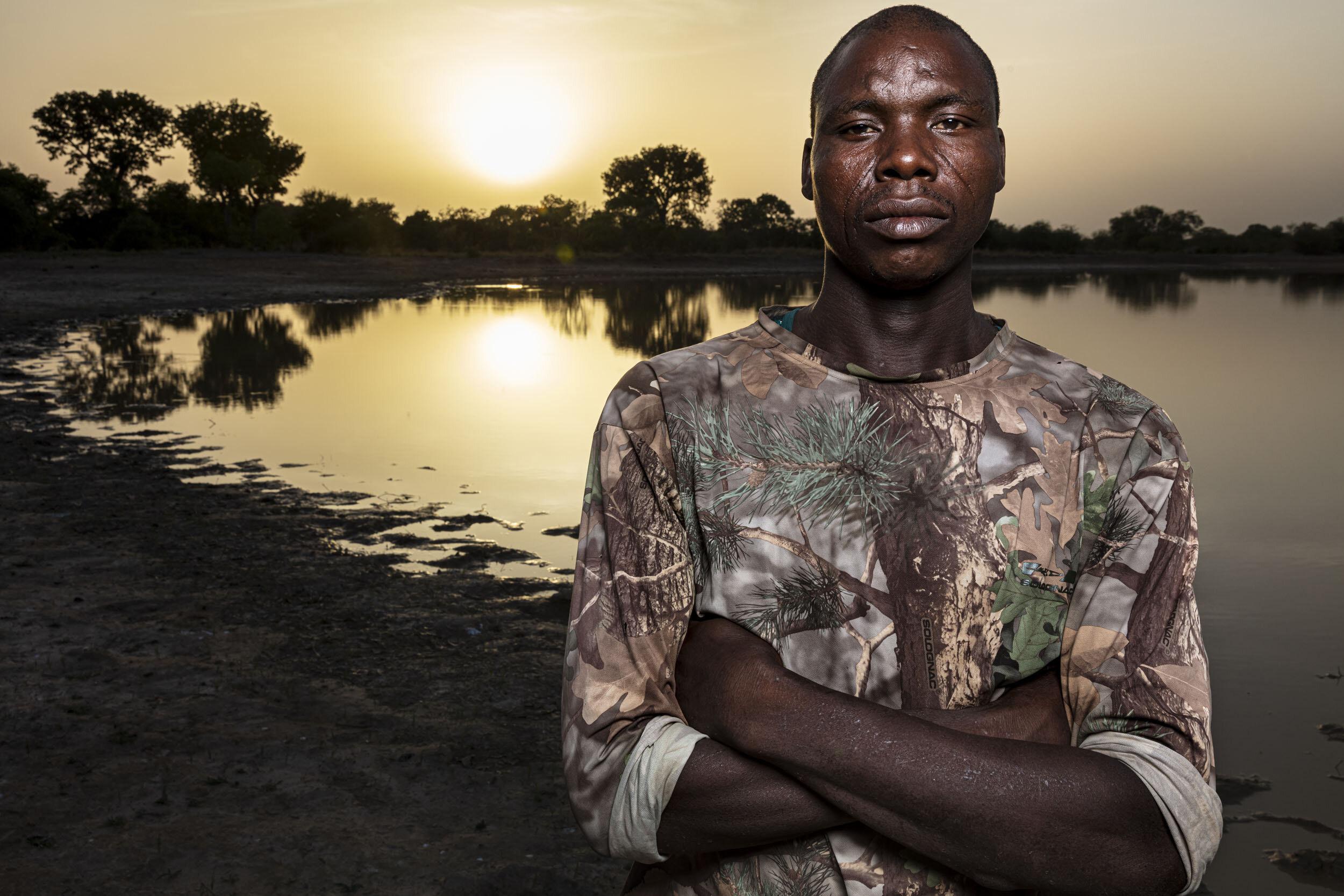
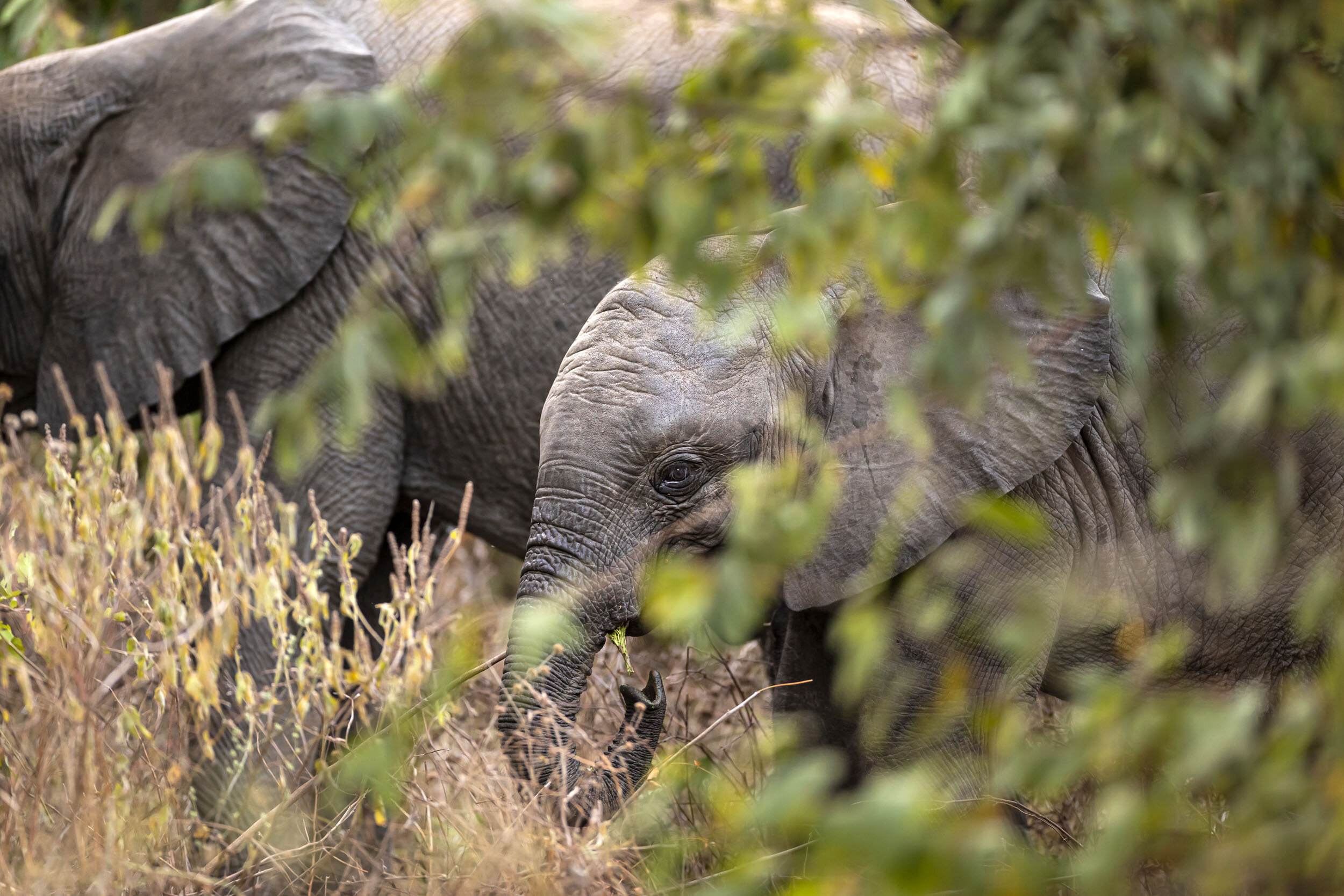
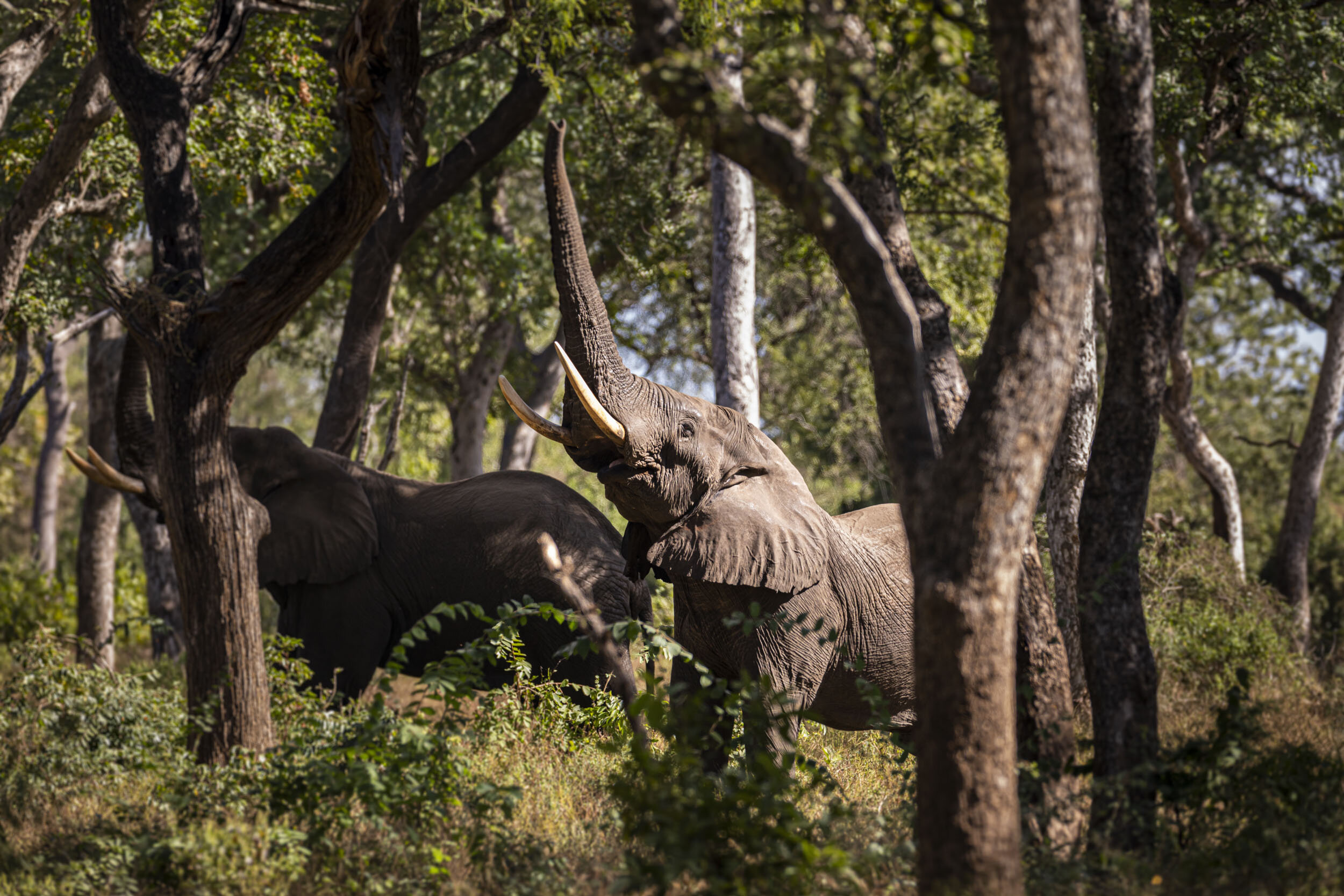

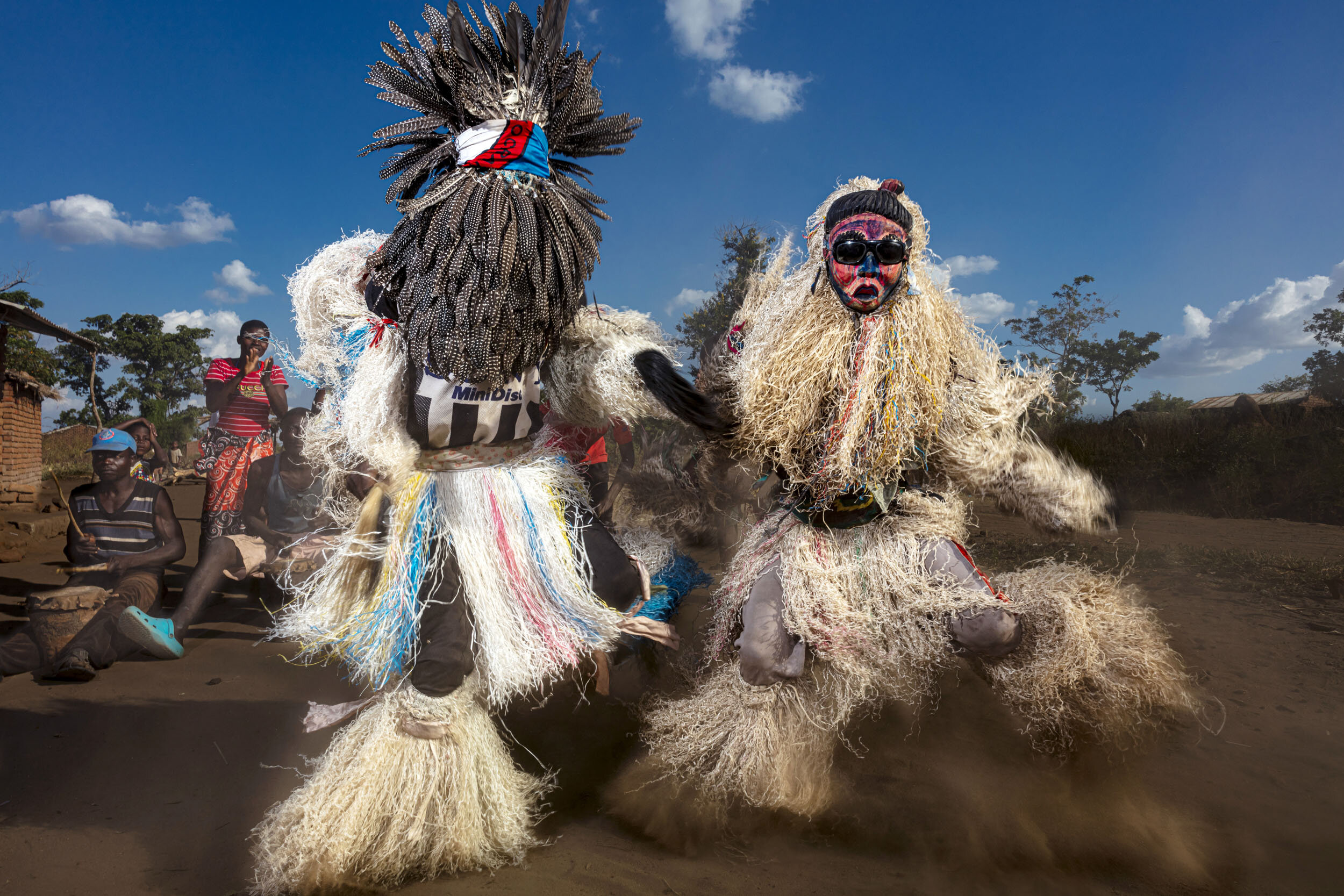
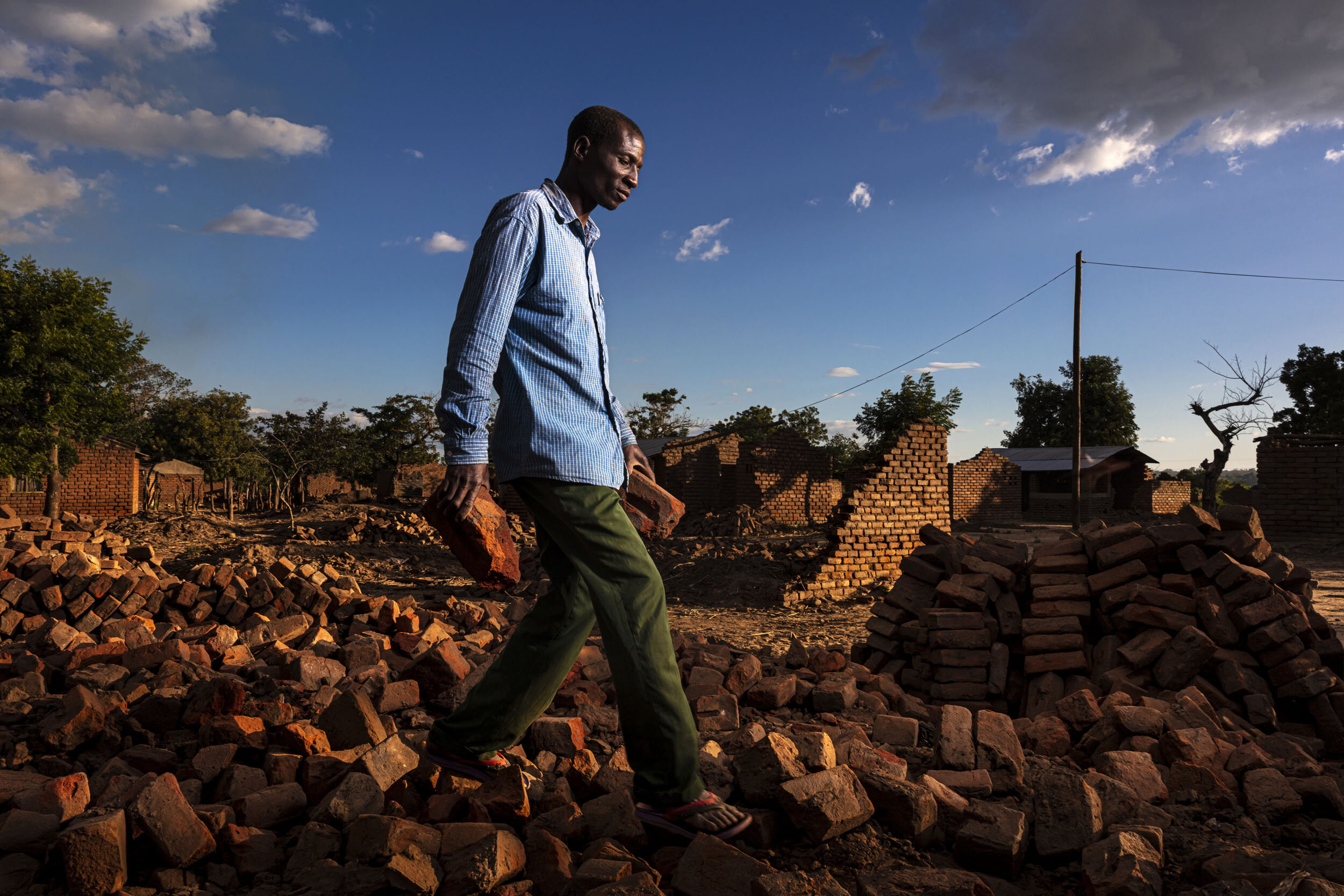
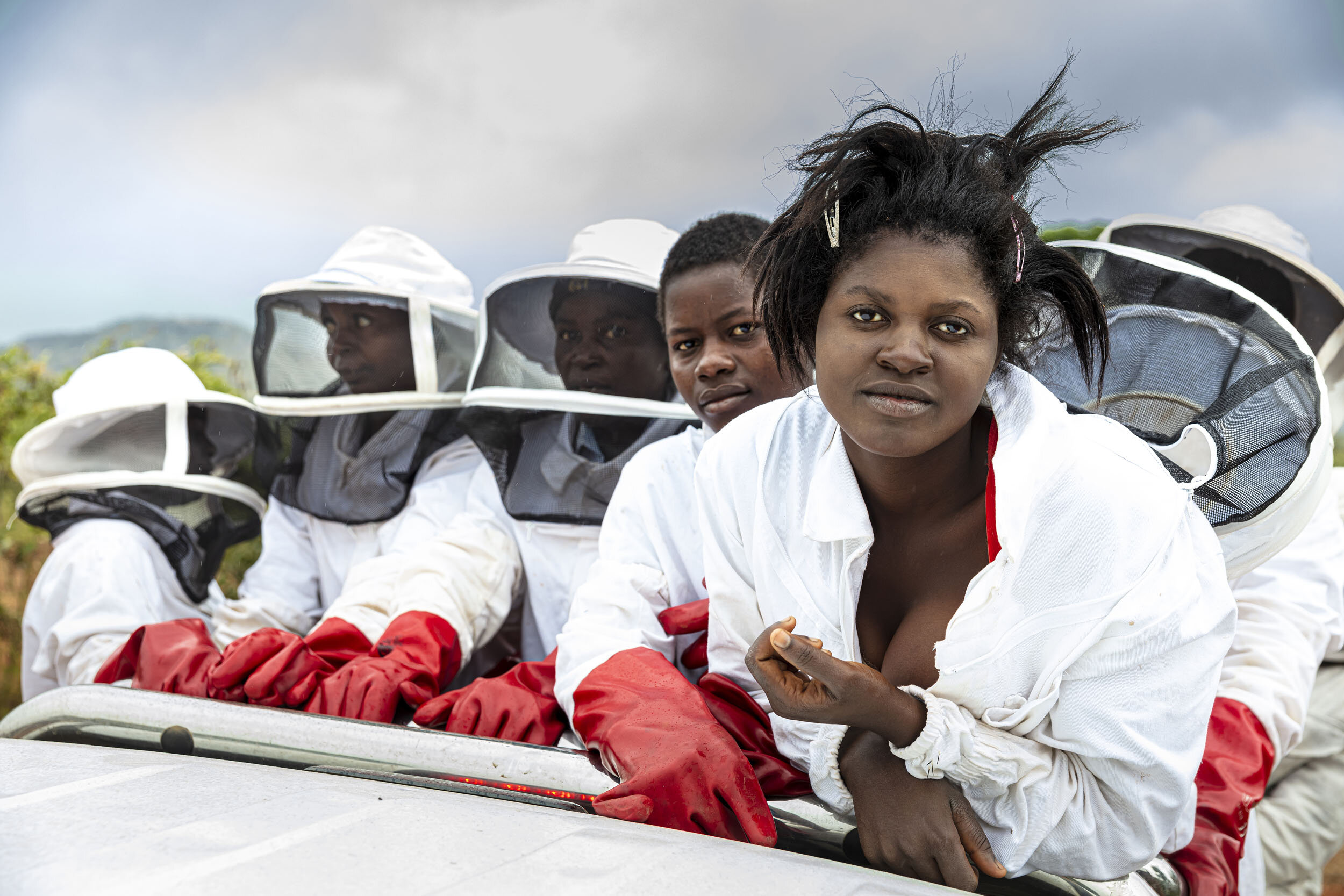
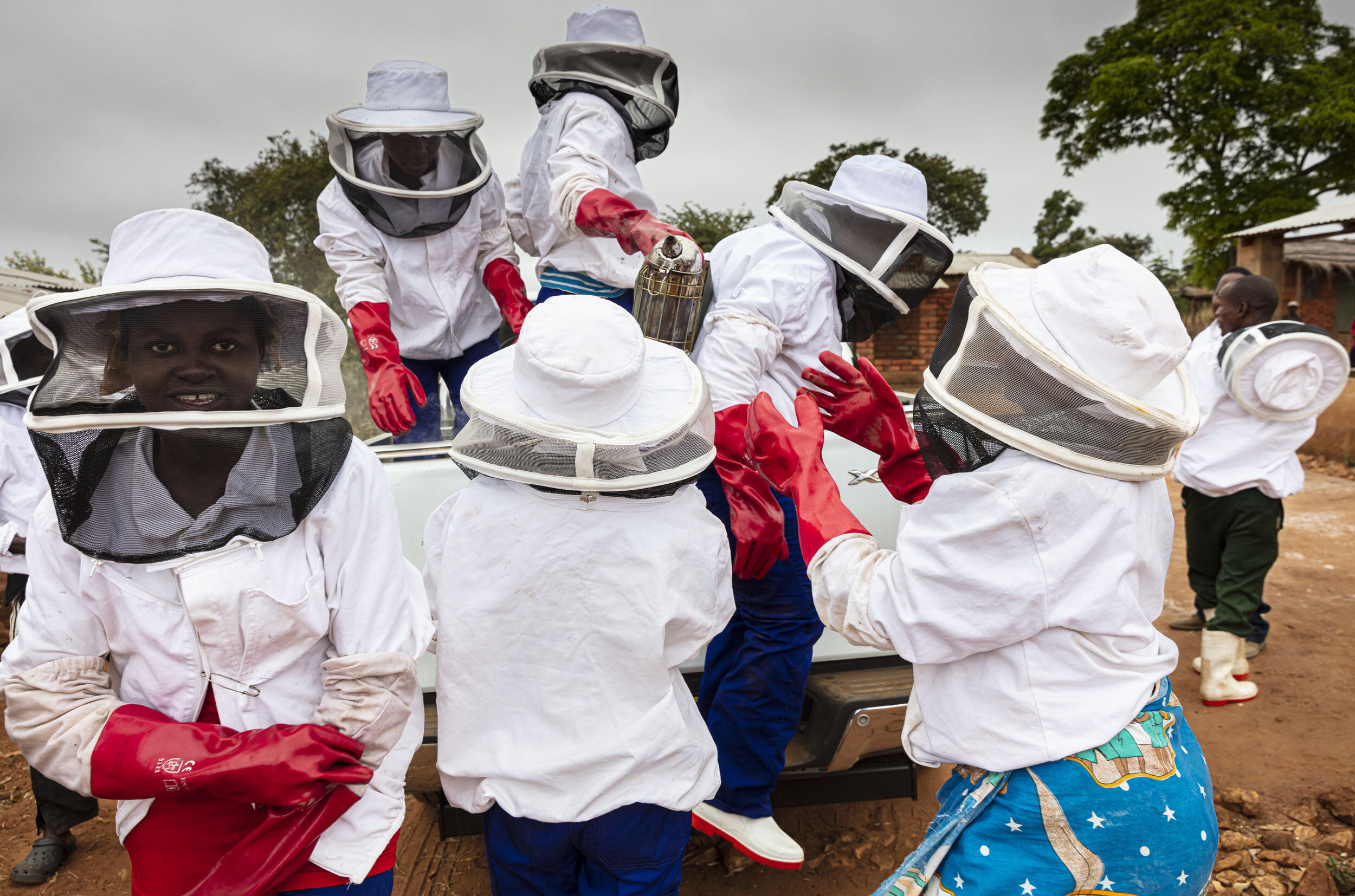
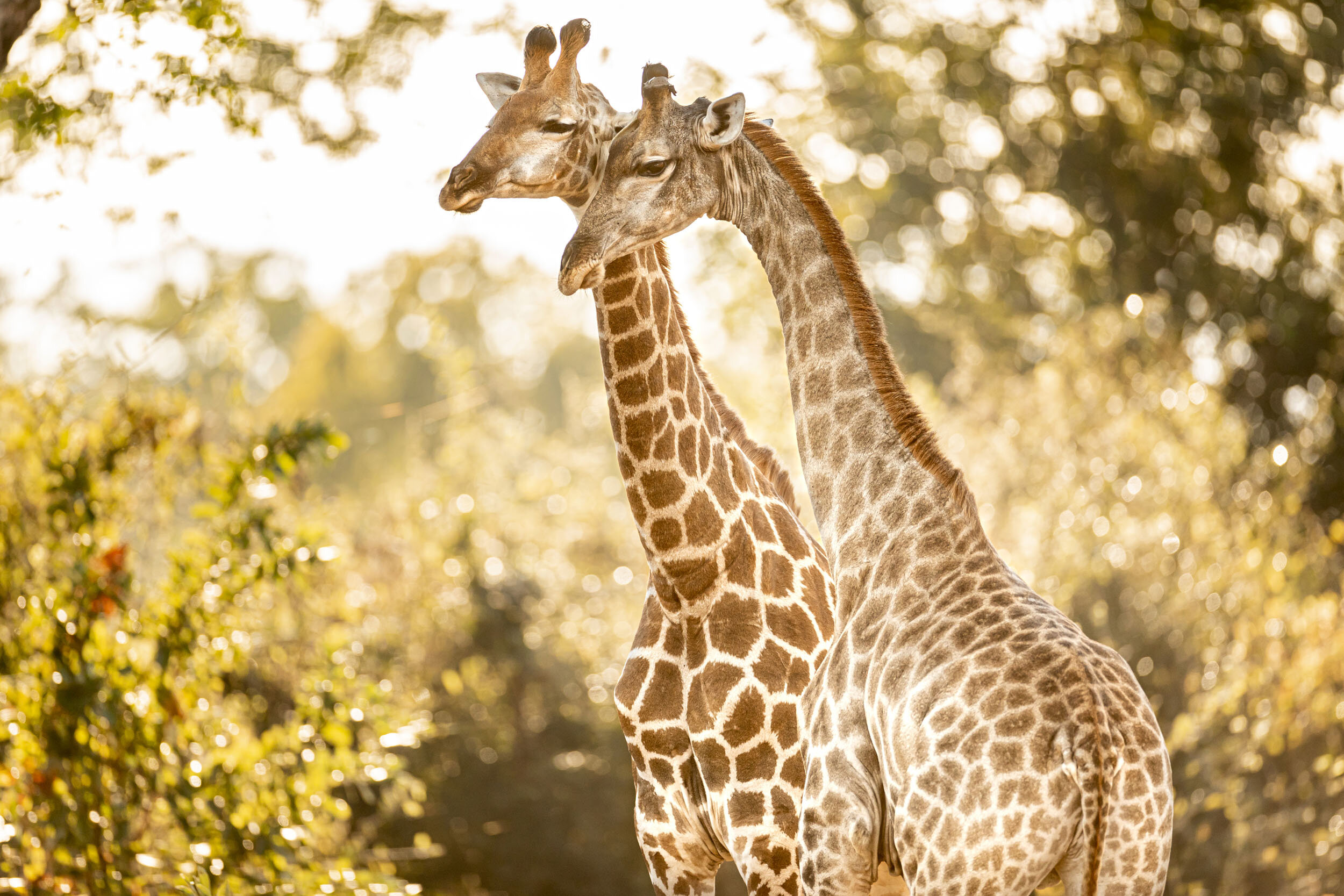
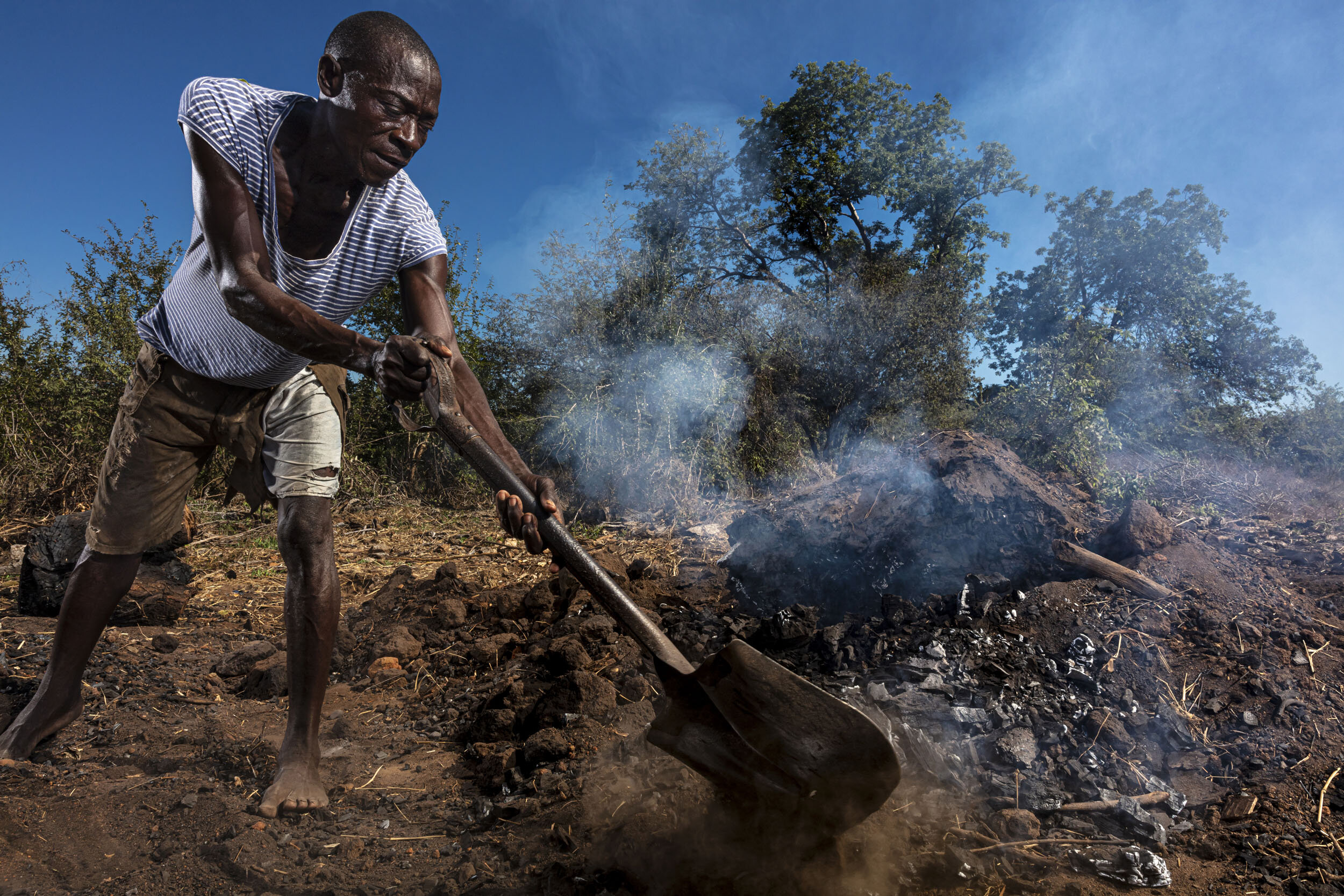
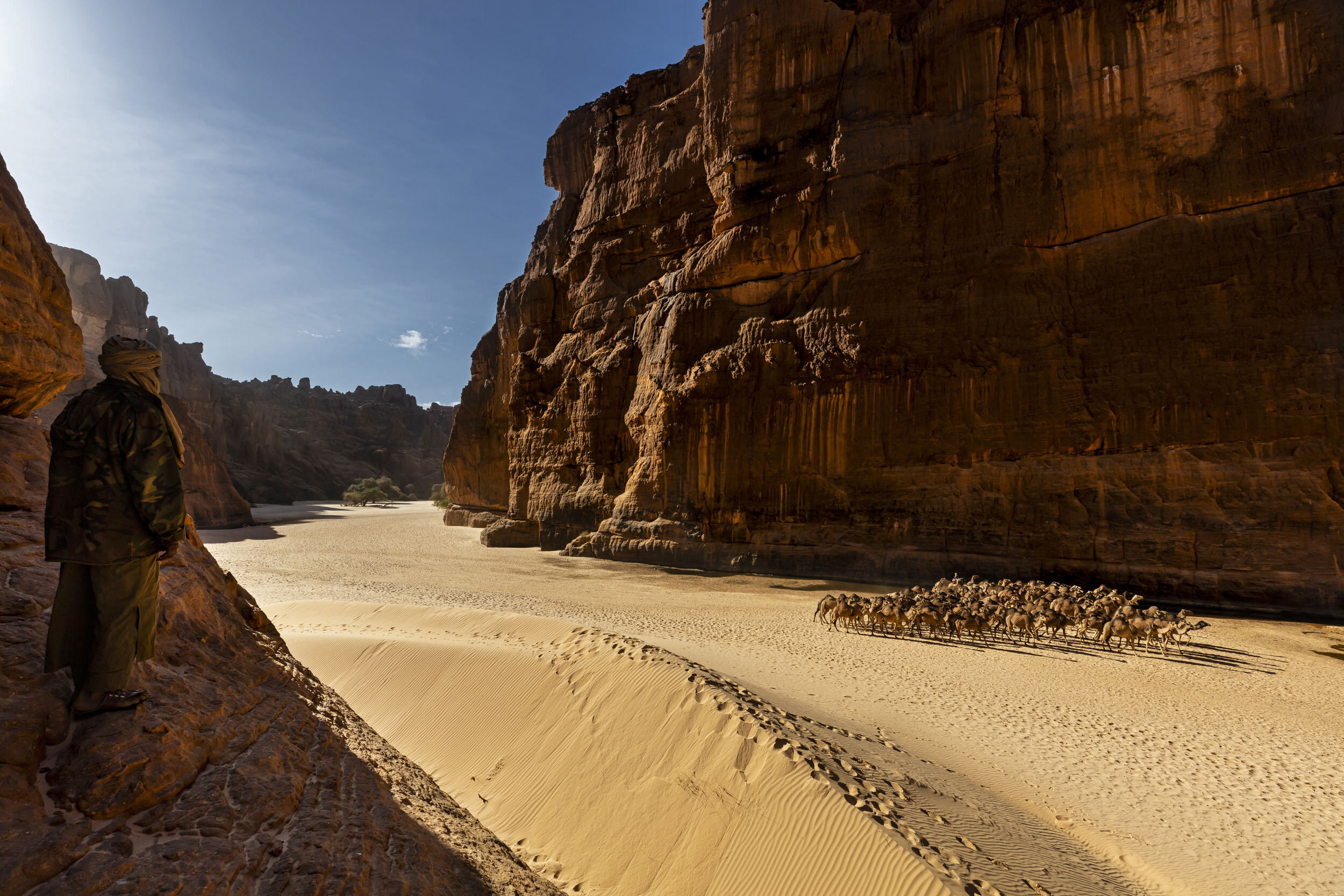
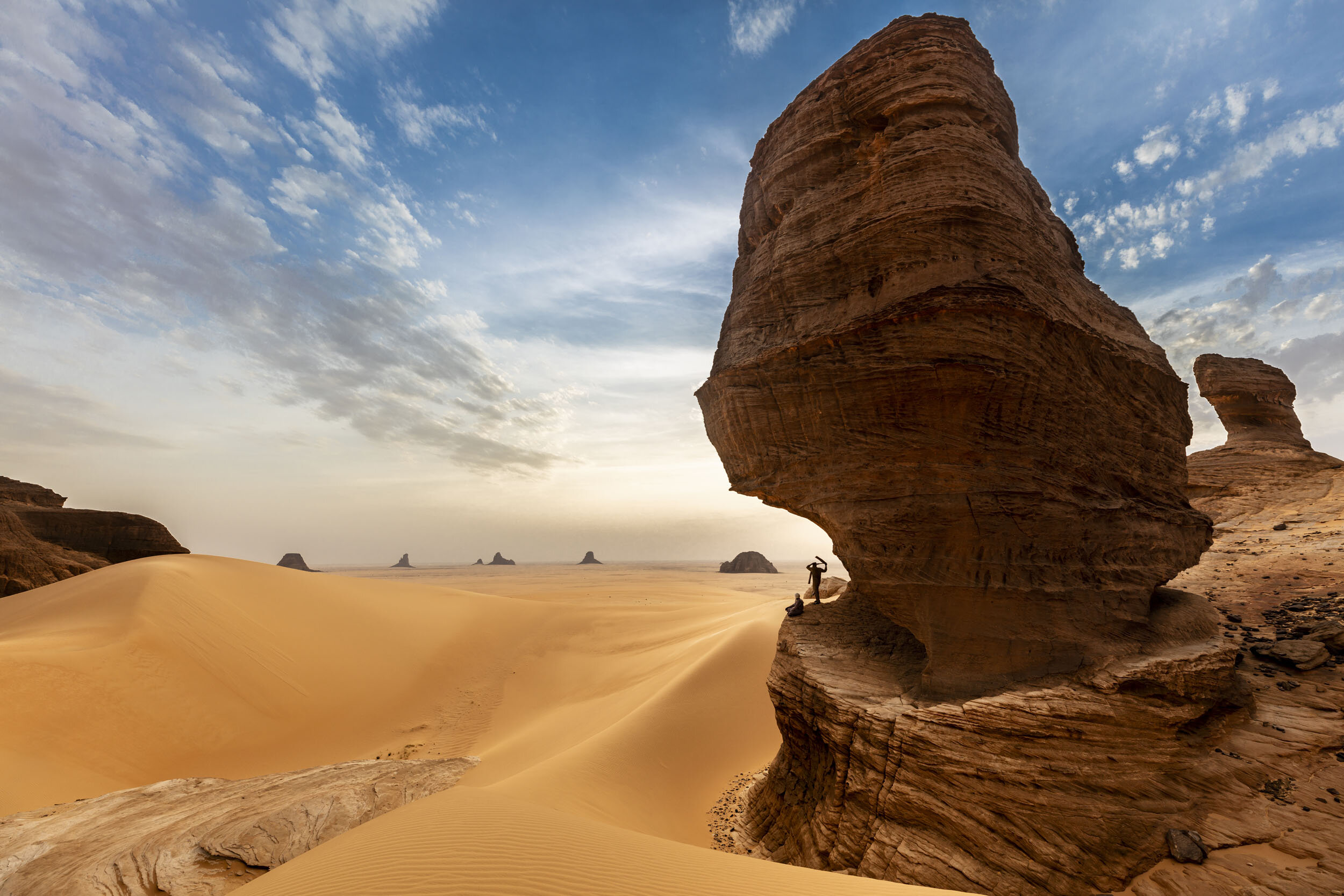
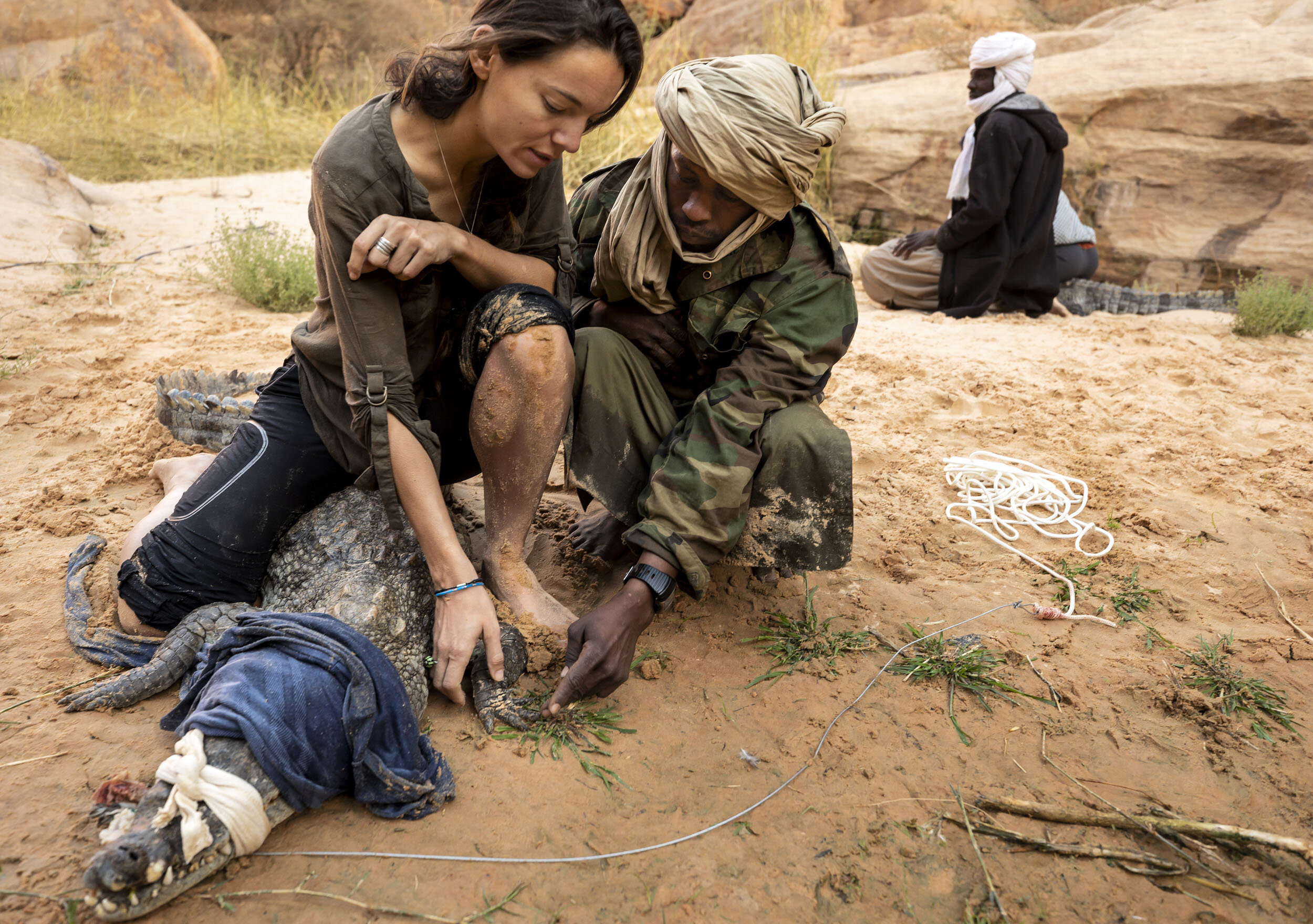
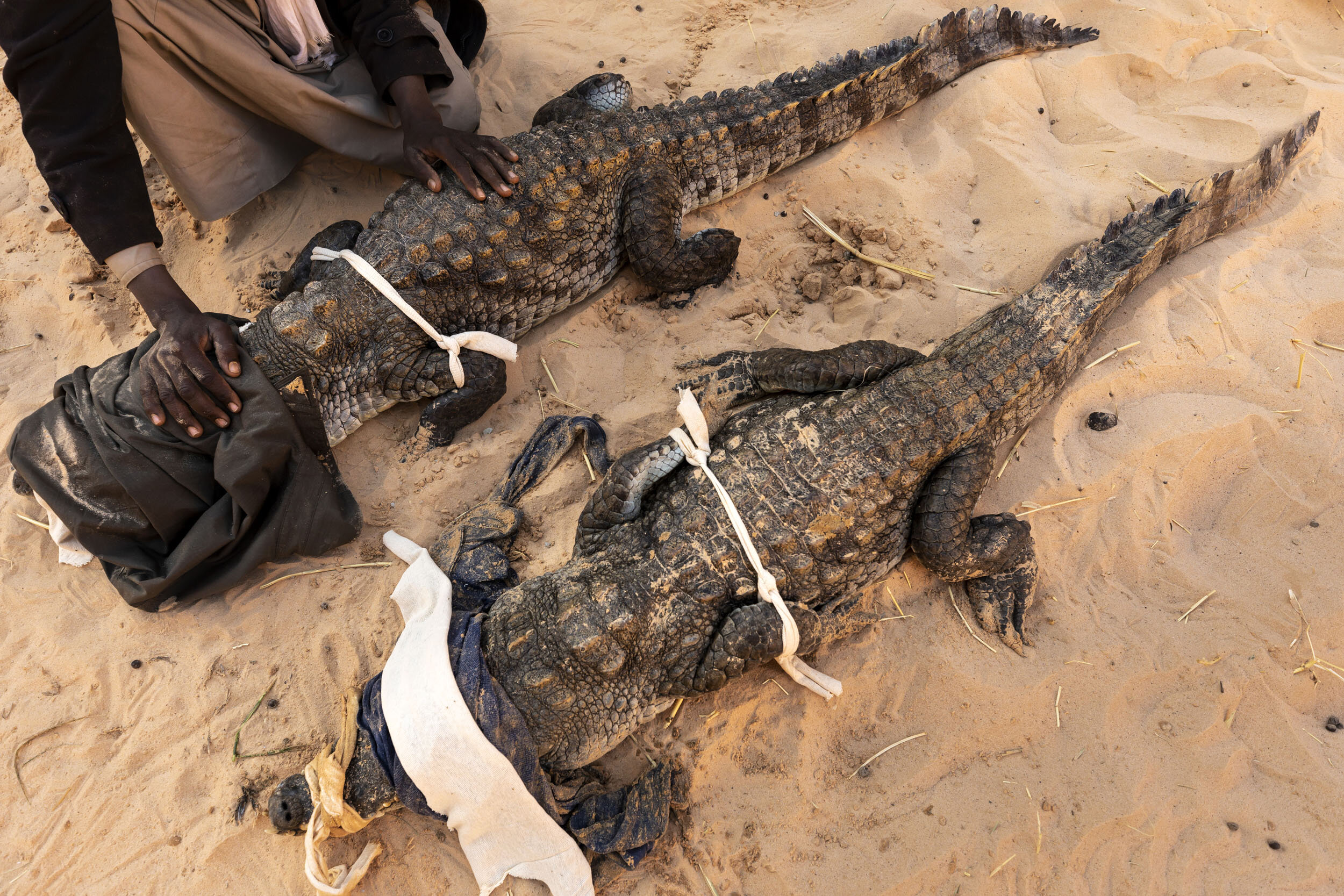

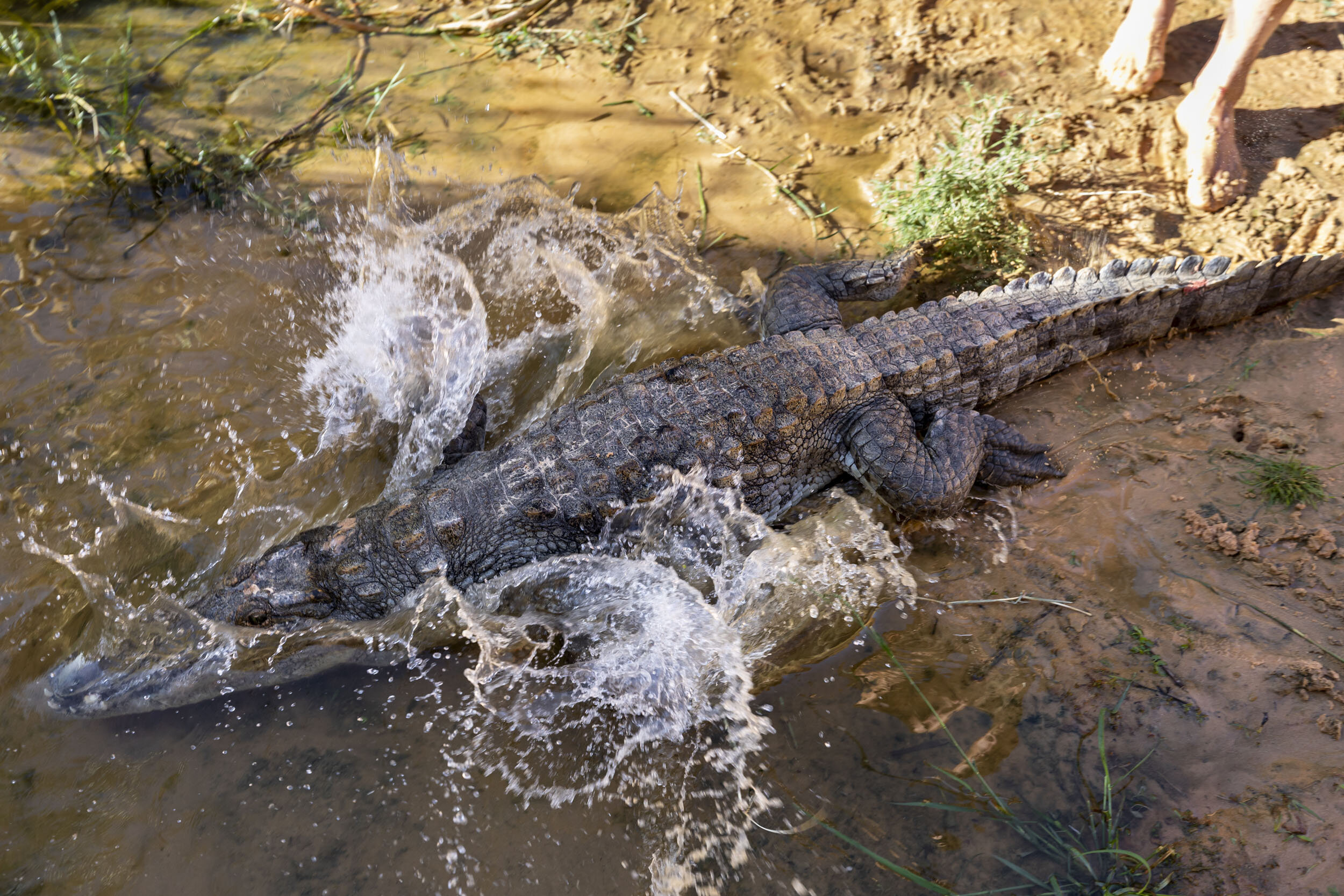
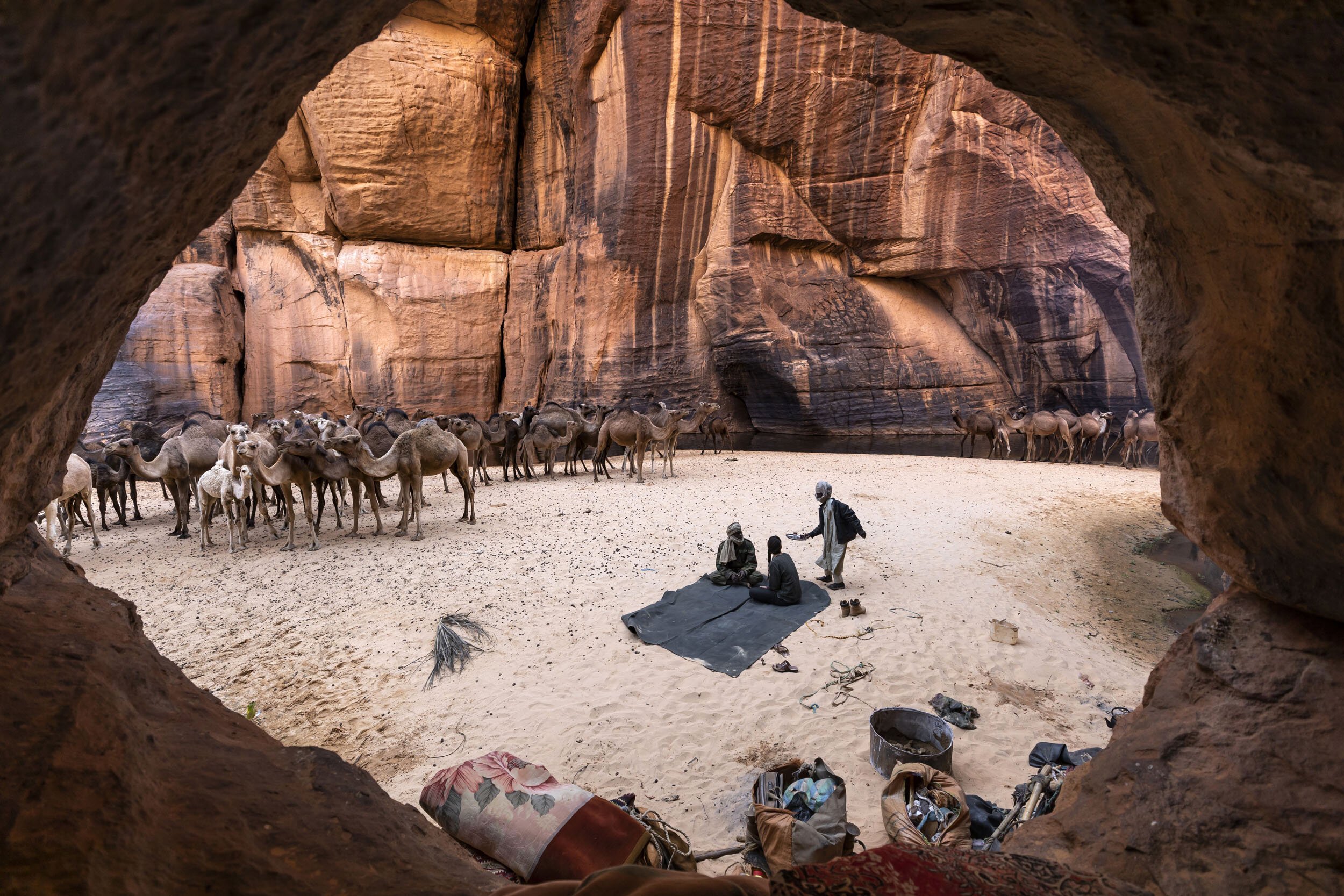
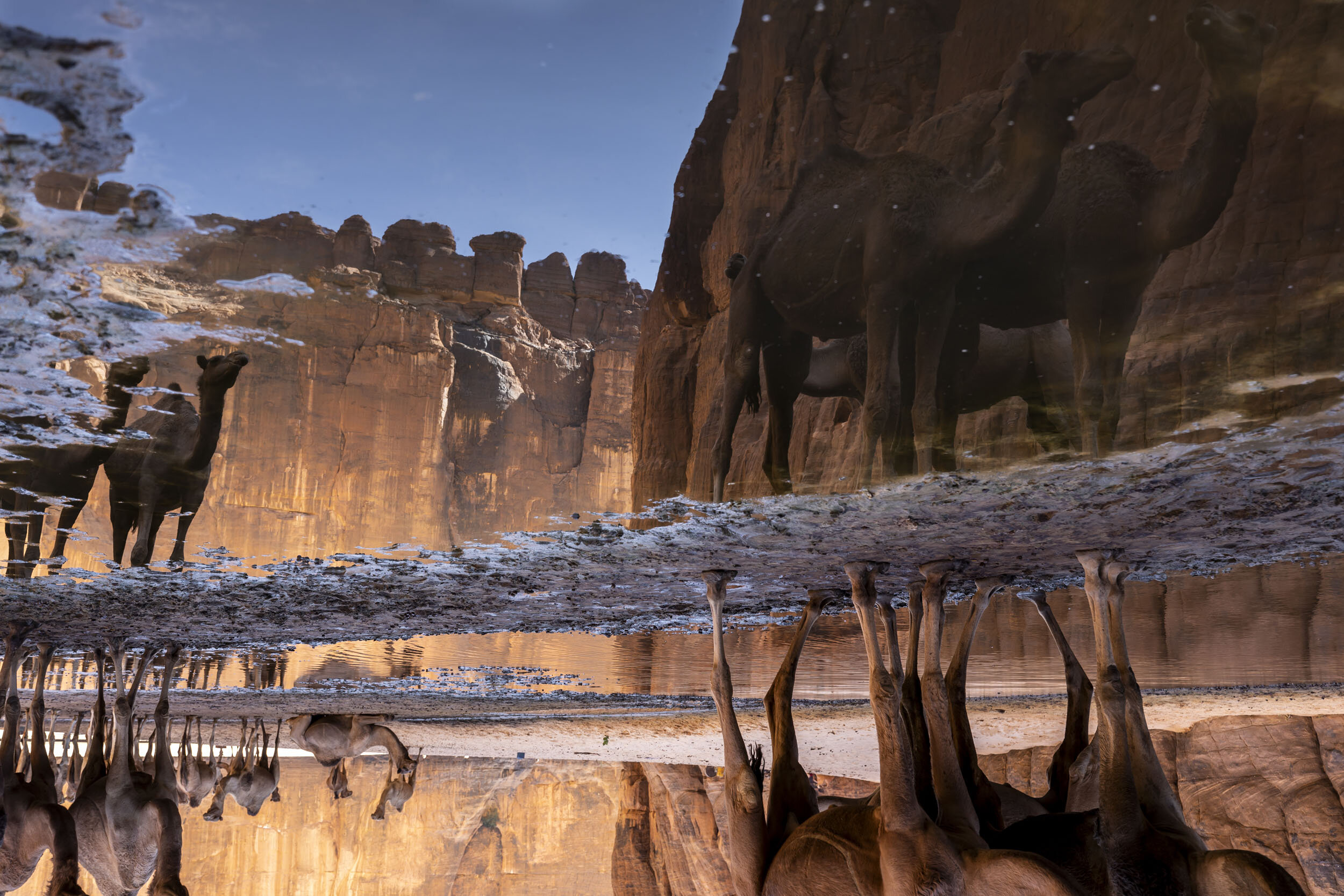
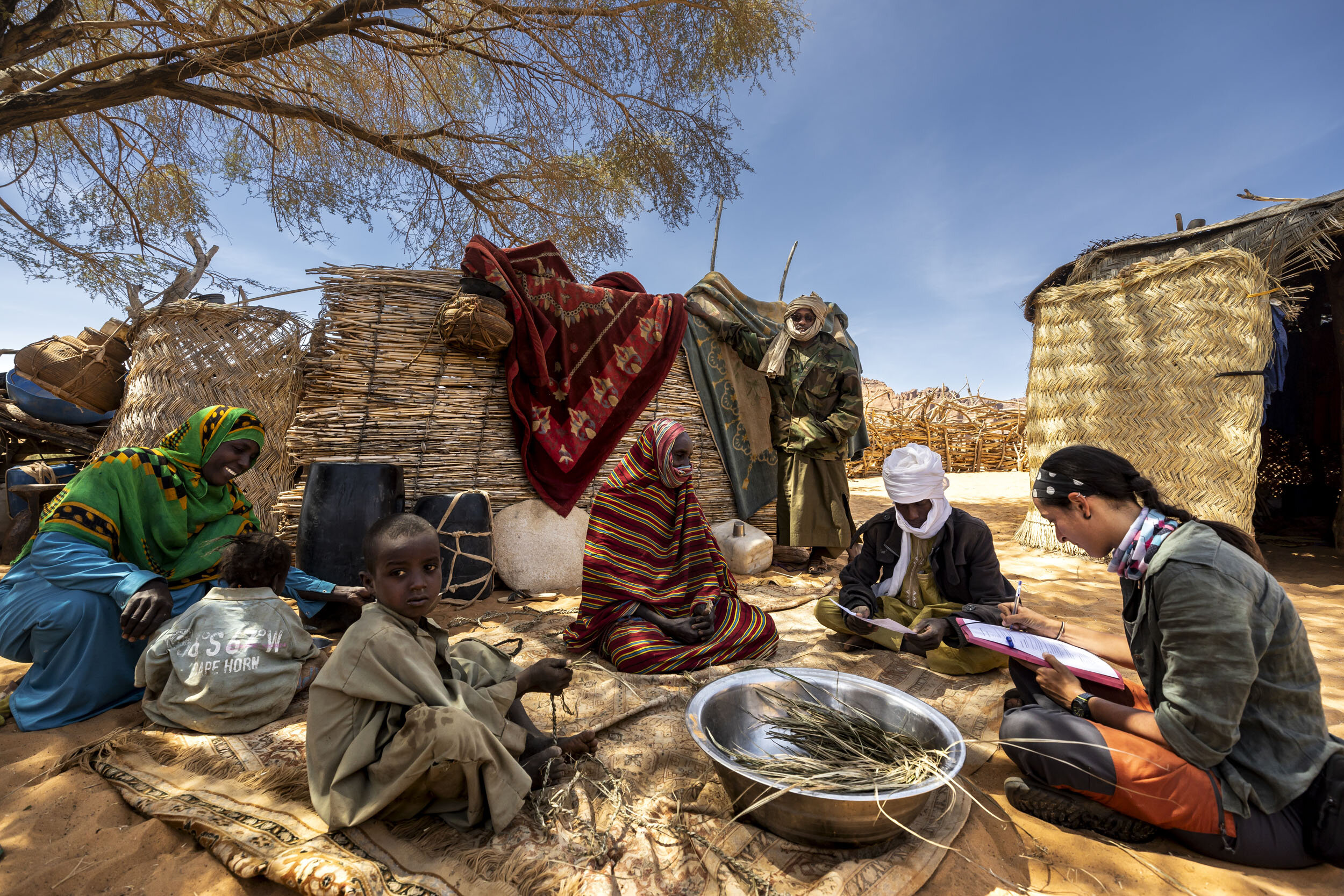
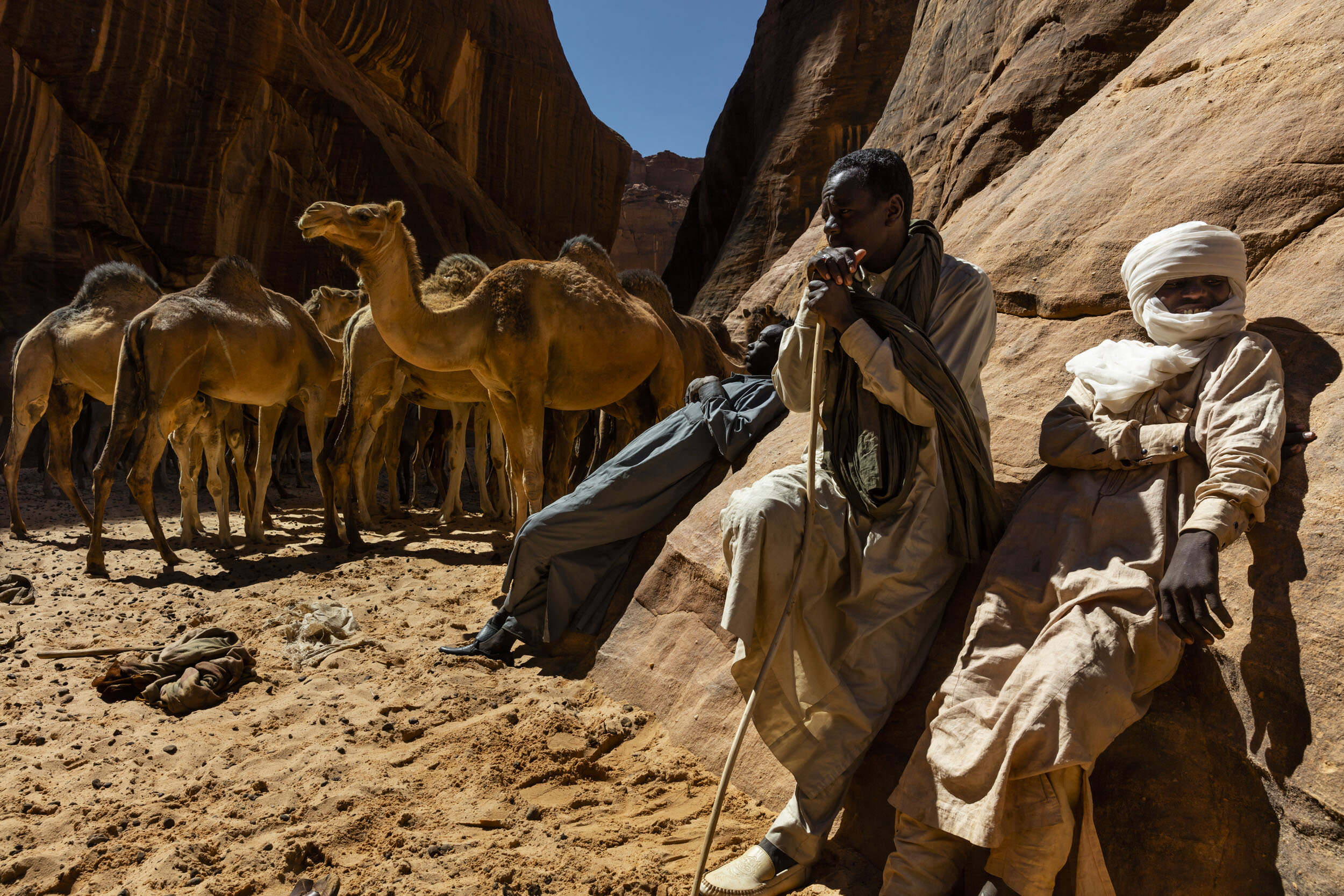

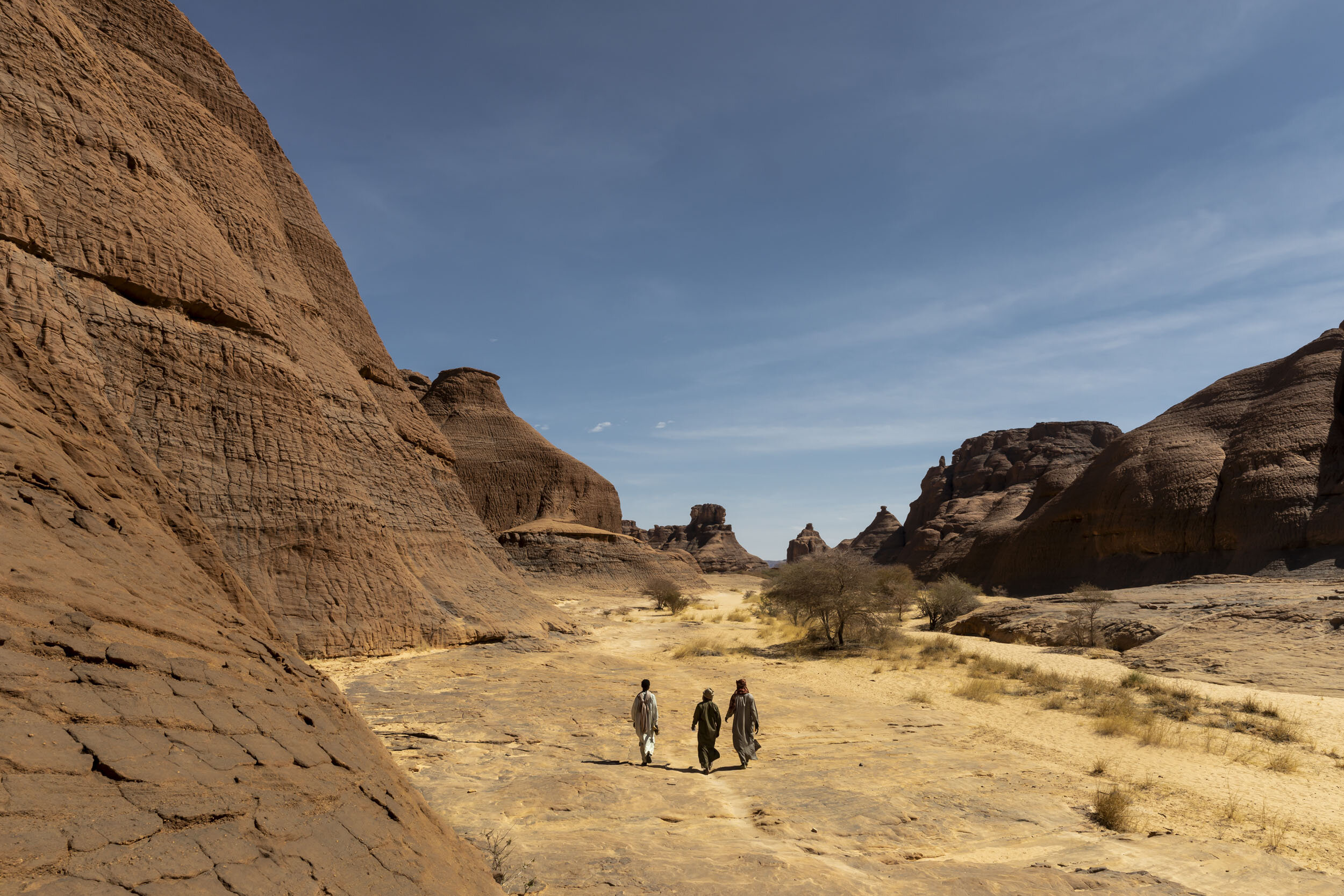
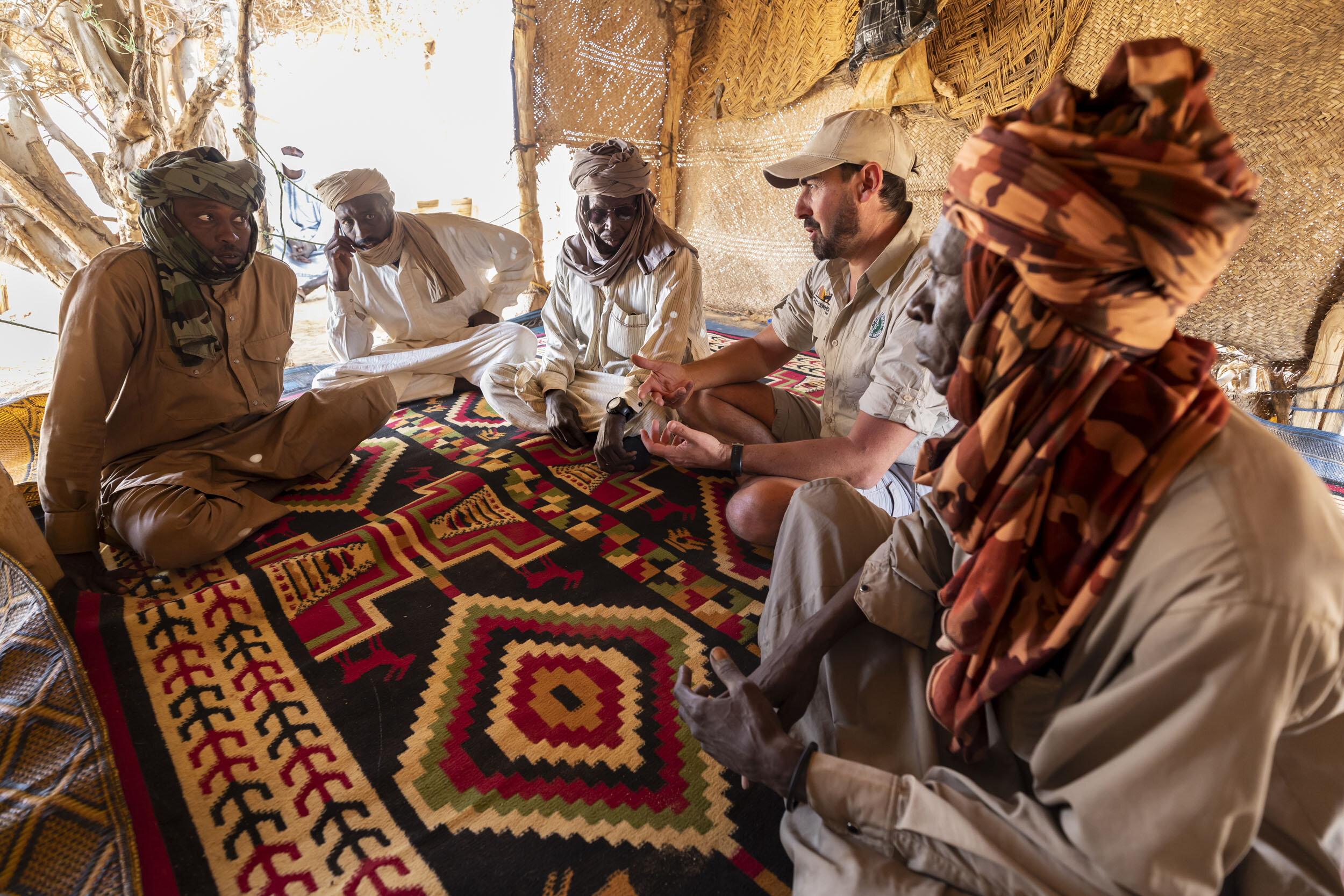
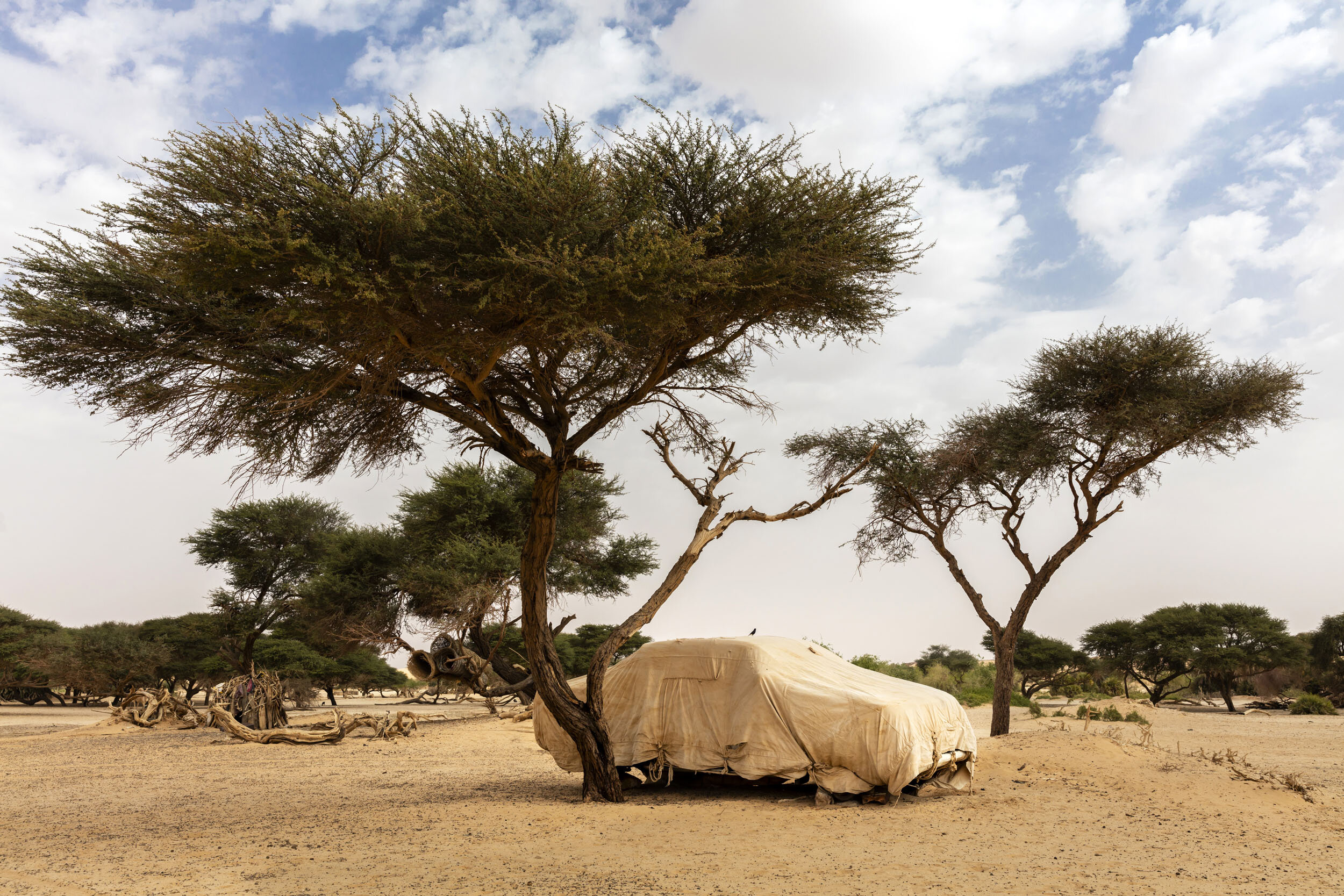
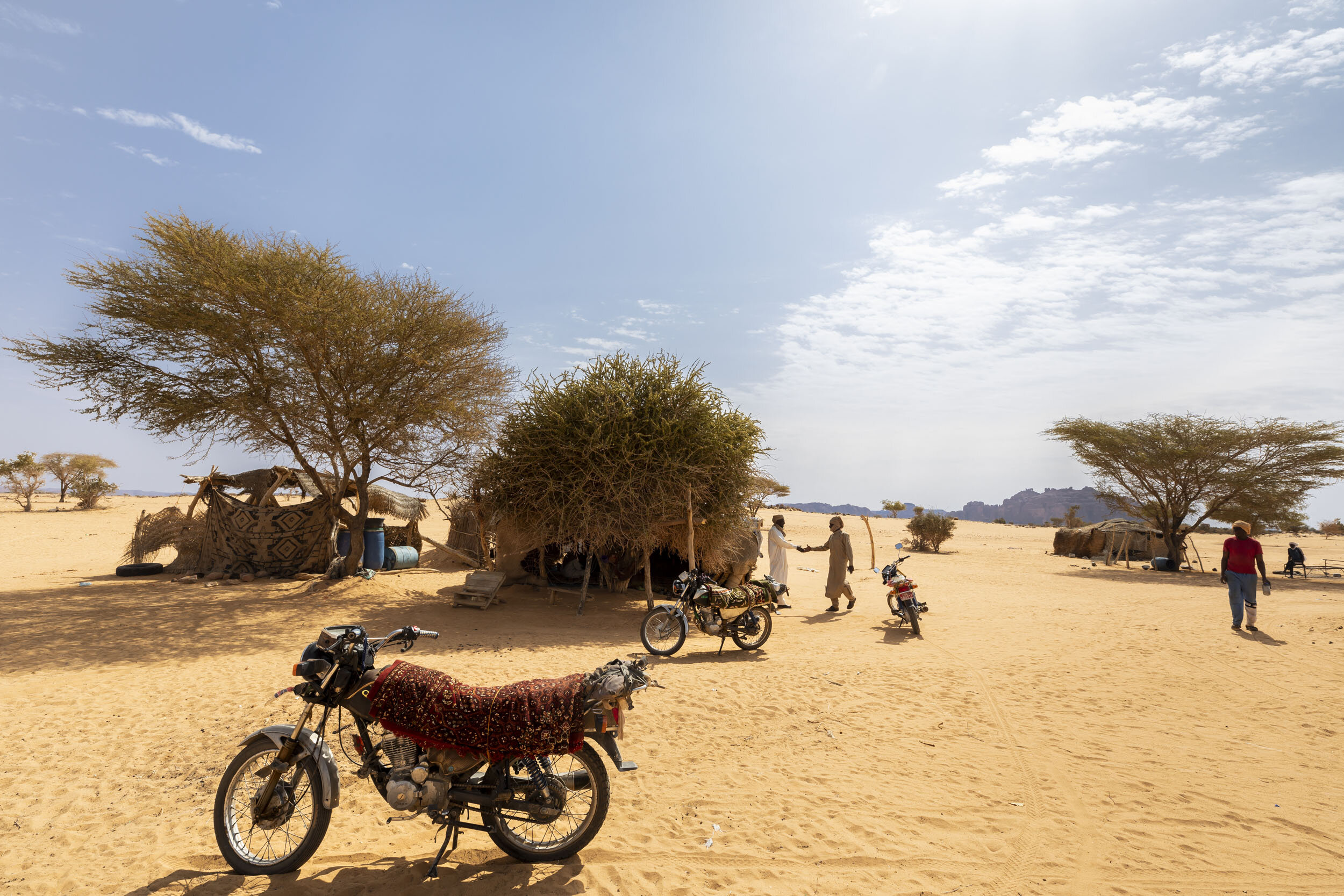

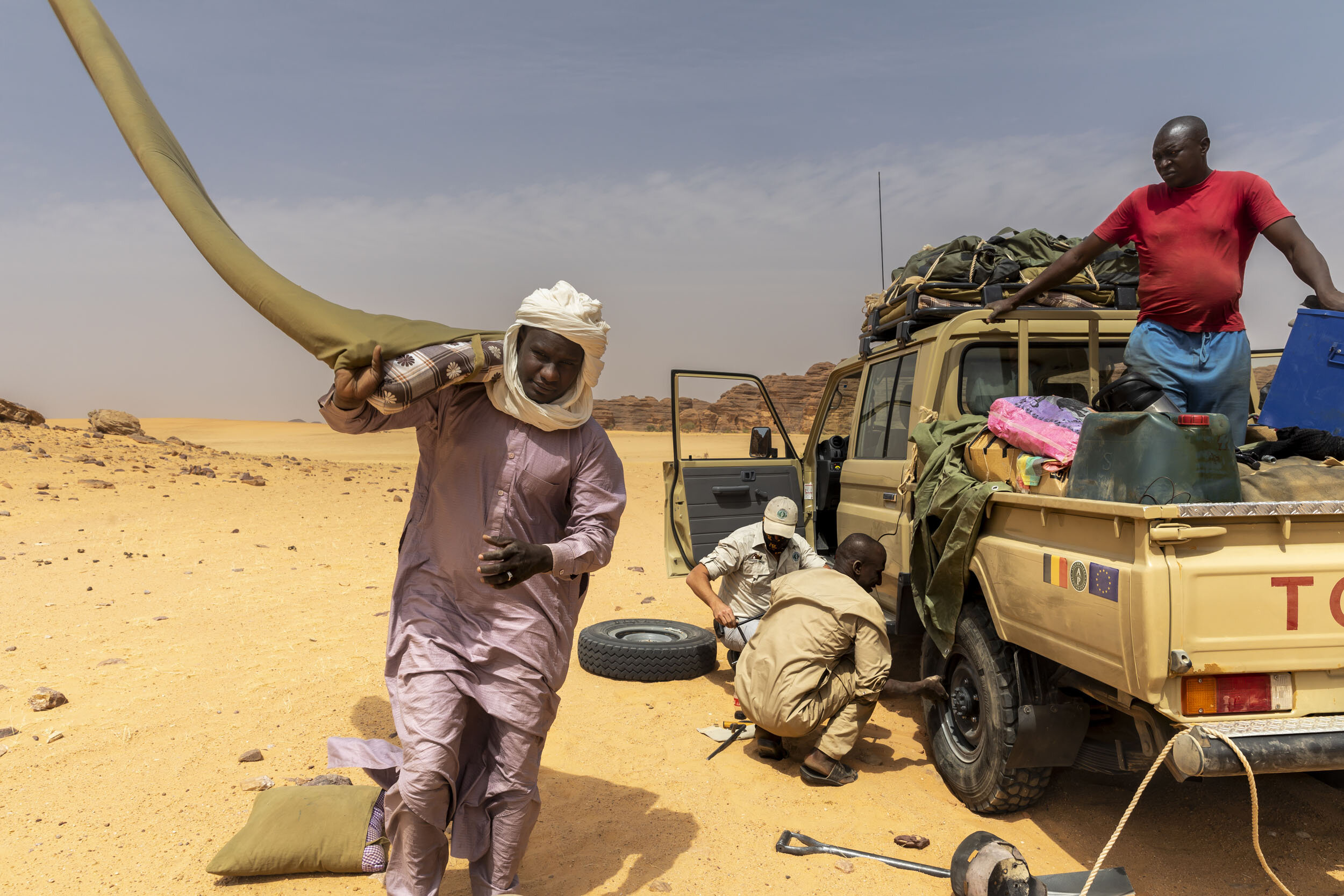
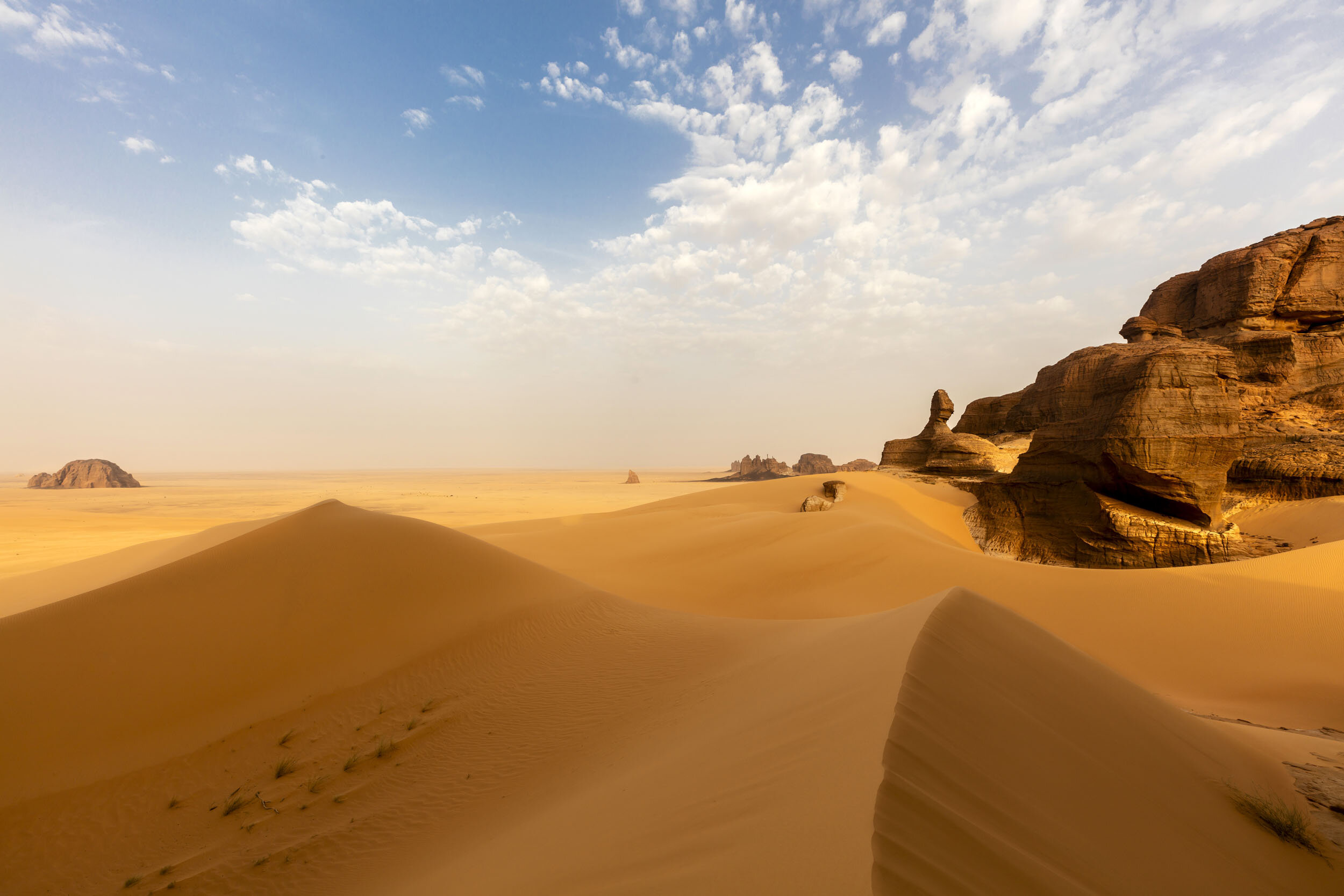
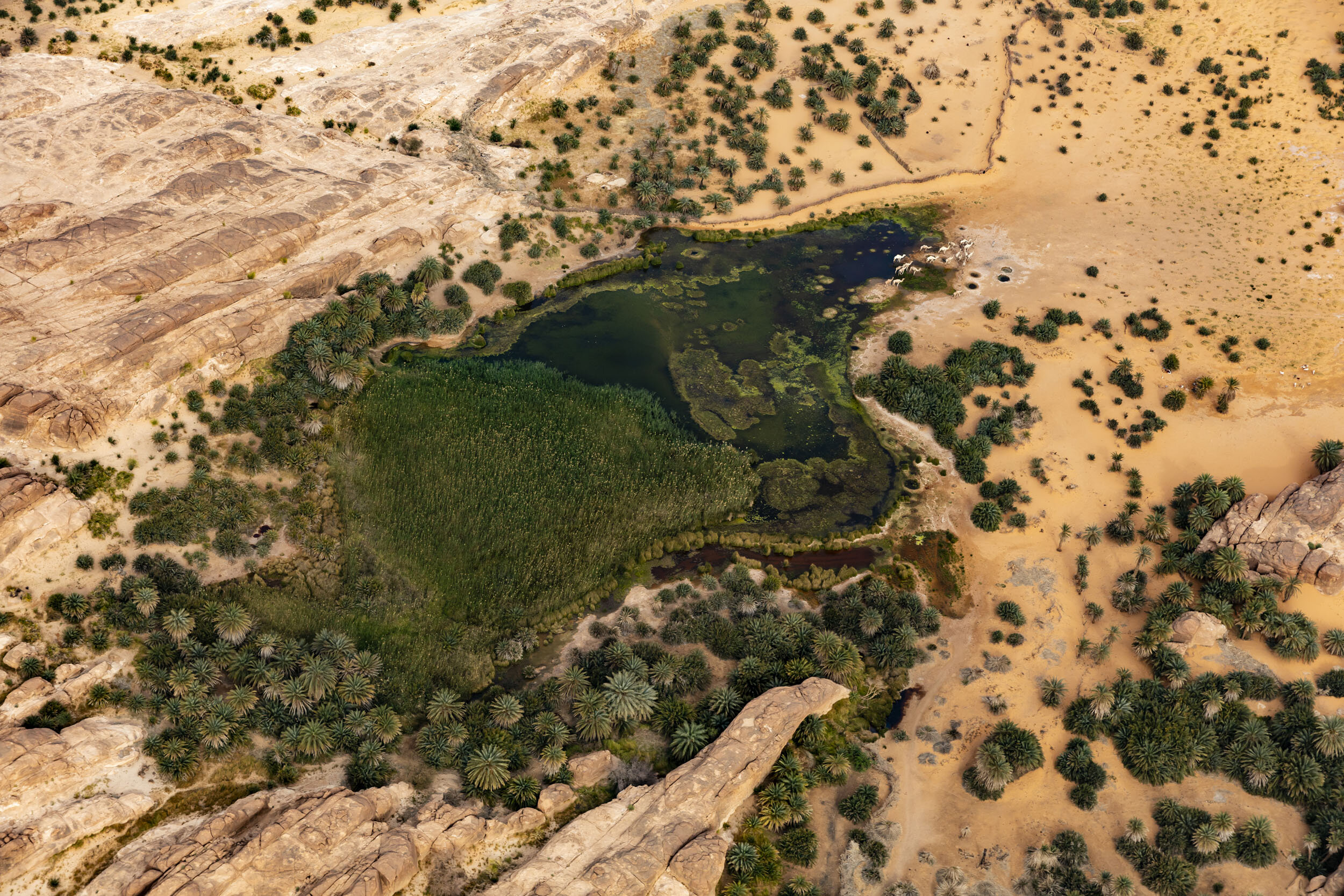

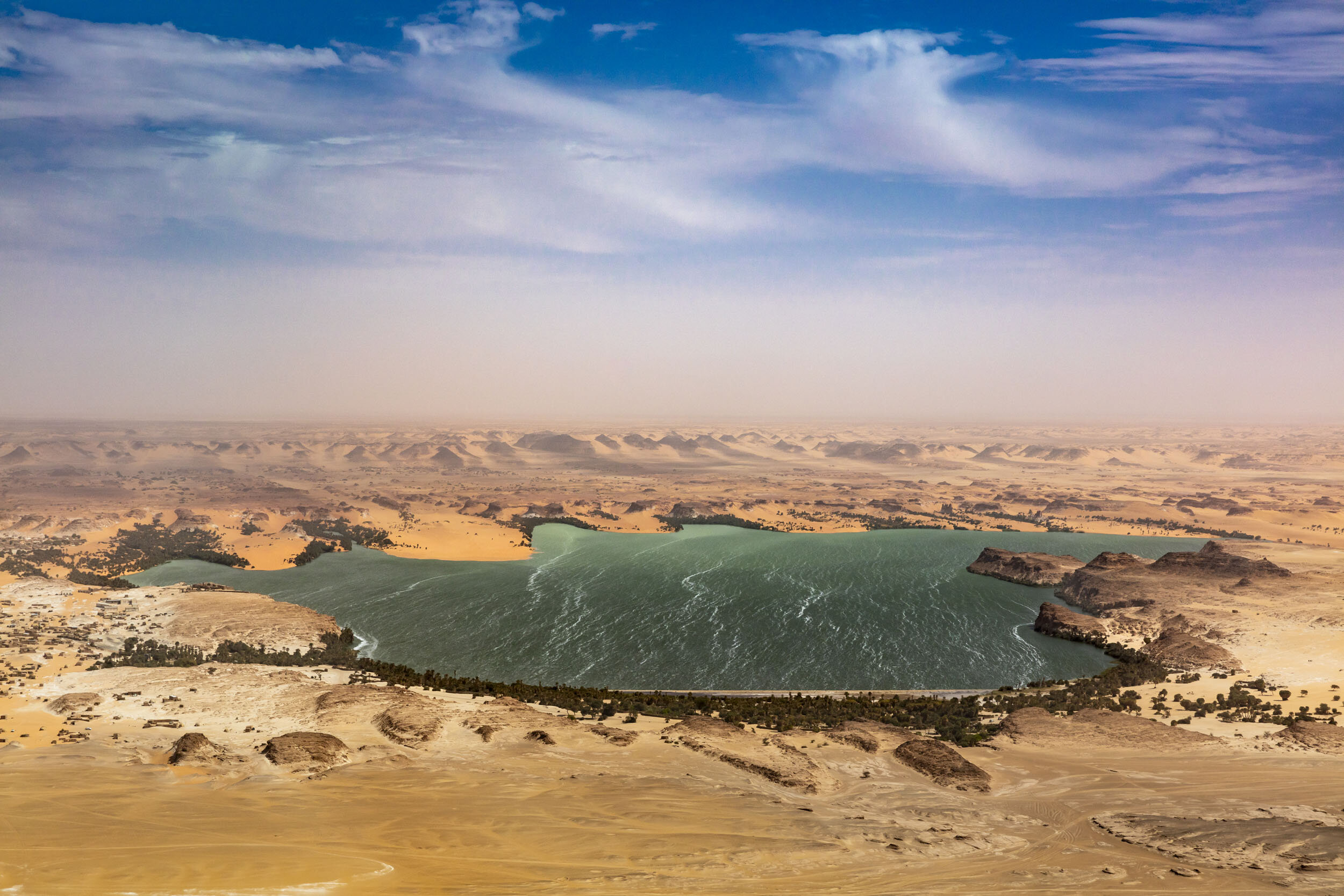
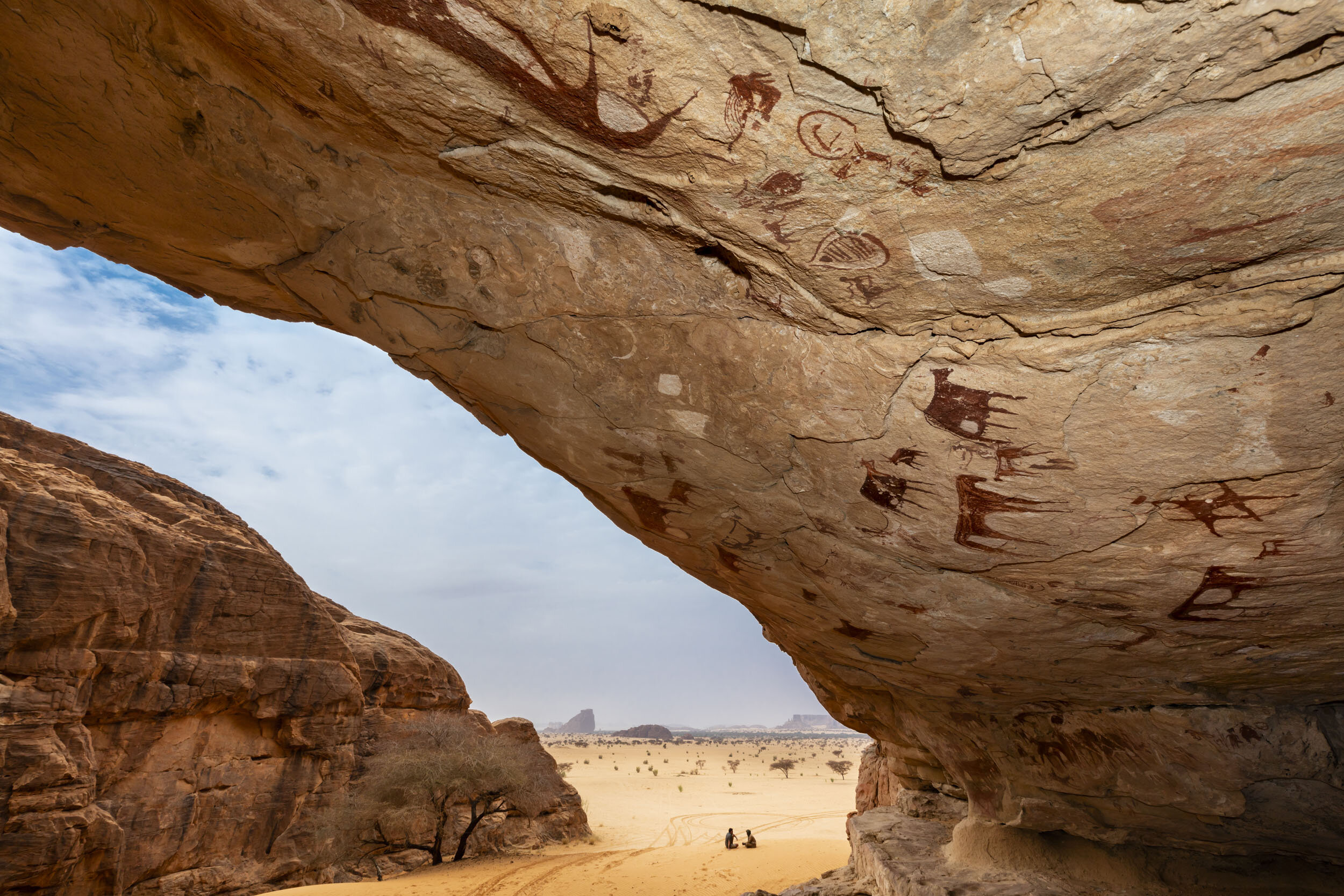
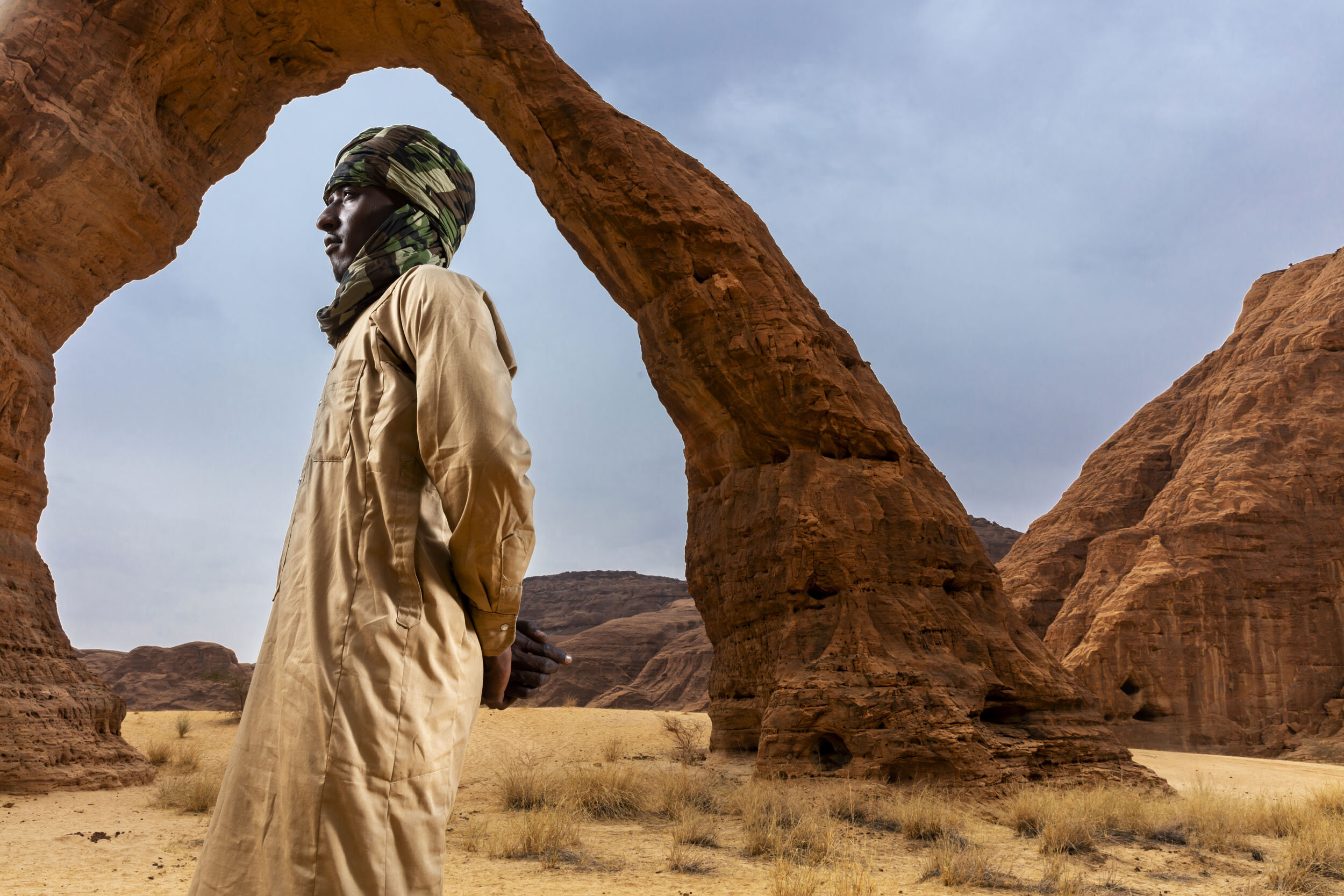
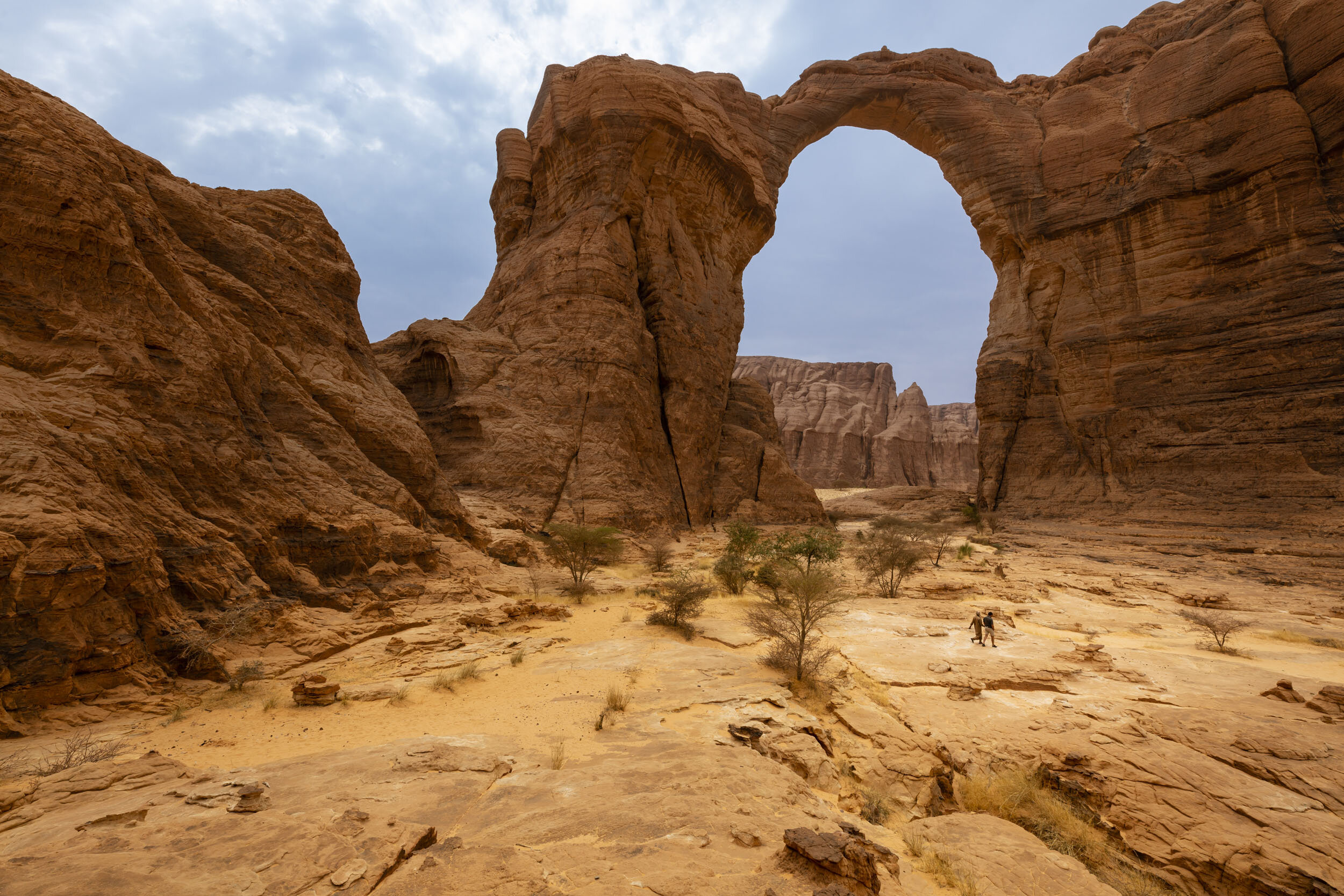
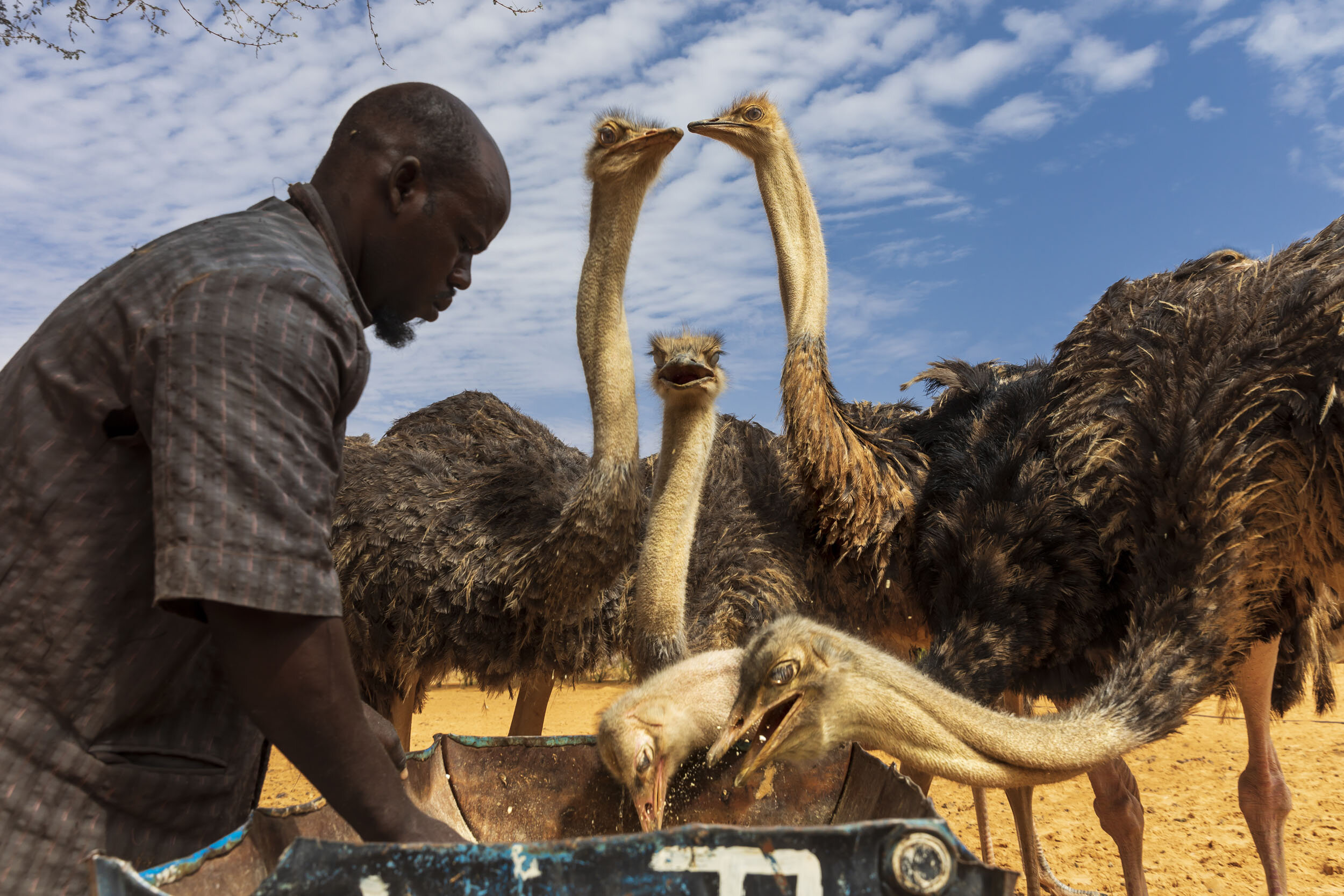

GARAMBA NATIONAL PARK, DEMOCRATIC REPUBLIC OF CONGO, APRIL 21 2019: Young Congolese conservation ranger Izako Vungunyesi is casevacked by helicopter after an incident with poachers inside the park. He was shot through the wrist and the AK 47 round also grazed his bicep. Two suspected south Sudanese elephants poachers were killed by his ranger group but not before they threw a grenade at the rangers, 4 poachers fled the scene and are being pursued by the Garamba authorities. Garamba has a very sophisticated GIS intelligence system which allows for some predictability in poacher movement. Two years previously 9 elephant were killed in this location. Today the rangers prevented a larger herd of 30-40 elephants from fired upon by these poachers, which would have led to a certain massacre. Garamba is a Park in North East DRC bordering South Sudan. It is one of Africa’s oldest and most complex parks, with a difficult history. It has for many years been an elephant poaching epicenter, with heavily armed Sudanese poachers and Lord’s Resistance Army militia’s both decimating elephant populations as well as targeting the local population. African Parks signed an MOU with the ICCN, Congo’s conservation authority, in 2005. Since then, a number of rangers have continued to die in the course of their duties but slowly the park has gained traction against local poachers and foreign armed groups. From 2016 law enforcement strategy has been completely overhauled, the rangers were better equipped and technology has become a vital component in the fight. Poaching of elephants was down 50% in 2017 and in the 2018 it was down further. Over 1200 elephants remain and over 40 of those have collars for monitoring purposes. Garamba is also home to some of the last remaining Kordofan giraffe population and there is an action plan for that population. In a region of almost no economic opportunity, Garamba employs almost 500 full time staff and almost 2000 short term contract workers. T
GARAMBA NATIONAL PARK, DEMOCRATIC REPUBLIC OF CONGO, APRIL 18TH 2019: ICCN conservation ranger Dog handlers receiving training on tracking and detection from Invictus K9 group. Garamba is a Park in North East DRC bordering South Sudan. It is one of Africa’s oldest and most complex parks, with a difficult history. It has for many years been an elephant poaching epicenter, with heavily armed Sudanese poachers and Lord’s Resistance Army militia’s both decimating elephant populations as well as targeting the local population. African Parks signed an MOU with the ICCN, Congo’s conservation authority, in 2005. Since then, a number of rangers have continued to die in the course of their duties but slowly the park has gained traction against local poachers and foreign armed groups. From 2016 law enforcement strategy has been completely overhauled, the rangers were better equipped and technology has become a vital component in the fight. Poaching of elephants was down 50% in 2017 and in the 2018 it was down further. Over 1200 elephants remain and over 40 of those have collars for monitoring purposes. Garamba is also home to some of the last remaining Kordofan giraffe population and there is an action plan for that population. In a region of almost no economic opportunity, Garamba employs almost 500 full time staff and almost 2000 short term contract workers. There is a large amount of illegal mining around Garamba and the park is actively involved in speaking with those miners about alternative livelihoods and how the park may help with that. The Ranger force is around 300 and they provide security to tens of thousands of people who live around the park as well as vulnerable refugee groups escaping conflict in the region. (PHOTO BY BRENT STIRTON/GETTY IMAGES FOR NATIONAL GEOGRAPHIC MAGAZINE)
GARAMBA NATIONAL PARK, DEMOCRATIC REPUBLIC OF CONGO, APRIL 21 2019: Head of Law Enforcement for Garamba National Park, Major Pascal Adrio Anguezi. Leadership is always a key issue for these rangers and there will be new officer training in the park shortly. Garamba is a Park in North East DRC bordering South Sudan. It is one of Africa’s oldest and most complex parks, with a difficult history. It has for many years been an elephant poaching epicenter, with heavily armed Sudanese poachers and Lord’s Resistance Army militia’s both decimating elephant populations as well as targeting the local population. African Parks signed an MOU with the ICCN, Congo’s conservation authority, in 2005. Since then, a number of rangers have continued to die in the course of their duties but slowly the park has gained traction against local poachers and foreign armed groups. From 2016 law enforcement strategy has been completely overhauled, the rangers were better equipped and technology has become a vital component in the fight. Poaching of elephants was down 50% in 2017 and in the 2018 it was down further. Over 1200 elephants remain and over 40 of those have collars for monitoring purposes. Garamba is also home to some of the last remaining Kordofan giraffe population and there is an action plan for that population. In a region of almost no economic opportunity, Garamba employs almost 500 full time staff and almost 2000 short term contract workers. There is a large amount of illegal mining around Garamba and the park is actively involved in speaking with those miners about alternative livelihoods and how the park may help with that. The Ranger force is around 300 and they provide security to tens of thousands of people who live around the park as well as vulnerable refugee groups escaping conflict in the region. (PHOTO BY BRENT STIRTON/GETTY IMAGES FOR NATIONAL GEOGRAPHIC MAGAZINE)
GARAMBA NATIONAL PARK, DEMOCRATIC REPUBLIC OF CONGO, APRIL 18TH 2019: A Garamba conservation ranger stands outside an ivory seizure room with tusks visible on the wall next to him. these tusks are consfiscated from clashes between the parks ranger force and poachers that range from armed locals to heavily armed militias like the Lords Resistance Army and militarized Sudanese poachers. Garamba is a Park in North East DRC bordering South Sudan. It is one of Africa’s oldest and most complex parks, with a difficult history. It has for many years been an elephant poaching epicenter, with heavily armed Sudanese poachers and Lord’s Resistance Army militia’s both decimating elephant populations as well as targeting the local population. African Parks signed an MOU with the ICCN, Congo’s conservation authority, in 2005. Since then, a number of rangers have continued to die in the course of their duties but slowly the park has gained traction against local poachers and foreign armed groups. From 2016 law enforcement strategy has been completely overhauled, the rangers were better equipped and technology has become a vital component in the fight. Poaching of elephants was down 50% in 2017 and in the 2018 it was down further. Over 1200 elephants remain and over 40 of those have collars for monitoring purposes. Garamba is also home to some of the last remaining Kordofan giraffe population and there is an action plan for that population. In a region of almost no economic opportunity, Garamba employs almost 500 full time staff and almost 2000 short term contract workers. There is a large amount of illegal mining around Garamba and the park is actively involved in speaking with those miners about alternative livelihoods and how the park may help with that. The Ranger force is around 300 and they provide security to tens of thousands of people who live around the park as well as vulnerable refugee groups escaping conflict in the region. (PHOTO BY BRENT STIRTON/GETTY IMAGES F
GARAMBA NATIONAL PARK, DEMOCRATIC REPUBLIC OF CONGO, APRIL 18TH 2019: ICCN conservation ranger Dog handlers receiving training on tracking and detection from Invictus K9 group. Garamba is a Park in North East DRC bordering South Sudan. It is one of Africa’s oldest and most complex parks, with a difficult history. It has for many years been an elephant poaching epicenter, with heavily armed Sudanese poachers and Lord’s Resistance Army militia’s both decimating elephant populations as well as targeting the local population. African Parks signed an MOU with the ICCN, Congo’s conservation authority, in 2005. Since then, a number of rangers have continued to die in the course of their duties but slowly the park has gained traction against local poachers and foreign armed groups. From 2016 law enforcement strategy has been completely overhauled, the rangers were better equipped and technology has become a vital component in the fight. Poaching of elephants was down 50% in 2017 and in the 2018 it was down further. Over 1200 elephants remain and over 40 of those have collars for monitoring purposes. Garamba is also home to some of the last remaining Kordofan giraffe population and there is an action plan for that population. In a region of almost no economic opportunity, Garamba employs almost 500 full time staff and almost 2000 short term contract workers. There is a large amount of illegal mining around Garamba and the park is actively involved in speaking with those miners about alternative livelihoods and how the park may help with that. The Ranger force is around 300 and they provide security to tens of thousands of people who live around the park as well as vulnerable refugee groups escaping conflict in the region. (PHOTO BY BRENT STIRTON/GETTY IMAGES FOR NATIONAL GEOGRAPHIC MAGAZINE)
GARAMBA NATIONAL PARK, DEMOCRATIC REPUBLIC OF CONGO, APRIL 18TH 2019: Deputy Chief of Wildlife Police John Dieu Atafo Aloma is seen inside the confiscations room doing inventory on recent seizures. He is holding a Okapi skin, two of which are visble in this image. This is a severely endangered animal of which only a handful remain. These skins were seized frm traffickers that Garamba’s intelliegence units tracked and captured. There is also a fresh lion skin and two leopard skins. All of these seized products will be sampled and DNA and SNP data will be used to add to the body of knowledge on Garamba’s animal population. Garamba is a Park in North East DRC bordering South Sudan. It is one of Africa’s oldest and most complex parks, with a difficult history. It has for many years been an elephant poaching epicenter, with heavily armed Sudanese poachers and Lord’s Resistance Army militia’s both decimating elephant populations as well as targeting the local population. African Parks signed an MOU with the ICCN, Congo’s conservation authority, in 2005. Since then, a number of rangers have continued to die in the course of their duties but slowly the park has gained traction against local poachers and foreign armed groups. From 2016 law enforcement strategy has been completely overhauled, the rangers were better equipped and technology has become a vital component in the fight. Poaching of elephants was down 50% in 2017 and in the 2018 it was down further. Over 1200 elephants remain and over 40 of those have collars for monitoring purposes. Garamba is also home to some of the last remaining Kordofan giraffe population and there is an action plan for that population. In a region of almost no economic opportunity, Garamba employs almost 500 full time staff and almost 2000 short term contract workers. There is a large amount of illegal mining around Garamba and the park is actively involved in speaking with those miners about alternative livelihoods and how the p
GARAMBA NATIONAL PARK, DEMOCRATIC REPUBLIC OF CONGO, APRIL 21 2019: Easter church services for the familes of Rangers and Staff inside Garamba National Park. Garamba is a Park in North East DRC bordering South Sudan. It is one of Africa’s oldest and most complex parks, with a difficult history. It has for many years been an elephant poaching epicenter, with heavily armed Sudanese poachers and Lord’s Resistance Army militia’s both decimating elephant populations as well as targeting the local population. African Parks signed an MOU with the ICCN, Congo’s conservation authority, in 2005. Since then, a number of rangers have continued to die in the course of their duties but slowly the park has gained traction against local poachers and foreign armed groups. From 2016 law enforcement strategy has been completely overhauled, the rangers were better equipped and technology has become a vital component in the fight. Poaching of elephants was down 50% in 2017 and in the 2018 it was down further. Over 1200 elephants remain and over 40 of those have collars for monitoring purposes. Garamba is also home to some of the last remaining Kordofan giraffe population and there is an action plan for that population. In a region of almost no economic opportunity, Garamba employs almost 500 full time staff and almost 2000 short term contract workers. There is a large amount of illegal mining around Garamba and the park is actively involved in speaking with those miners about alternative livelihoods and how the park may help with that. The Ranger force is around 300 and they provide security to tens of thousands of people who live around the park as well as vulnerable refugee groups escaping conflict in the region. (PHOTO BY BRENT STIRTON/GETTY IMAGES FOR NATIONAL GEOGRAPHIC MAGAZINE)
GARAMBA NATIONAL PARK, DEMOCRATIC REPUBLIC OF CONGO, APRIL 24 2019: Magunda hill is one of the tallest areas inside Garamba and African Parks have built an observation post at this strategic site. Rangers are rotated in and out of this site on a weekly basis, on the lookout for people and militia groups entering the park to hunt its animals. Garamba is a Park in North East DRC bordering South Sudan. It is one of Africa’s oldest and most complex parks, with a difficult history. It has for many years been an elephant poaching epicenter, with heavily armed Sudanese poachers and Lord’s Resistance Army militia’s both decimating elephant populations as well as targeting the local population. African Parks signed an MOU with the ICCN, Congo’s conservation authority, in 2005. Since then, a number of rangers have continued to die in the course of their duties but slowly the park has gained traction against local poachers and foreign armed groups. From 2016 law enforcement strategy has been completely overhauled, the rangers were better equipped and technology has become a vital component in the fight. Poaching of elephants was down 50% in 2017 and in the 2018 it was down further. Over 1200 elephants remain and over 40 of those have collars for monitoring purposes. Garamba is also home to some of the last remaining Kordofan giraffe population and there is an action plan for that population. In a region of almost no economic opportunity, Garamba employs almost 500 full time staff and almost 2000 short term contract workers. There is a large amount of illegal mining around Garamba and the park is actively involved in speaking with those miners about alternative livelihoods and how the park may help with that. The Ranger force is around 300 and they provide security to tens of thousands of people who live around the park as well as vulnerable refugee groups escaping conflict in the region. (PHOTO BY BRENT STIRTON/GETTY IMAGES FOR NATIONAL GEOGRAPHIC MAGAZINE)
GARAMBA NATIONAL PARK, DEMOCRATIC REPUBLIC OF CONGO, APRIL 21 2019: Illegal gold mining operations in the Sambia region on the border regions of Garamba National Park. The Park runs a Artisinal mining program, communicating directly with the 20, 000 informal miners, this is run by African Parks Pauline Voga. This is a sensitive issue and the Park desires to confine the mining to where it is and not have it spread further into the park. Garamba is a Park in North East DRC bordering South Sudan. It is one of Africa’s oldest and most complex parks, with a difficult history. It has for many years been an elephant poaching epicenter, with heavily armed Sudanese poachers and Lord’s Resistance Army militia’s both decimating elephant populations as well as targeting the local population. African Parks signed an MOU with the ICCN, Congo’s conservation authority, in 2005. Since then, a number of rangers have continued to die in the course of their duties but slowly the park has gained traction against local poachers and foreign armed groups. From 2016 law enforcement strategy has been completely overhauled, the rangers were better equipped and technology has become a vital component in the fight. Poaching of elephants was down 50% in 2017 and in the 2018 it was down further. Over 1200 elephants remain and over 40 of those have collars for monitoring purposes. Garamba is also home to some of the last remaining Kordofan giraffe population and there is an action plan for that population. In a region of almost no economic opportunity, Garamba employs almost 500 full time staff and almost 2000 short term contract workers. There is a large amount of illegal mining around Garamba and the park is actively involved in speaking with those miners about alternative livelihoods and how the park may help with that. The Ranger force is around 300 and they provide security to tens of thousands of people who live around the park as well as vulnerable refugee groups escaping conflict
GARAMBA NATIONAL PARK, DEMOCRATIC REPUBLIC OF CONGO, APRIL 21 2019: Illegal gold mining operations in the Sambia region on the border regions of Garamba National Park. The Park runs a Artisinal mining program, communicating directly with the 20, 000 informal miners, this is run by African Parks Pauline Voga. This is a sensitive issue and the Park desires to confine the mining to where it is and not have it spread further into the park. Garamba is a Park in North East DRC bordering South Sudan. It is one of Africa’s oldest and most complex parks, with a difficult history. It has for many years been an elephant poaching epicenter, with heavily armed Sudanese poachers and Lord’s Resistance Army militia’s both decimating elephant populations as well as targeting the local population. African Parks signed an MOU with the ICCN, Congo’s conservation authority, in 2005. Since then, a number of rangers have continued to die in the course of their duties but slowly the park has gained traction against local poachers and foreign armed groups. From 2016 law enforcement strategy has been completely overhauled, the rangers were better equipped and technology has become a vital component in the fight. Poaching of elephants was down 50% in 2017 and in the 2018 it was down further. Over 1200 elephants remain and over 40 of those have collars for monitoring purposes. Garamba is also home to some of the last remaining Kordofan giraffe population and there is an action plan for that population. In a region of almost no economic opportunity, Garamba employs almost 500 full time staff and almost 2000 short term contract workers. There is a large amount of illegal mining around Garamba and the park is actively involved in speaking with those miners about alternative livelihoods and how the park may help with that. The Ranger force is around 300 and they provide security to tens of thousands of people who live around the park as well as vulnerable refugee groups escaping conflict
ZAKOUMA, CHAD, MARCH 2019: Newly qualifed Mamba teams conservation rangers and small teams rangers are seen marching at their graduation ceremony in Zakouma National Park. The Park is a 1,158-square-mile national park in southeastern Chad's Salamat Region. Zakouma is the nation's oldest national park, declared a national park in 1963 by presidential decree, giving it the highest form of protection available under the nation's laws. It has been managed by the nonprofit conservation organization African Parks since 2010 in partnership with Chad's government. Zakouma had more than 4,000 elephants in 2002, but fewer than 900 in 2005, and approximately 400–450 by 2010. Thanks for effective anti-poaching techniques by Africa Parks management, elephant numbers are recovering, there are a large number of new births in the herd and the elephants are dispersing rather than staying together all the time for protection. Zakouma is Chad's oldest national park, established by the nation's government in 1963. It’s wildlife have been threatened by the ivory trade and poaching, including by Sudanese Janjaweed members. In 2007, militia forces attacked the park's headquarters for its stockpile of 1.5 tons of ivory and killed three rangers. The government of Chad began working with African Parks in 2010 to help manage and protect the park and its wildlife, especially elephants. The park's anti-poaching strategy includes equipping rangers with military style training and weapons, GPS tracking units and radios to improve communications, mobility, and safety, as well as improving mobility through the use of four by fours, horses and air support. Local communities have also been recruited to supply intelligence on any groups moving into the area. Elephant matriarchs are collared and their groups are followed 24/7. There are always rangers within proximity of the herd. The European Union pledged €6.9m in 2011 to help protect the park for five years. Elephant protection efforts expande
ZAKOUMA, CHAD, MARCH 2019: Members of Mamba Team One travel through the bushy on top of their vehicle in ready position as a security precaution against heavily armed poachers. A number of rangers have died in deadly clashes and military style defenisve techniques are part of their training. Zakouma National Park is a 1,158-square-mile national park in southeastern Chad's Salamat Region. Zakouma is the nation's oldest national park, declared a national park in 1963 by presidential decree, giving it the highest form of protection available under the nation's laws. It has been managed by the nonprofit conservation organization African Parks since 2010 in partnership with Chad's government. Zakouma had more than 4,000 elephants in 2002, but fewer than 900 in 2005, and approximately 400–450 by 2010. Thanks for effective anti-poaching techniques by Africa Parks management, elephant numbers are recovering, there are a large number of new births in the herd and the elephants are dispersing rather than staying together all the time for protection. Zakouma is Chad's oldest national park, established by the nation's government in 1963. It’s wildlife have been threatened by the ivory trade and poaching, including by Sudanese Janjaweed members. In 2007, militia forces attacked the park's headquarters for its stockpile of 1.5 tons of ivory and killed three rangers. The government of Chad began working with African Parks in 2010 to help manage and protect the park and its wildlife, especially elephants. The park's anti-poaching strategy includes equipping rangers with military style training and weapons, GPS tracking units and radios to improve communications, mobility, and safety, as well as improving mobility through the use of four by fours, horses and air support. Local communities have also been recruited to supply intelligence on any groups moving into the area. Elephant matriarchs are collared and their groups are followed 24/7. There are always rangers within proximit
ZAKOUMA, CHAD, MARCH 2019: Trainees and seasoned rangers from newly developed small teams and established Mamba units practise fire and movement in a live fire excercise at Zakouma National Park.. Zakouma National Park is a 1,158-square-mile national park in southeastern Chad's Salamat Region. Zakouma is the nation's oldest national park, declared a national park in 1963 by presidential decree, giving it the highest form of protection available under the nation's laws. It has been managed by the nonprofit conservation organization African Parks since 2010 in partnership with Chad's government. Zakouma had more than 4,000 elephants in 2002, but fewer than 900 in 2005, and approximately 400–450 by 2010. Thanks for effective anti-poaching techniques by Africa Parks management, elephant numbers are recovering, there are a large number of new births in the herd and the elephants are dispersing rather than staying together all the time for protection. Zakouma is Chad's oldest national park, established by the nation's government in 1963. It’s wildlife have been threatened by the ivory trade and poaching, including by Sudanese Janjaweed members. In 2007, militia forces attacked the park's headquarters for its stockpile of 1.5 tons of ivory and killed three rangers. The government of Chad began working with African Parks in 2010 to help manage and protect the park and its wildlife, especially elephants. The park's anti-poaching strategy includes equipping rangers with military style training and weapons, GPS tracking units and radios to improve communications, mobility, and safety, as well as improving mobility through the use of four by fours, horses and air support. Local communities have also been recruited to supply intelligence on any groups moving into the area. Elephant matriarchs are collared and their groups are followed 24/7. There are always rangers within proximity of the herd. The European Union pledged €6.9m in 2011 to help protect the park for five year
ZAKOUMA, CHAD, MARCH 2019: Chief of group, Muhammad Ali Abakar, 32, of Mamba Team One, performs his prayers and writes his daily report at the end of the day while on a long patrol through Zakouma National Park. They are in a constant ready position as a security precaution against heavily armed poachers with at least one member of the 6 man team on lookout at all times. A number of rangers have died in deadly clashes and military style defenisve techniques are part of their training. Zakouma National Park is a 1,158-square-mile national park in southeastern Chad's Salamat Region. Zakouma is the nation's oldest national park, declared a national park in 1963 by presidential decree, giving it the highest form of protection available under the nation's laws. It has been managed by the nonprofit conservation organization African Parks since 2010 in partnership with Chad's government. Zakouma had more than 4,000 elephants in 2002, but fewer than 900 in 2005, and approximately 400–450 by 2010. Thanks for effective anti-poaching techniques by Africa Parks management, elephant numbers are recovering, there are a large number of new births in the herd and the elephants are dispersing rather than staying together all the time for protection. Zakouma is Chad's oldest national park, established by the nation's government in 1963. It’s wildlife have been threatened by the ivory trade and poaching, including by Sudanese Janjaweed members. In 2007, militia forces attacked the park's headquarters for its stockpile of 1.5 tons of ivory and killed three rangers. The government of Chad began working with African Parks in 2010 to help manage and protect the park and its wildlife, especially elephants. The park's anti-poaching strategy includes equipping rangers with military style training and weapons, GPS tracking units and radios to improve communications, mobility, and safety, as well as improving mobility through the use of four by fours, horses and air support. Local communit
ZAKOUMA, CHAD, MARCH 2019: The bones and skulls of three endangered Kordofan Giraffe seen at a researcher’s home inside Zakouma National Park. This parks holds more then half of the global population of Kordofan giraffe. Zakouma National Park is a 1,158-square-mile national park in southeastern Chad's Salamat Region. Zakouma is the nation's oldest national park, declared a national park in 1963 by presidential decree, giving it the highest form of protection available under the nation's laws. It has been managed by the nonprofit conservation organization African Parks since 2010 in partnership with Chad's government. Zakouma had more than 4,000 elephants in 2002, but fewer than 900 in 2005, and approximately 400–450 by 2010. Thanks for effective anti-poaching techniques by Africa Parks management, elephant numbers are recovering, there are a large number of new births in the herd and the elephants are dispersing rather than staying together all the time for protection. Zakouma is Chad's oldest national park, established by the nation's government in 1963. It’s wildlife have been threatened by the ivory trade and poaching, including by Sudanese Janjaweed members. In 2007, militia forces attacked the park's headquarters for its stockpile of 1.5 tons of ivory and killed three rangers. The government of Chad began working with African Parks in 2010 to help manage and protect the park and its wildlife, especially elephants. The park's anti-poaching strategy includes equipping rangers with military style training and weapons, GPS tracking units and radios to improve communications, mobility, and safety, as well as improving mobility through the use of four by fours, horses and air support. Local communities have also been recruited to supply intelligence on any groups moving into the area. Elephant matriarchs are collared and their groups are followed 24/7. There are always rangers within proximity of the herd. The European Union pledged €6.9m in 2011 to help pro
ZAKOUMA, CHAD, MARCH 2019: Endangered Kordofan Giraffe seen around an open plain and small water hole inside Zakouma National Park. This parks holds more then half of the global population of endangered Kordofan giraffe. Zakouma National Park is a 1,158-square-mile national park in southeastern Chad's Salamat Region. Zakouma is the nation's oldest national park, declared a national park in 1963 by presidential decree, giving it the highest form of protection available under the nation's laws. It has been managed by the nonprofit conservation organization African Parks since 2010 in partnership with Chad's government. Zakouma had more than 4,000 elephants in 2002, but fewer than 900 in 2005, and approximately 400–450 by 2010. Thanks for effective anti-poaching techniques by Africa Parks management, elephant numbers are recovering, there are a large number of new births in the herd and the elephants are dispersing rather than staying together all the time for protection. Zakouma is Chad's oldest national park, established by the nation's government in 1963. It’s wildlife have been threatened by the ivory trade and poaching, including by Sudanese Janjaweed members. In 2007, militia forces attacked the park's headquarters for its stockpile of 1.5 tons of ivory and killed three rangers. The government of Chad began working with African Parks in 2010 to help manage and protect the park and its wildlife, especially elephants. The park's anti-poaching strategy includes equipping rangers with military style training and weapons, GPS tracking units and radios to improve communications, mobility, and safety, as well as improving mobility through the use of four by fours, horses and air support. Local communities have also been recruited to supply intelligence on any groups moving into the area. Elephant matriarchs are collared and their groups are followed 24/7. There are always rangers within proximity of the herd. The European Union pledged €6.9m in 2011 to help protec
ZAKOUMA, CHAD, MARCH 2019: Endangered Kordofan Giraffe seen around an open plain and small water hole inside Zakouma National Park. This parks holds more then half of the global population of endangered Kordofan giraffe. Zakouma National Park is a 1,158-square-mile national park in southeastern Chad's Salamat Region. Zakouma is the nation's oldest national park, declared a national park in 1963 by presidential decree, giving it the highest form of protection available under the nation's laws. It has been managed by the nonprofit conservation organization African Parks since 2010 in partnership with Chad's government. Zakouma had more than 4,000 elephants in 2002, but fewer than 900 in 2005, and approximately 400–450 by 2010. Thanks for effective anti-poaching techniques by Africa Parks management, elephant numbers are recovering, there are a large number of new births in the herd and the elephants are dispersing rather than staying together all the time for protection. Zakouma is Chad's oldest national park, established by the nation's government in 1963. It’s wildlife have been threatened by the ivory trade and poaching, including by Sudanese Janjaweed members. In 2007, militia forces attacked the park's headquarters for its stockpile of 1.5 tons of ivory and killed three rangers. The government of Chad began working with African Parks in 2010 to help manage and protect the park and its wildlife, especially elephants. The park's anti-poaching strategy includes equipping rangers with military style training and weapons, GPS tracking units and radios to improve communications, mobility, and safety, as well as improving mobility through the use of four by fours, horses and air support. Local communities have also been recruited to supply intelligence on any groups moving into the area. Elephant matriarchs are collared and their groups are followed 24/7. There are always rangers within proximity of the herd. The European Union pledged €6.9m in 2011 to help protec
ZAKOUMA, CHAD, MARCH 2019: One of a number of schools supported by African Parks around Zakouma NP. African Parks helps to subsidize the school and also offers environmental education. Zakouma National Park is a 1,158-square-mile national park in southeastern Chad's Salamat Region. Zakouma is the nation's oldest national park, declared a national park in 1963 by presidential decree, giving it the highest form of protection available under the nation's laws. It has been managed by the nonprofit conservation organization African Parks since 2010 in partnership with Chad's government. Zakouma had more than 4,000 elephants in 2002, but fewer than 900 in 2005, and approximately 400–450 by 2010. Thanks for effective anti-poaching techniques by Africa Parks management, elephant numbers are recovering, there are a large number of new births in the herd and the elephants are dispersing rather than staying together all the time for protection. Zakouma is Chad's oldest national park, established by the nation's government in 1963. It’s wildlife have been threatened by the ivory trade and poaching, including by Sudanese Janjaweed members. In 2007, militia forces attacked the park's headquarters for its stockpile of 1.5 tons of ivory and killed three rangers. The government of Chad began working with African Parks in 2010 to help manage and protect the park and its wildlife, especially elephants. The park's anti-poaching strategy includes equipping rangers with military style training and weapons, GPS tracking units and radios to improve communications, mobility, and safety, as well as improving mobility through the use of four by fours, horses and air support. Local communities have also been recruited to supply intelligence on any groups moving into the area. Elephant matriarchs are collared and their groups are followed 24/7. There are always rangers within proximity of the herd. The European Union pledged €6.9m in 2011 to help protect the park for five years. Elephant
ZAKOUMA, CHAD, MARCH 2019: A community clinic on the outskirts of Zakouma National Park. African Parks conservation NGO supports this clinic and others in the area and helps to pay the salary of the midwife and the physician’s assistant who run the clinic. They are seen innoculating children and taking care of a child with a respatory illness. This relationship between the clinic, community and African Parks helps to produce mutual understanding and respect, it also cuts down poaching inside the park. Zakouma National Park is a 1,158-square-mile national park in southeastern Chad's Salamat Region. Zakouma is the nation's oldest national park, declared a national park in 1963 by presidential decree, giving it the highest form of protection available under the nation's laws. It has been managed by the nonprofit conservation organization African Parks since 2010 in partnership with Chad's government. Zakouma had more than 4,000 elephants in 2002, but fewer than 900 in 2005, and approximately 400–450 by 2010. Thanks for effective anti-poaching techniques by Africa Parks management, elephant numbers are recovering, there are a large number of new births in the herd and the elephants are dispersing rather than staying together all the time for protection. Zakouma is Chad's oldest national park, established by the nation's government in 1963. It’s wildlife have been threatened by the ivory trade and poaching, including by Sudanese Janjaweed members. In 2007, militia forces attacked the park's headquarters for its stockpile of 1.5 tons of ivory and killed three rangers. The government of Chad began working with African Parks in 2010 to help manage and protect the park and its wildlife, especially elephants. The park's anti-poaching strategy includes equipping rangers with military style training and weapons, GPS tracking units and radios to improve communications, mobility, and safety, as well as improving mobility through the use of four by fours, horses and air supp
ZAKOUMA, CHAD, MARCH 2019: A community clinic on the outskirts of Zakouma National Park. African Parks conservation NGO supports this clinic and others in the area and helps to pay the salary of the midwife and the physician’s assistant who run the clinic. They are seen innoculating children and taking care of a child with a respatory illness. This relationship between the clinic, community and African Parks helps to produce mutual understanding and respect, it also cuts down poaching inside the park. Zakouma National Park is a 1,158-square-mile national park in southeastern Chad's Salamat Region. Zakouma is the nation's oldest national park, declared a national park in 1963 by presidential decree, giving it the highest form of protection available under the nation's laws. It has been managed by the nonprofit conservation organization African Parks since 2010 in partnership with Chad's government. Zakouma had more than 4,000 elephants in 2002, but fewer than 900 in 2005, and approximately 400–450 by 2010. Thanks for effective anti-poaching techniques by Africa Parks management, elephant numbers are recovering, there are a large number of new births in the herd and the elephants are dispersing rather than staying together all the time for protection. Zakouma is Chad's oldest national park, established by the nation's government in 1963. It’s wildlife have been threatened by the ivory trade and poaching, including by Sudanese Janjaweed members. In 2007, militia forces attacked the park's headquarters for its stockpile of 1.5 tons of ivory and killed three rangers. The government of Chad began working with African Parks in 2010 to help manage and protect the park and its wildlife, especially elephants. The park's anti-poaching strategy includes equipping rangers with military style training and weapons, GPS tracking units and radios to improve communications, mobility, and safety, as well as improving mobility through the use of four by fours, horses and air supp
ZAKOUMA, CHAD, MARCH 2019: Two remaining black rhino females are what remain of 6 originally brought into Chad from South Africa for release into the wild of Zakouma National Park. The other 4 died of different complications: Pneumonia, Hypothermia, Twisted gut and West Nile disease. The last domestic black rhino were killed in the nineteen seventies. Africa Parks is attempting to reintroduce these fragile animals into Zakouma. Rwandan expert Kenny Babilon lives with these two while a strategy is devised for their future. Zakouma National Park is a 1,158-square-mile national park in southeastern Chad's Salamat Region. Zakouma is the nation's oldest national park, declared a national park in 1963 by presidential decree, giving it the highest form of protection available under the nation's laws. It has been managed by the nonprofit conservation organization African Parks since 2010 in partnership with Chad's government. Zakouma had more than 4,000 elephants in 2002, but fewer than 900 in 2005, and approximately 400–450 by 2010. Thanks for effective anti-poaching techniques by Africa Parks management, elephant numbers are recovering, there are a large number of new births in the herd and the elephants are dispersing rather than staying together all the time for protection. Zakouma is Chad's oldest national park, established by the nation's government in 1963. It’s wildlife have been threatened by the ivory trade and poaching, including by Sudanese Janjaweed members. In 2007, militia forces attacked the park's headquarters for its stockpile of 1.5 tons of ivory and killed three rangers. The government of Chad began working with African Parks in 2010 to help manage and protect the park and its wildlife, especially elephants. The park's anti-poaching strategy includes equipping rangers with military style training and weapons, GPS tracking units and radios to improve communications, mobility, and safety, as well as improving mobility through the use of four by fours,
ZAKOUMA, CHAD, MARCH 2019: Zakouma National Park is a 1,158-square-mile national park in southeastern Chad's Salamat Region. Zakouma is the nation's oldest national park, declared a national park in 1963 by presidential decree, giving it the highest form of protection available under the nation's laws. It has been managed by the nonprofit conservation organization African Parks since 2010 in partnership with Chad's government. Zakouma had more than 4,000 elephants in 2002, but fewer than 900 in 2005, and approximately 400–450 by 2010. Thanks for effective anti-poaching techniques by Africa Parks management, elephant numbers are recovering, there are a large number of new births in the herd and the elephants are dispersing rather than staying together all the time for protection. Zakouma is Chad's oldest national park, established by the nation's government in 1963. It’s wildlife have been threatened by the ivory trade and poaching, including by Sudanese Janjaweed members. In 2007, militia forces attacked the park's headquarters for its stockpile of 1.5 tons of ivory and killed three rangers. The government of Chad began working with African Parks in 2010 to help manage and protect the park and its wildlife, especially elephants. The park's anti-poaching strategy includes equipping rangers with military style training and weapons, GPS tracking units and radios to improve communications, mobility, and safety, as well as improving mobility through the use of four by fours, horses and air support. Local communities have also been recruited to supply intelligence on any groups moving into the area. Elephant matriarchs are collared and their groups are followed 24/7. There are always rangers within proximity of the herd. The European Union pledged €6.9m in 2011 to help protect the park for five years. Elephant protection efforts expanded outside the park's boundaries in 2012, and an airstrip was constructed in Heban to make monitoring of the migrating animals easier
ZAKOUMA, CHAD, MARCH 2019: Zakouma National Park is a 1,158-square-mile national park in southeastern Chad's Salamat Region. Zakouma is the nation's oldest national park, declared a national park in 1963 by presidential decree, giving it the highest form of protection available under the nation's laws. It has been managed by the nonprofit conservation organization African Parks since 2010 in partnership with Chad's government. Zakouma had more than 4,000 elephants in 2002, but fewer than 900 in 2005, and approximately 400–450 by 2010. Thanks for effective anti-poaching techniques by Africa Parks management, elephant numbers are recovering, there are a large number of new births in the herd and the elephants are dispersing rather than staying together all the time for protection. Zakouma is Chad's oldest national park, established by the nation's government in 1963. It’s wildlife have been threatened by the ivory trade and poaching, including by Sudanese Janjaweed members. In 2007, militia forces attacked the park's headquarters for its stockpile of 1.5 tons of ivory and killed three rangers. The government of Chad began working with African Parks in 2010 to help manage and protect the park and its wildlife, especially elephants. The park's anti-poaching strategy includes equipping rangers with military style training and weapons, GPS tracking units and radios to improve communications, mobility, and safety, as well as improving mobility through the use of four by fours, horses and air support. Local communities have also been recruited to supply intelligence on any groups moving into the area. Elephant matriarchs are collared and their groups are followed 24/7. There are always rangers within proximity of the herd. The European Union pledged €6.9m in 2011 to help protect the park for five years. Elephant protection efforts expanded outside the park's boundaries in 2012, and an airstrip was constructed in Heban to make monitoring of the migrating animals easier
SANJOU VILLAGE, BOUNDARY OF PENDJARI NATIONAL PARK, BENIN, MAY 2019: The villagers of Sanjou engage in a fishing festival that occurs every 3 years. All the villagers wade through this lake with nets and baskets for a few days catching as many fish as possible. Fishing camps are banned within the National Park as they often become poaching camps. Fishing within Pendjari has been banned for two years and the park attempts to emply locals for all work as a means of compensating. Pendjari NP serves to anchor the transnational W-Arly –Pendjari (WAP) complex of over 35,000 km2. This is the biggest remaining intact ecosystem in West Africa and is still in a state of mismanagement. AP hopes to resolve that by initially addressing Pendjari. Pendjari is also home to the critically endangered West African Lion. There are around 120 in Pendjari topday including 7 collared lions. It is also an important wetland and the Benin government is keen to realize the potential of the region. They have included Pendjari in their “Revealing Benin” plan to bring in tourism and investors. They invited AP in after seeing Zakouma’s success in Chad which they would like to replicate. PHOTO BY BRENT STIRTON/GETTY IMAGES FOR NATIONAL GEOGRAPHIC MAGAZINE.
SANJOU VILLAGE, BOUNDARY OF PENDJARI NATIONAL PARK, BENIN, MAY 2019: The villagers of Sanjou engage in a fishing festival that occurs every 3 years. All the villagers wade through this lake with nets and baskets for a few days catching as many fish as possible. Fishing camps are banned within the National Park as they often become poaching camps. Fishing within Pendjari has been banned for two years and the park attempts to emply locals for all work as a means of compensating. Pendjari NP serves to anchor the transnational W-Arly –Pendjari (WAP) complex of over 35,000 km2. This is the biggest remaining intact ecosystem in West Africa and is still in a state of mismanagement. AP hopes to resolve that by initially addressing Pendjari. Pendjari is also home to the critically endangered West African Lion. There are around 120 in Pendjari topday including 7 collared lions. It is also an important wetland and the Benin government is keen to realize the potential of the region. They have included Pendjari in their “Revealing Benin” plan to bring in tourism and investors. They invited AP in after seeing Zakouma’s success in Chad which they would like to replicate. PHOTO BY BRENT STIRTON/GETTY IMAGES FOR NATIONAL GEOGRAPHIC MAGAZINE.
SANJOU VILLAGE, BOUNDARY OF PENDJARI NATIONAL PARK, BENIN, MAY 2019: The villagers of Sanjou engage in a fishing festival that occurs every 3 years. All the villagers wade through this lake with nets and baskets for a few days catching as many fish as possible. Fishing camps are banned within the National Park as they often become poaching camps. Fishing within Pendjari has been banned for two years and the park attempts to emply locals for all work as a means of compensating. Pendjari NP serves to anchor the transnational W-Arly –Pendjari (WAP) complex of over 35,000 km2. This is the biggest remaining intact ecosystem in West Africa and is still in a state of mismanagement. AP hopes to resolve that by initially addressing Pendjari. Pendjari is also home to the critically endangered West African Lion. There are around 120 in Pendjari topday including 7 collared lions. It is also an important wetland and the Benin government is keen to realize the potential of the region. They have included Pendjari in their “Revealing Benin” plan to bring in tourism and investors. They invited AP in after seeing Zakouma’s success in Chad which they would like to replicate. PHOTO BY BRENT STIRTON/GETTY IMAGES FOR NATIONAL GEOGRAPHIC MAGAZINE.
SANJOU VILLAGE, BOUNDARY OF PENDJARI NATIONAL PARK, BENIN, MAY 2019: The villagers of Sanjou engage in a fishing festival that occurs every 3 years. All the villagers wade through this lake with nets and baskets for a few days catching as many fish as possible. Fishing camps are banned within the National Park as they often become poaching camps. Fishing within Pendjari has been banned for two years and the park attempts to emply locals for all work as a means of compensating. Pendjari NP serves to anchor the transnational W-Arly –Pendjari (WAP) complex of over 35,000 km2. This is the biggest remaining intact ecosystem in West Africa and is still in a state of mismanagement. AP hopes to resolve that by initially addressing Pendjari. Pendjari is also home to the critically endangered West African Lion. There are around 120 in Pendjari topday including 7 collared lions. It is also an important wetland and the Benin government is keen to realize the potential of the region. They have included Pendjari in their “Revealing Benin” plan to bring in tourism and investors. They invited AP in after seeing Zakouma’s success in Chad which they would like to replicate. PHOTO BY BRENT STIRTON/GETTY IMAGES FOR NATIONAL GEOGRAPHIC MAGAZINE.
PENDJARI NATIONAL PARK, BENIN, MAY 2019: A skittish collared lioness peers from cover at the sound of a monitoring team. A young male lion was close to her and it is hoped they will mate soon. Pendjari NP serves to anchor the transnational W-Arly –Pendjari (WAP) complex of over 35,000 km2. This is the biggest remaining intact ecosystem in West Africa and is still in a state of mismanagement. AP hopes to resolve that by initially addressing Pendjari. Pendjari is also home to the critically endangered West African Lion. There are around 120 in Pendjari topday including 7 collared lions. It is also an important wetland and the Benin government is keen to realize the potential of the region. They have included Pendjari in their “Revealing Benin” plan to bring in tourism and investors. They invited AP in after seeing Zakouma’s success in Chad which they would like to replicate. PHOTO BY BRENT STIRTON/GETTY IMAGES FOR NATIONAL GEOGRAPHIC MAGAZINE.
PENDJARI NATIONAL PARK, BENIN, MAY 2019: A young West African lion seen inside Pendjari National Park, Benin. There are only about 120 of these lions left in the world and this park now forms a vital safe haven for them after years of lawlessness and poaching. Pendjari NP serves to anchor the transnational W-Arly –Pendjari (WAP) complex of over 35,000 km2. This is the biggest remaining intact ecosystem in West Africa and is still in a state of mismanagement. AP hopes to resolve that by initially addressing Pendjari. Pendjari is also home to the critically endangered West African Lion. There are around 120 in Pendjari topday including 7 collared lions. It is also an important wetland and the Benin government is keen to realize the potential of the region. They have included Pendjari in their “Revealing Benin” plan to bring in tourism and investors. They invited AP in after seeing Zakouma’s success in Chad which they would like to replicate. PHOTO BY BRENT STIRTON/GETTY IMAGES FOR NATIONAL GEOGRAPHIC MAGAZINE.
PENDJARI NATIONAL PARK, BENIN, MAY 2019: African Parks lion specialist Aurlus, is employed from the local area. He has a masters in conservation science and has been monitoring West African Lions inside Pendjari for the last 6 months. He is part of a AP staff that has been deliberately recruited from local areas as a means of strengthening communinty relations. Pendjari NP serves to anchor the transnational W-Arly –Pendjari (WAP) complex of over 35,000 km2. This is the biggest remaining intact ecosystem in West Africa and is still in a state of mismanagement. AP hopes to resolve that by initially addressing Pendjari. Pendjari is also home to the critically endangered West African Lion. There are around 120 in Pendjari topday including 7 collared lions. It is also an important wetland and the Benin government is keen to realize the potential of the region. They have included Pendjari in their “Revealing Benin” plan to bring in tourism and investors. They invited AP in after seeing Zakouma’s success in Chad which they would like to replicate. PHOTO BY BRENT STIRTON/GETTY IMAGES FOR NATIONAL GEOGRAPHIC MAGAZINE.
PENDJARI NATIONAL PARK, BENIN, MAY 2019: Benoit Kpagali, 39, is a former poacher now employed by African Parks as part of eco-monitoring inside the park. Benoit says that he killed two lions in the park before and was often poaching to feed his family. He says his father did the same thing. Benoit adds that now that he is employed his situation is far better and he no longer poaches. He says his attitude towards animals has changed and he is hopeful that the park will bring revenue to the area. Employment of locals from the villages around the park is part of the anti-poac hing strategy for the park under the AP mandate. As much work and employment as possible is given to these local villages as a means of relationship building. Pendjari NP serves to anchor the transnational W-Arly –Pendjari (WAP) complex of over 35,000 km2. This is the biggest remaining intact ecosystem in West Africa and is still in a state of mismanagement. AP hopes to resolve that by initially addressing Pendjari. Pendjari is also home to the critically endangered West African Lion. There are around 120 in Pendjari topday including 7 collared lions. It is also an important wetland and the Benin government is keen to realize the potential of the region. They have included Pendjari in their “Revealing Benin” plan to bring in tourism and investors. They invited AP in after seeing Zakouma’s success in Chad which they would like to replicate. PHOTO BY BRENT STIRTON/GETTY IMAGES FOR NATIONAL GEOGRAPHIC MAGAZINE.
MAJETE NATIONAL PARK, MALAWI, JUNE 2019: Two elephant cows with calves are seen inside the park, Majete was the recent recipient of over 500 elephants, one of the largest translocations in history. the population there has become so successful that elephants have now been moved from there to other regional parks. Majete was taken over by African Parks in 2003. At the time it was a dead park, poached out and lawless. AP reintroduced Rhinos, Lions and Elephants, including the largest translocation of elephants since the fifties. Over 500 elephants made their way to Majete. This park serves as an example of how a park can be brought back from a wasteland to a life source for animals and communities. PHOTO BY BRENT STIRTON/GETTY IMAGES FOR NATIONAL GEOGRAPHIC MAGAZINE.
MAJETE NATIONAL PARK, MALAWI, JUNE 2019: Elephants seen drinking and socializing inside the park, Majete was the recent recipient of over 500 elephants, one of the largest translocations in history. the population there has become so successful that elephants have now been moved from there to other regional parks. Majete was taken over by African Parks in 2003. At the time it was a dead park, poached out and lawless. AP reintroduced Rhinos, Lions and Elephants, including the largest translocation of elephants since the fifties. Over 500 elephants made their way to Majete. This park serves as an example of how a park can be brought back from a wasteland to a life source for animals and communities. PHOTO BY BRENT STIRTON/GETTY IMAGES FOR NATIONAL GEOGRAPHIC MAGAZINE.
MAJETE NATIONAL PARK, MALAWI, JUNE 2019: Schoolkids from the local Mthumba school are taken on a game driver within the park as part of an African Parks initiative that exposes them to wildlife and conservation values. This is a part of a long term community relations program that AP has established in the area. Majete was taken over by African Parks in 2003. At the time it was a dead park, poached out and lawless. AP reintroduced Rhinos, Lions and Elephants, including the largest translocation of elephants since the fifties. Over 500 elephants made their way to Majete. This park serves as an example of how a park can be brought back from a wasteland to a life source for animals and communities. PHOTO BY BRENT STIRTON/GETTY IMAGES FOR NATIONAL GEOGRAPHIC MAGAZINE.
MAJETE NATIONAL PARK, MALAWI, JUNE 2019: Dancers from Tsekera village practise the Gule Wamkulu dance, an old tradition that is sent to invoke the spirit of ancestors who will come to assist the villagers with rain, conflict etc. The locals believe that ancestors manifest in birds and animals found in the park. Nowadays the village performs this dance for tourist groups who come to visit Majete. The revenue generated goes to communities who then see the benefit of support conservation efforts for the park. Majete was taken over by African Parks in 2003. At the time it was a dead park, poached out and lawless. AP reintroduced Rhinos, Lions and Elephants, including the largest translocation of elephants since the fifties. Over 500 elephants made their way to Majete. This park serves as an example of how a park can be brought back from a wasteland to a life source for animals and communities. PHOTO BY BRENT STIRTON/GETTY IMAGES FOR NATIONAL GEOGRAPHIC MAGAZINE.
MAJETE NATIONAL PARK, MALAWI, JUNE 2019: Pisan Hamton, 49, collects bricks and other surviving materials from his devastated home. Cyclone Idai destroyed all he had and Pisan has been relocated to an area farther from the river and flooding risk. African Parks helped him and other villagers to escape flood and gave them shleter, food and clean water. Majete was taken over by African Parks in 2003. At the time it was a dead park, poached out and lawless. AP reintroduced Rhinos, Lions and Elephants, including the largest translocation of elephants since the fifties. Over 500 elephants made their way to Majete. This park serves as an example of how a park can be brought back from a wasteland to a life source for animals and communities. PHOTO BY BRENT STIRTON/GETTY IMAGES FOR NATIONAL GEOGRAPHIC MAGAZINE.
MAJETE NATIONAL PARK, MALAWI, JUNE 2019: Members of the “Honey with Heart” community project that African Parks initiated with a community in Njolomola Village on the outskirts of the park that had a small bee-keeping initative. The program is largely female bee-keepers and their honey productiuon is about to be part of an initiative that ships honey to South African and China. African Parks provided training and equipment and the members take the business very seriously in an area where unemployment beyond agriculture is the norm. Majete was taken over by African Parks in 2003. At the time it was a dead park, poached out and lawless. AP reintroduced Rhinos, Lions and Elephants, including the largest translocation of elephants since the fifties. Over 500 elephants made their way to Majete. This park serves as an example of how a park can be brought back from a wasteland to a life source for animals and communities. PHOTO BY BRENT STIRTON/GETTY IMAGES FOR NATIONAL GEOGRAPHIC MAGAZINE.
MAJETE NATIONAL PARK, MALAWI, JUNE 2019: Members of the “Honey with Heart” community project that African Parks initiated with a community in Njolomola Village on the outskirts of the park that had a small bee-keeping initative. The program is largely female bee-keepers and their honey productiuon is about to be part of an initiative that ships honey to South African and China. African Parks provided training and equipment and the members take the business very seriously in an area where unemployment beyond agriculture is the norm. Majete was taken over by African Parks in 2003. At the time it was a dead park, poached out and lawless. AP reintroduced Rhinos, Lions and Elephants, including the largest translocation of elephants since the fifties. Over 500 elephants made their way to Majete. This park serves as an example of how a park can be brought back from a wasteland to a life source for animals and communities. PHOTO BY BRENT STIRTON/GETTY IMAGES FOR NATIONAL GEOGRAPHIC MAGAZINE.
MAJETE NATIONAL PARK, MALAWI, JUNE 2019: Giraffes seen close to the airport runway inside Majete National Park. Majete was taken over by African Parks in 2003. At the time it was a dead park, poached out and lawless. AP reintroduced Rhinos, Lions and Elephants, including the largest translocation of elephants since the fifties. Over 500 elephants made their way to Majete. This park serves as an example of how a park can be brought back from a wasteland to a life source for animals and communities. PHOTO BY BRENT STIRTON/GETTY IMAGES FOR NATIONAL GEOGRAPHIC MAGAZINE.
MAJETE NATIONAL PARK, MALAWI, JUNE 2019: Watson Amos, 52, has been making a living with Charcoal production for 3 years now. He would like a different job but he has no alternatives. He is a former employee of African Parks inside Majete but was laid off when construction work ceased inside the park. This is an area of minimal employment opportunity and Watson feels he has no choice but to make Charcoal. He is one of 15 men from his village who does this, he makes 4 bags every 4 days and makes around 4 dollars a bag. He and his wife have 6 kids and they survive on this income along with what they can plant. Watson says that all the charcoal producers know that their wood supply is limited and dwindling. Hardwood makes the best charcoal and the best source for this is inside the National Park. This is likely to present a threat to Majete in the coming years. Charcoal is the majority fuel source for many Africans and it remains a threat for all conservations spaces across the continent. Majete was taken over by African Parks in 2003. At the time it was a dead park, poached out and lawless. AP reintroduced Rhinos, Lions and Elephants, including the largest translocation of elephants since the fifties. Over 500 elephants made their way to Majete. This park serves as an example of how a park can be brought back from a wasteland to a life source for animals and communities. (PHOTO BY BRENT STIRTON/GETTY IMAGES FOR NATIONAL GEOGRAPHIC MAGAZINE.)
ENNEDI, CHAD, FEBRUARY 2019: Ennedi Reserve is a brand new African Parks venture, only a week old at the time of these images. African Parks Chief intelligence officer Ali Fodia watches local people drive their camels to water in the Guelta d’Archei, one of the few water bearing canyons in the region where camels and livestock come to drink. Water is scarce in this desert region and AP has a difficult job convincing nomads to be careful with the water in the few Guelta’s that have the resource. The Guelta d’Archei is a famous location where for hundreds of years nomads have brought their camels and livestock to water. It also features some of the very last of Chad’s West African crocodile that once existed throughout the Sahara at a time of more abundant rainfall. (Photo by Brent Stirton/Getty Images for National Geographic Magazine.)
ENNEDI, CHAD, FEBRUARY 2019: African Parks drivers walk around the surreal landscape of the Bichajara Massiff in Ennedi, North East Chad. Ennedi Reserve is a brand new African Parks venture, only a week old at the time of these images. (Photo by Brent Stirton/Getty Images for National Geographic Magazine.)
ENNEDI, CHAD, FEBRUARY 2019: African Parks Special Projects manager Dr Elsa Bussiere, Crocodile researcher Chiara Fraticelli and croc wrangler Dr Byron Du Preez, work to capture and sex the remaing three West African Crocodylus Suchus in the Guelta Archei in Ennedi. These are extemely endangered crocs from relic populations that have survived climate change. Finding a way for these crocs to survive amidts the competition for water with humans is the priority for AP. Ennedi Reserve is a brand new African Parks venture, only a week old at the time of these images. The Ennedi plateau also has a rich collection of fauna, including examples of the West African crocodile that once existed throughout the Sahara at a time of more abundant rainfall. A striking characteristic of this population of crocodiles is dwarfism developed due to their isolation, which make them unusual (other such remnant populations are or were found in Mauritania and Algeria). They survive in only a few pools in river canyons in the area, for example the Guelta d'Archei, and are threatened with extinction. The Ennedi Plateau, located in the northeast of Chad, in the regions of Ennedi-Ouest and Ennedi-Est, is a sandstone bulwark in the middle of the Sahara. It covers an area of approximately 60,000 km2 (23,000 sq mi), and its highest point is approximately 1,450 m (4,760 ft) above sea level. The last lions (West African subspecies) in the Sahara also survived here, until they became extinct; the last lion was seen in the 1940s.[3] Also, any surviving scimitar Oryx antelopes that might still live in the wild and the vulnerable Sudan cheetahs are likely to be found in the remote regions of the Ennedi Plateau. A great deal remains unknown due to the remoteness of the locations, the dangers until recently of landmines and the lack of experts in the region. There are also some of the oldest rock paintings in Africa to be found in Ennedi. It is a unique desert landscape with fantastical rock shapes and oas
ENNEDI, CHAD, FEBRUARY 2019: African Parks Special Projects manager Dr Elsa Bussiere, Crocodile researcher Chiara Fraticelli and croc wrangler Dr Byron Du Preez, work to capture and sex the remaing three West African Crocodylus Suchus in the Guelta Archei in Ennedi. These are extemely endangered crocs from relic populations that have survived climate change. Finding a way for these crocs to survive amidts the competition for water with humans is the priority for AP. Ennedi Reserve is a brand new African Parks venture, only a week old at the time of these images. The Ennedi plateau also has a rich collection of fauna, including examples of the West African crocodile that once existed throughout the Sahara at a time of more abundant rainfall. A striking characteristic of this population of crocodiles is dwarfism developed due to their isolation, which make them unusual (other such remnant populations are or were found in Mauritania and Algeria). They survive in only a few pools in river canyons in the area, for example the Guelta d'Archei, and are threatened with extinction. The Ennedi Plateau, located in the northeast of Chad, in the regions of Ennedi-Ouest and Ennedi-Est, is a sandstone bulwark in the middle of the Sahara. It covers an area of approximately 60,000 km2 (23,000 sq mi), and its highest point is approximately 1,450 m (4,760 ft) above sea level. The last lions (West African subspecies) in the Sahara also survived here, until they became extinct; the last lion was seen in the 1940s.[3] Also, any surviving scimitar Oryx antelopes that might still live in the wild and the vulnerable Sudan cheetahs are likely to be found in the remote regions of the Ennedi Plateau. A great deal remains unknown due to the remoteness of the locations, the dangers until recently of landmines and the lack of experts in the region. There are also some of the oldest rock paintings in Africa to be found in Ennedi. It is a unique desert landscape with fantastical rock shapes and oas
ENNEDI, CHAD, FEBRUARY 2019: African Parks Special Projects manager Dr Elsa Bussiere, Crocodile researcher Chiara Fraticelli and croc wrangler Dr Byron Du Preez, work to capture and sex the remaing three West African Crocodylus Suchus in the Guelta Archei in Ennedi. These are extemely endangered crocs from relic populations that have survived climate change. Finding a way for these crocs to survive amidts the competition for water with humans is the priority for AP. Ennedi Reserve is a brand new African Parks venture, only a week old at the time of these images. The Ennedi plateau also has a rich collection of fauna, including examples of the West African crocodile that once existed throughout the Sahara at a time of more abundant rainfall. A striking characteristic of this population of crocodiles is dwarfism developed due to their isolation, which make them unusual (other such remnant populations are or were found in Mauritania and Algeria). They survive in only a few pools in river canyons in the area, for example the Guelta d'Archei, and are threatened with extinction. The Ennedi Plateau, located in the northeast of Chad, in the regions of Ennedi-Ouest and Ennedi-Est, is a sandstone bulwark in the middle of the Sahara. It covers an area of approximately 60,000 km2 (23,000 sq mi), and its highest point is approximately 1,450 m (4,760 ft) above sea level. The last lions (West African subspecies) in the Sahara also survived here, until they became extinct; the last lion was seen in the 1940s.[3] Also, any surviving scimitar Oryx antelopes that might still live in the wild and the vulnerable Sudan cheetahs are likely to be found in the remote regions of the Ennedi Plateau. A great deal remains unknown due to the remoteness of the locations, the dangers until recently of landmines and the lack of experts in the region. There are also some of the oldest rock paintings in Africa to be found in Ennedi. It is a unique desert landscape with fantastical rock shapes and oas
ENNEDI, CHAD, FEBRUARY 2019: African Parks Special Projects manager Dr Elsa Bussiere, Crocodile researcher Chiara Fraticelli and croc wrangler Dr Byron Du Preez, work to capture and sex the remaing three West African Crocodylus Suchus in the Guelta Archei in Ennedi. These are extemely endangered crocs from relic populations that have survived climate change. Finding a way for these crocs to survive amidts the competition for water with humans is the priority for AP. Ennedi Reserve is a brand new African Parks venture, only a week old at the time of these images. The Ennedi plateau also has a rich collection of fauna, including examples of the West African crocodile that once existed throughout the Sahara at a time of more abundant rainfall. A striking characteristic of this population of crocodiles is dwarfism developed due to their isolation, which make them unusual (other such remnant populations are or were found in Mauritania and Algeria). They survive in only a few pools in river canyons in the area, for example the Guelta d'Archei, and are threatened with extinction. The Ennedi Plateau, located in the northeast of Chad, in the regions of Ennedi-Ouest and Ennedi-Est, is a sandstone bulwark in the middle of the Sahara. It covers an area of approximately 60,000 km2 (23,000 sq mi), and its highest point is approximately 1,450 m (4,760 ft) above sea level. The last lions (West African subspecies) in the Sahara also survived here, until they became extinct; the last lion was seen in the 1940s.[3] Also, any surviving scimitar Oryx antelopes that might still live in the wild and the vulnerable Sudan cheetahs are likely to be found in the remote regions of the Ennedi Plateau. A great deal remains unknown due to the remoteness of the locations, the dangers until recently of landmines and the lack of experts in the region. There are also some of the oldest rock paintings in Africa to be found in Ennedi. It is a unique desert landscape with fantastical rock shapes and oas
ENNEDI, CHAD, FEBRUARY 2019: Ennedi Reserve is a brand new African Parks venture, only a week old at the time of these images. African Parks Ali Fodia, AP’s Chief intelligence officer for the region, and AP’s Special projects manager, Elsa Bussiere, talk with local nomads over their water use. Water is scarce in this desert region and AP has a difficult job convincing nomads to be careful with the water in the few Guelta’s which have the resource. The Guelta d’Archei is a famous location where for hundreds of years nomads have brought their camels and livestock to water. It also features some of the very last of Chad’s West African crocodile that once existed throughout the Sahara at a time of more abundant rainfall. A striking characteristic of this population of crocodiles is dwarfism developed due to their isolation, which make them unusual. Three of these crocodiles survive in only a few pools in river canyons and are threatened with extinction. Competition for water between the nomads and the crocodiles is increasing and African Parks is seeking a solution to the problem in order to save these crocodiles. (Photo by Brent Stirton/Getty Images for National Geographic Magazine.)
ENNEDI, CHAD, FEBRUARY 2019: Ennedi Reserve is a brand new African Parks venture, only a week old at the time of these images. These images show Guelta d’Archei, one of the few water bearing canyons in the region where camels and livestock come to drink. Water is scarce in this desert region and AP has a difficult job convincing nomads to be careful with the water in the few Guelta’s that have the resource. The Guelta d’Archei is a famous location where for hundreds of years nomads have brought their camels and livestock to water. It also features some of the very last of Chad’s West African crocodile that once existed throughout the Sahara at a time of more abundant rainfall. A striking characteristic of this population of crocodiles is dwarfism developed due to their isolation, which make them unusual. Three of these crocodiles survive in only a few pools in river canyons and are threatened with extinction. Competition for water between the nomads and the crocodiles is increasing and African Parks is seeking a solution to the problem in order to save these crocodiles. (Photo by Brent Stirton/Getty Images for National Geographic Magazine.)
ENNEDI, CHAD, FEBRUARY 2019: Chiara Fraticelli, African Parks crocodile researcher, interviews local familes on their feeling about the crocodiles, she does so with the assistance of Ali Fodia, AP’s Chief intelligence officer for the region. Ennedi Reserve is a brand new African Parks venture, only a week old at the time of these images. Water is scarce in this desert region and AP has a difficult job convincing nomads to be careful with the water in the few Guelta’s that have the resource. The Guelta d’Archei is a famous location where for hundreds of years nomads have brought their camels and livestock to water. It also features some of the very last of Chad’s West African crocodile that once existed throughout the Sahara at a time of more abundant rainfall. A striking characteristic of this population of crocodiles is dwarfism developed due to their isolation, which make them unusual. Three of these crocodiles survive in only a few pools in river canyons and are threatened with extinction. Competition for water between the nomads and the crocodiles is increasing and African Parks is seeking a solution to the problem in order to save these crocodiles. (Photo by Brent Stirton/Getty Images for National Geographic Magazine.)
ENNEDI, CHAD, FEBRUARY 2019: Camel herders rest while their camels drink in the Guelta D’Archei. Ennedi Reserve is a brand new African Parks venture, only a week old at the time of these images. These images show Guelta d’Archei, one of the few water bearing canyons in the region where camels and livestock come to drink. Water is scarce in this desert region and AP has a difficult job convincing nomads to be careful with the water in the few Guelta’s that have the resource. The Guelta d’Archei is a famous location where for hundreds of years nomads have brought their camels and livestock to water. It also features some of the very last of Chad’s West African crocodile that once existed throughout the Sahara at a time of more abundant rainfall. A striking characteristic of this population of crocodiles is dwarfism developed due to their isolation, which make them unusual. Three of these crocodiles survive in only a few pools in river canyons and are threatened with extinction. Competition for water between the nomads and the crocodiles is increasing and African Parks is seeking a solution to the problem in order to save these crocodiles. (Photo by Brent Stirton/Getty Images for National Geographic Magazine.)
ENNEDI, CHAD, FEBRUARY 2019: A young uneducated camel herder inside Guelta D’Archei. Ennedi Reserve is a brand new African Parks venture, only a week old at the time of these images. These images show Guelta d’Archei, one of the few water bearing canyons in the region where camels and livestock come to drink. Water is scarce in this desert region and AP has a difficult job convincing nomads to be careful with the water in the few Guelta’s that have the resource. The Guelta d’Archei is a famous location where for hundreds of years nomads have brought their camels and livestock to water. It also features some of the very last of Chad’s West African crocodile that once existed throughout the Sahara at a time of more abundant rainfall. A striking characteristic of this population of crocodiles is dwarfism developed due to their isolation, which make them unusual. Three of these crocodiles survive in only a few pools in river canyons and are threatened with extinction. Competition for water between the nomads and the crocodiles is increasing and African Parks is seeking a solution to the problem in order to save these crocodiles. (Photo by Brent Stirton/Getty Images for National Geographic Magazine.)
ENNEDI, CHAD, FEBRUARY 2019: African Parks Special Operations manager Else Bussiere and researcher Chiara Fraticelli work with Touka Moussa, 55, and his sons to place camera traps on the plateau to see what animals remains. Foxes, Hyenas, cervals and other animals have been seen so far. Ennedi Reserve is a brand new African Parks venture, only a week old at the time of these images. The Ennedi plateau also has a rich collection of fauna, including examples of the West African crocodile that once existed throughout the Sahara at a time of more abundant rainfall. A striking characteristic of this population of crocodiles is dwarfism developed due to their isolation, which make them unusual (other such remnant populations are or were found in Mauritania and Algeria). They survive in only a few pools in river canyons in the area, for example the Guelta d'Archei, and are threatened with extinction. The Ennedi Plateau, located in the northeast of Chad, in the regions of Ennedi-Ouest and Ennedi-Est, is a sandstone bulwark in the middle of the Sahara. It covers an area of approximately 60,000 km2 (23,000 sq mi), and its highest point is approximately 1,450 m (4,760 ft) above sea level. The last lions (West African subspecies) in the Sahara also survived here, until they became extinct; the last lion was seen in the 1940s.[3] Also, any surviving scimitar Oryx antelopes that might still live in the wild and the vulnerable Sudan cheetahs are likely to be found in the remote regions of the Ennedi Plateau. A great deal remains unknown due to the remoteness of the locations, the dangers until recently of landmines and the lack of experts in the region. There are also some of the oldest rock paintings in Africa to be found in Ennedi. It is a unique desert landscape with fantastical rock shapes and oasis pools. It is emerging from a period of isolation, the “Toyota Wars” were fought here, Chadian forces in 4x4’s battled Libyans in tanks and defeated them after a long Libyan o
ENNEDI, CHAD, FEBRUARY 2019: Pierre-Armand Roulet, Regional manager for African Parks for Chad, is seen talking with the Chief of district in the village of Archei. Ennedi Reserve is a brand new African Parks venture, only a week old at the time of these images. Pierre is constanly negotiating and communicating with leadership across Ennedi to bring people onside for AP’s plan for conservation of this unique area. The Ennedi plateau also has a rich collection of fauna, including examples of the West African crocodile that once existed throughout the Sahara at a time of more abundant rainfall. A striking characteristic of this population of crocodiles is dwarfism developed due to their isolation, which make them unusual (other such remnant populations are or were found in Mauritania and Algeria). They survive in only a few pools in river canyons in the area, for example the Guelta d'Archei, and are threatened with extinction. The Ennedi Plateau, located in the northeast of Chad, in the regions of Ennedi-Ouest and Ennedi-Est, is a sandstone bulwark in the middle of the Sahara. It covers an area of approximately 60,000 km2 (23,000 sq mi), and its highest point is approximately 1,450 m (4,760 ft) above sea level. The last lions (West African subspecies) in the Sahara also survived here, until they became extinct; the last lion was seen in the 1940s.[3] Also, any surviving scimitar Oryx antelopes that might still live in the wild and the vulnerable Sudan cheetahs are likely to be found in the remote regions of the Ennedi Plateau. A great deal remains unknown due to the remoteness of the locations, the dangers until recently of landmines and the lack of experts in the region. There are also some of the oldest rock paintings in Africa to be found in Ennedi. It is a unique desert landscape with fantastical rock shapes and oasis pools. It is emerging from a period of isolation, the “Toyota Wars” were fought here, Chadian forces in 4x4’s battled Libyans in tanks and d
ENNEDI, CHAD, FEBRUARY 2019: Images from the remote villagre of Ouai, where African Parks plans to recruit some of its conservation rangers and build a small outpost. Ennedi Reserve is a brand new African Parks venture, only a week old at the time of these images. (Photo by Brent Stirton/Getty Images for National Geographic Magazine.)
ENNEDI, CHAD, FEBRUARY 2019: Pierre-Armand Roulet, Regional manager for African Parks for Chad, is seen talking with the Chief of district in the village of Archei. Ennedi Reserve is a brand new African Parks venture, only a week old at the time of these images. Pierre is constanly negotiating and communicating with leadership across Ennedi to bring people onside for AP’s plan for conservation of this unique area. The Ennedi plateau also has a rich collection of fauna, including examples of the West African crocodile that once existed throughout the Sahara at a time of more abundant rainfall. A striking characteristic of this population of crocodiles is dwarfism developed due to their isolation, which make them unusual (other such remnant populations are or were found in Mauritania and Algeria). They survive in only a few pools in river canyons in the area, for example the Guelta d'Archei, and are threatened with extinction. The Ennedi Plateau, located in the northeast of Chad, in the regions of Ennedi-Ouest and Ennedi-Est, is a sandstone bulwark in the middle of the Sahara. It covers an area of approximately 60,000 km2 (23,000 sq mi), and its highest point is approximately 1,450 m (4,760 ft) above sea level. The last lions (West African subspecies) in the Sahara also survived here, until they became extinct; the last lion was seen in the 1940s.[3] Also, any surviving scimitar Oryx antelopes that might still live in the wild and the vulnerable Sudan cheetahs are likely to be found in the remote regions of the Ennedi Plateau. A great deal remains unknown due to the remoteness of the locations, the dangers until recently of landmines and the lack of experts in the region. There are also some of the oldest rock paintings in Africa to be found in Ennedi. It is a unique desert landscape with fantastical rock shapes and oasis pools. It is emerging from a period of isolation, the “Toyota Wars” were fought here, Chadian forces in 4x4’s battled Libyans in tanks and d
ENNEDI, CHAD, FEBRUARY 2019: The landscape of Lake Anoa, which is saline and to which locals animals both domestic and wild have adapted.. Ennedi Reserve is a brand new African Parks venture, only a week old at the time of these images. (Photo by Brent Stirton/Getty Images for National Geographic Magazine.)
ENNEDI, CHAD, FEBRUARY 2019: Pierre-Armand Roulet, Regional manager for African Parks for Chad, changes a punctured tyre as they make their way around the Ennedi reserve. Ennedi Reserve is a brand new African Parks venture, only a week old at the time of these images. Pierre is constanly negotiating and communicating with leadership across Ennedi to bring people onside for AP’s plan for conservation of this unique area. The Ennedi plateau also has a rich collection of fauna, including examples of the West African crocodile that once existed throughout the Sahara at a time of more abundant rainfall. A striking characteristic of this population of crocodiles is dwarfism developed due to their isolation, which make them unusual (other such remnant populations are or were found in Mauritania and Algeria). They survive in only a few pools in river canyons in the area, for example the Guelta d'Archei, and are threatened with extinction. The Ennedi Plateau, located in the northeast of Chad, in the regions of Ennedi-Ouest and Ennedi-Est, is a sandstone bulwark in the middle of the Sahara. It covers an area of approximately 60,000 km2 (23,000 sq mi), and its highest point is approximately 1,450 m (4,760 ft) above sea level. The last lions (West African subspecies) in the Sahara also survived here, until they became extinct; the last lion was seen in the 1940s.[3] Also, any surviving scimitar Oryx antelopes that might still live in the wild and the vulnerable Sudan cheetahs are likely to be found in the remote regions of the Ennedi Plateau. A great deal remains unknown due to the remoteness of the locations, the dangers until recently of landmines and the lack of experts in the region. There are also some of the oldest rock paintings in Africa to be found in Ennedi. It is a unique desert landscape with fantastical rock shapes and oasis pools. It is emerging from a period of isolation, the “Toyota Wars” were fought here, Chadian forces in 4x4’s battled Libyans in tanks
ENNEDI, CHAD, FEBRUARY 2019: Images of the surreal landscape of the Bichajara Massiff in Ennedi, North East Chad. Ennedi Reserve is a brand new African Parks venture, only a week old at the time of these images. (Photo by Brent Stirton/Getty Images for National Geographic Magazine.)
ENNEDI, CHAD, FEBRUARY 2019: The landscape of Lake Anoa, which is saline and to which locals animals both domestic and wild have adapted.. Ennedi Reserve is a brand new African Parks venture, only a week old at the time of these images. (Photo by Brent Stirton/Getty Images for National Geographic Magazine.)
ENNEDI, CHAD, FEBRUARY 2019: The landscape of Lake Anoa, which is saline and to which locals animals both domestic and wild have adapted.. Ennedi Reserve is a brand new African Parks venture, only a week old at the time of these images. (Photo by Brent Stirton/Getty Images for National Geographic Magazine.)
ENNEDI, CHAD, FEBRUARY 2019: Lakes of Ounianga are a series of lakes in the Sahara Desert, in North-Eastern Chad, occupying a basin in the mountains of West Tibesti and Ennedi East. It was added as a UNESCO World Heritage site in 2012. According to the UNESCO description, the lakes are in a hot and hyperarid desert that features a rainfall of less than 2 millimetres (0.1 in) a year. The lakes exhibit a variety of sizes, depths, chemical compositions and colorations.There is a total of 18 lakes in groups. These lakes form a hydrological system that is unique in Earth’s deserts. Ordinarily when water is exposed at the surface in highly arid environments it becomes saline due to a high rate of evaporation. In this case, even though the rate of evaporation from Lake Yoa is equivalent to 6 metres (20 ft) a year, the total lake depth is 25 metres (82 ft), unique physical factors combine to keep all of the lakes, except the central Lake Teli, fresh. First, water accumulated in an underground aquifer during the wet millennia is supplied to the lakes. Second, wind blown sand separates the basin into 10 lakes with Lake Teli occupying a lower position than the lakes around it. Third, thick mats of reeds cover the surface of the fresh water lakes where they slow evaporation, but are absent from the saline waters of Lake Teli. As a result, greater evaporation takes place from the surface of Lake Teli, keeping its water level low. This allows water from the adjacent lakes to flow through the permeable dune barriers into Lake Teli keeping their waters fresh. (Photo by Brent Stirton/Getty Images for National Geographic Magazine.)
ENNEDI, CHAD, FEBRUARY 2019: The cave paintings of Madajulli, representing three periods in African Cave painting. These paintings are some of the finest examples in the world and there is talk of setting up an academic institution in Ennedi to study the area further. Ennedi Reserve is a brand new African Parks venture, only a week old at the time of these images. The Ennedi plateau also has a rich collection of fauna, including examples of the West African crocodile that once existed throughout the Sahara at a time of more abundant rainfall. A striking characteristic of this population of crocodiles is dwarfism developed due to their isolation, which make them unusual (other such remnant populations are or were found in Mauritania and Algeria). They survive in only a few pools in river canyons in the area, for example the Guelta d'Archei, and are threatened with extinction. The Ennedi Plateau, located in the northeast of Chad, in the regions of Ennedi-Ouest and Ennedi-Est, is a sandstone bulwark in the middle of the Sahara. It covers an area of approximately 60,000 km2 (23,000 sq mi), and its highest point is approximately 1,450 m (4,760 ft) above sea level. The last lions (West African subspecies) in the Sahara also survived here, until they became extinct; the last lion was seen in the 1940s.[3] Also, any surviving scimitar Oryx antelopes that might still live in the wild and the vulnerable Sudan cheetahs are likely to be found in the remote regions of the Ennedi Plateau. A great deal remains unknown due to the remoteness of the locations, the dangers until recently of landmines and the lack of experts in the region. There are also some of the oldest rock paintings in Africa to be found in Ennedi. It is a unique desert landscape with fantastical rock shapes and oasis pools. It is emerging from a period of isolation, the “Toyota Wars” were fought here, Chadian forces in 4x4’s battled Libyans in tanks and defeated them after a long Libyan occupation in the ni
ENNEDI, CHAD, FEBRUARY 2019: Newly recruited African Parks driver, Abderaman Hamit, stands for a portrait at the famed Elephant Arch in Ennedi reserve. African Parks very recently took over the reserve and is poised to become the biggest modern employer in the region. Ennedi Reserve is a brand new African Parks venture, only a week old at the time of these images. The Ennedi plateau also has a rich collection of fauna, including examples of the West African crocodile that once existed throughout the Sahara at a time of more abundant rainfall. A striking characteristic of this population of crocodiles is dwarfism developed due to their isolation, which make them unusual (other such remnant populations are or were found in Mauritania and Algeria). They survive in only a few pools in river canyons in the area, for example the Guelta d'Archei, and are threatened with extinction. The Ennedi Plateau, located in the northeast of Chad, in the regions of Ennedi-Ouest and Ennedi-Est, is a sandstone bulwark in the middle of the Sahara. It covers an area of approximately 60,000 km2 (23,000 sq mi), and its highest point is approximately 1,450 m (4,760 ft) above sea level. The last lions (West African subspecies) in the Sahara also survived here, until they became extinct; the last lion was seen in the 1940s.[3] Also, any surviving scimitar Oryx antelopes that might still live in the wild and the vulnerable Sudan cheetahs are likely to be found in the remote regions of the Ennedi Plateau. A great deal remains unknown due to the remoteness of the locations, the dangers until recently of landmines and the lack of experts in the region. There are also some of the oldest rock paintings in Africa to be found in Ennedi. It is a unique desert landscape with fantastical rock shapes and oasis pools. It is emerging from a period of isolation, the “Toyota Wars” were fought here, Chadian forces in 4x4’s battled Libyans in tanks and defeated them after a long Libyan occupation in the ni
ENNEDI, CHAD, FEBRUARY 2019: African Parks regional Manager Pierre-Armand Roulet walks with his Intelligence chief through Arche Aloba as they tour the region talking to local leadership. Ennedi Reserve is a brand new African Parks venture, only a week old at the time of these images. The Ennedi plateau also has a rich collection of fauna, including examples of the West African crocodile that once existed throughout the Sahara at a time of more abundant rainfall. A striking characteristic of this population of crocodiles is dwarfism developed due to their isolation, which make them unusual (other such remnant populations are or were found in Mauritania and Algeria). They survive in only a few pools in river canyons in the area, for example the Guelta d'Archei, and are threatened with extinction. The Ennedi Plateau, located in the northeast of Chad, in the regions of Ennedi-Ouest and Ennedi-Est, is a sandstone bulwark in the middle of the Sahara. It covers an area of approximately 60,000 km2 (23,000 sq mi), and its highest point is approximately 1,450 m (4,760 ft) above sea level. The last lions (West African subspecies) in the Sahara also survived here, until they became extinct; the last lion was seen in the 1940s.[3] Also, any surviving scimitar Oryx antelopes that might still live in the wild and the vulnerable Sudan cheetahs are likely to be found in the remote regions of the Ennedi Plateau. A great deal remains unknown due to the remoteness of the locations, the dangers until recently of landmines and the lack of experts in the region. There are also some of the oldest rock paintings in Africa to be found in Ennedi. It is a unique desert landscape with fantastical rock shapes and oasis pools. It is emerging from a period of isolation, the “Toyota Wars” were fought here, Chadian forces in 4x4’s battled Libyans in tanks and defeated them after a long Libyan occupation in the nineteen eighties. Wrecks are still to be seen and landmine clearance is only rece
ENNEDI, CHAD, FEBRUARY 2019: A local man tends to Red-necked ostrichs just outside of the town of Fada in the Ennedi Reserve, a brand new African Parks venture, only a week old at the time of these images. These Ostriches used to be endemic to this region but for various reasons have died out. African Parks is planning on breeding more and releasing them back into this area in conjunction with the Minister who owns this small ostrich population. The Ennedi plateau also has a rich collection of fauna, including examples of the West African crocodile that once existed throughout the Sahara at a time of more abundant rainfall. A striking characteristic of this population of crocodiles is dwarfism developed due to their isolation, which make them unusual (other such remnant populations are or were found in Mauritania and Algeria). They survive in only a few pools in river canyons in the area, for example the Guelta d'Archei, and are threatened with extinction. The Ennedi Plateau, located in the northeast of Chad, in the regions of Ennedi-Ouest and Ennedi-Est, is a sandstone bulwark in the middle of the Sahara. It covers an area of approximately 60,000 km2 (23,000 sq mi), and its highest point is approximately 1,450 m (4,760 ft) above sea level. The last lions (West African subspecies) in the Sahara also survived here, until they became extinct; the last lion was seen in the 1940s.[3] Also, any surviving scimitar Oryx antelopes that might still live in the wild and the vulnerable Sudan cheetahs are likely to be found in the remote regions of the Ennedi Plateau. A great deal remains unknown due to the remoteness of the locations, the dangers until recently of landmines and the lack of experts in the region. There are also some of the oldest rock paintings in Africa to be found in Ennedi. It is a unique desert landscape with fantastical rock shapes and oasis pools. It is emerging from a period of isolation, the “Toyota Wars” were fought here, Chadian forces in 4x4’s
ENNEDI, CHAD, FEBRUARY 2019: A former battleground that became a graveyard for Libyan tanks when Chadian forces fought back against a Libya’s occupation of the North of Chad during the nineteen eighties. This became known as the Toyota Wars, so called because Chadian forces took on Libyan tanks in Toyota 4x4’s. Recently cleared of landmines, Ennedi Reserve is a brand new African Parks venture, only a week old at the time of these images. The Ennedi plateau also has a rich collection of fauna, including examples of the West African crocodile that once existed throughout the Sahara at a time of more abundant rainfall. The Ennedi Plateau, located in the northeast of Chad, in the regions of Ennedi-Ouest and Ennedi-Est, is a sandstone bulwark in the middle of the Sahara. It covers an area of approximately 60,000 km2 (23,000 sq mi), and its highest point is approximately 1,450 m (4,760 ft) above sea level. The last lions (West African subspecies) in the Sahara also survived here, until they became extinct; the last lion was seen in the 1940s.[3] Also, any surviving scimitar Oryx antelopes that might still live in the wild and the vulnerable Sudan cheetahs are likely to be found in the remote regions of the Ennedi Plateau. A great deal remains unknown due to the remoteness of the locations, the dangers until recently of landmines and the lack of experts in the region. There are also some of the oldest rock paintings in Africa to be found in Ennedi. It is a unique desert landscape with fantastical rock shapes and oasis pools. It is emerging from a period of isolation, the “Toyota Wars” were fought here, Chadian forces in 4x4’s battled Libyans in tanks and defeated them after a long Libyan occupation in the nineteen eighties. Wrecks are still to be seen and landmine clearance is only recently completed. This unique park is also home to “Le Treg,” a desert ultra-marathon race. (Photo by Brent Stirton/Getty Images for National Geographic Magazine.)
